- Testimonials
- Get in touch
- How to Create a Resume in Apple Pages [Mac]
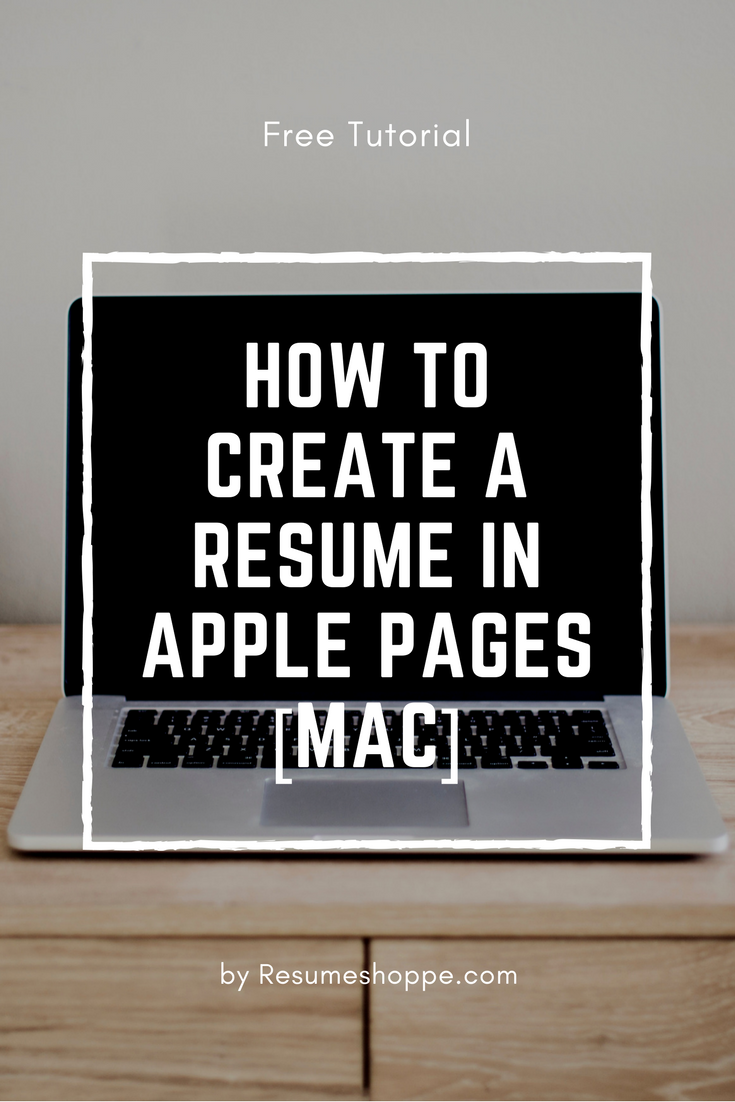
This post is dedicated to Mac users who wants to make their own resume with Apple’s word processing software – Pages.
Rather take a professionally crafted template? Click here and get your template for under $10.
Difficulty Level: Beginner Requirements: Any Mac operating system with Apple Pages installed
Before we begin, we would like you to know that this tutorial is made on a Macbook Pro running Mac OS X El Capitan (version 10.11.6), with the assistance of Apple Pages (version 5.0.1). If you are using the latest Mac OS – High Sierra, there would be slight difference in terms of user interface, but in general most features in Pages would work the same way.

Step 1: Launch Pages from Applications
Open the Apple Pages app located in your Applications folder. You will be greeted with the following window. If you don’t see this window, go to your top menu bar and select File > New… (or use the shortcut Cmd+N).
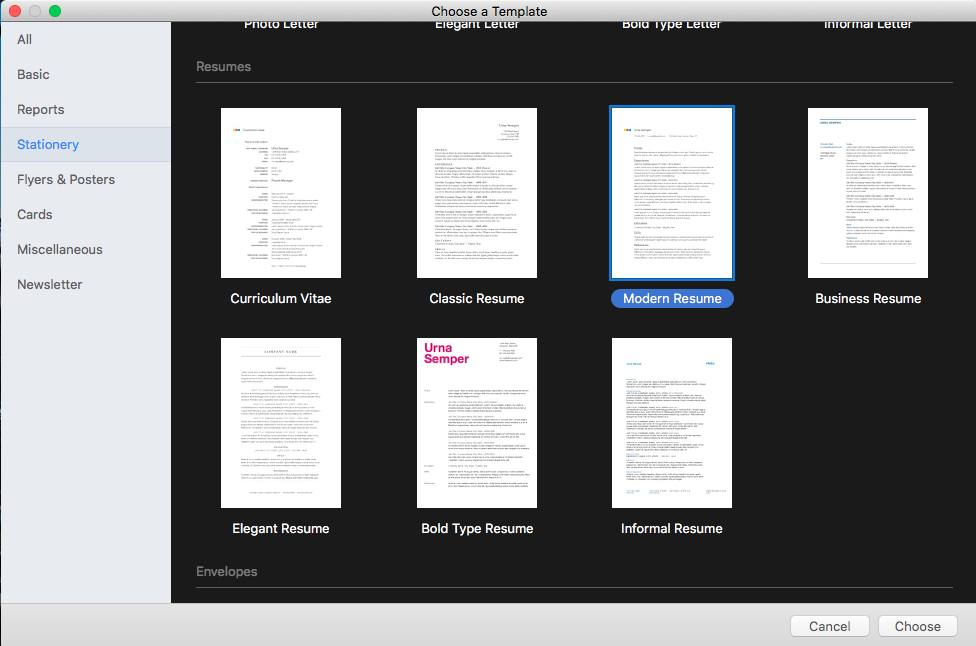
At the left sidebar, navigate to the Stationery tab, scroll down to the Resume section at the main column, then pick a resume template that you like. We selected the Modern Resume template for this guide.
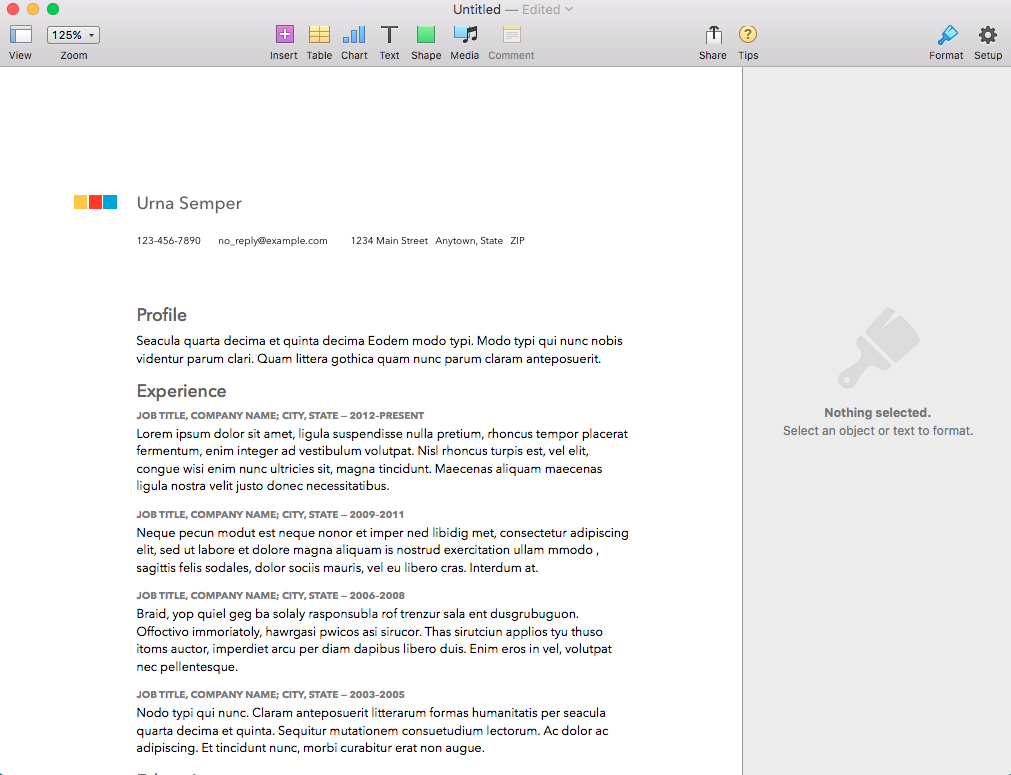
Step 2: Replace the Resume with Your Details
By default, the Pages template is pre-populated with dummy info. Go ahead and replace all the dummy details with your own information. If you need help with your resume’s content, check out the resume writing service offered by our professional resume writers.
For starters, you can remove categories you don’t need by selecting it and hit on the Delete key. To add more categories such as Awards (or Accomplishments), the best way is to copy and paste from another category to retain its formatting.
One downside to this template is that it lists out your work experience as a chunk of long-winding paragraphs. Ideally you would want to avoid doing this as recruiters can be put off by it.

If you had an extensive job scope for your previous job, split them up using bullet points. To add bullet points in Pages, go to the Bullets & Lists feature located at the right sidebar, then click on the dropdown option next to it and select Bullet .
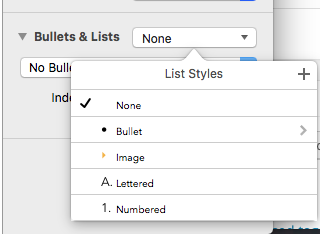
You can also adjust the spacing between lines and paragraphs by changing the values here:
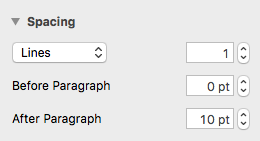
Here’s how our sample resume looks like after replacing the contents with that of a fictional person:
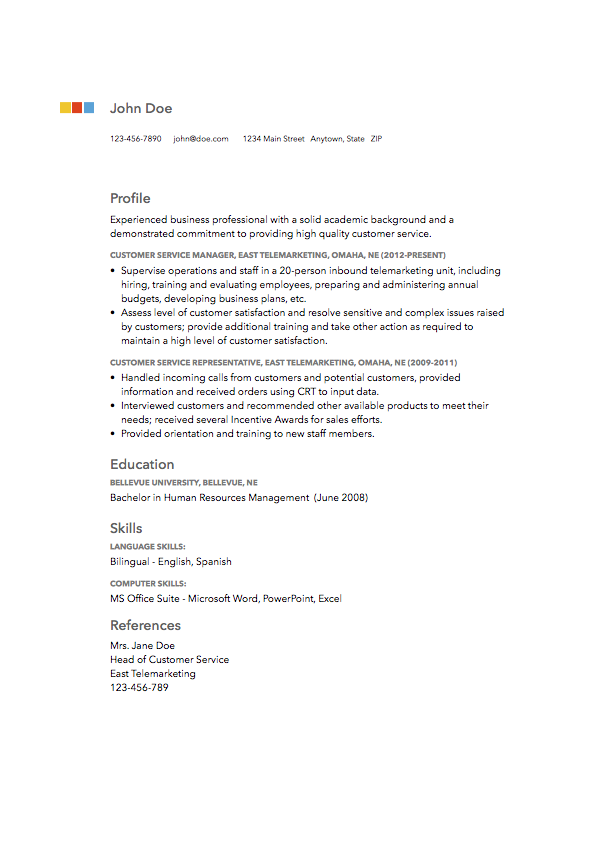
Step 3 (optional): Change fonts and colors to match your style
This modern resume template from Apple Pages uses Avenir Next as the default font. If you are feeling adventurous, you could also play around with different font styles.
We switched up the Headings and Subheadings with a serif font – Baskerville. We also removed the squares next to the name as it do not add any real value to the resume.
Here’s how our final sample resume looks in Pages:
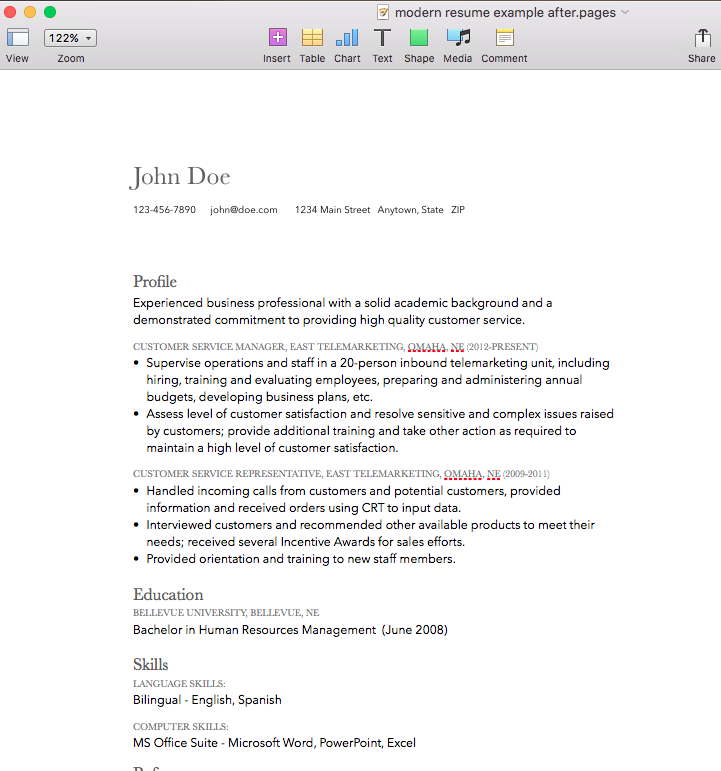
Step 4: Save and Export Resume
Done? Double check your resume for spelling and grammatical errors. Pro tip: read your resume out loud to spot obvious mistakes such as the misuse of “then” or “than”, “your” or “you’re” etc.
If everything is correct, click on Command+S (shortcut for Save) on your keyboard to save your Pages file or go to File > Save… .
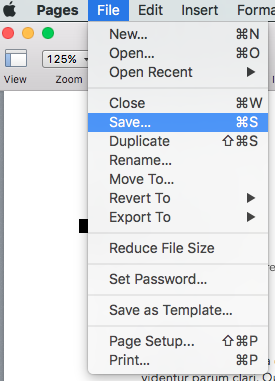
Since you might be using this resume to apply for jobs (we hope), go to top menu again and select File > Export to > PDF… in order to export the Pages file as PDF.
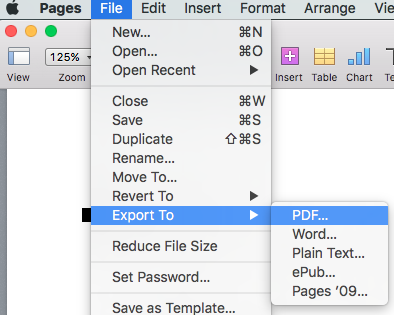
In the pop-up window, you can choose to have Good , Better , or Best image quality for your PDF export. We always go with the Best option so that the PDF looks good on print too.
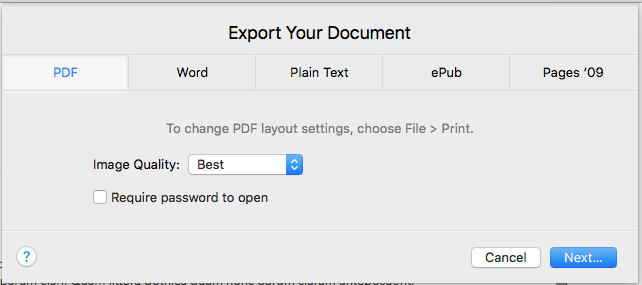
Congratulations! You are all set to deliver your homemade PDF resume to interviewers and hiring managers. We hope that you learned how to make your first resume on Mac using Apple Pages after reading this tutorial.
Looking for a one-of-a-kind resume template that can be edited in Apple Pages on your Mac? Below you’ll see one of our Pages templates..we have many more in our shop!
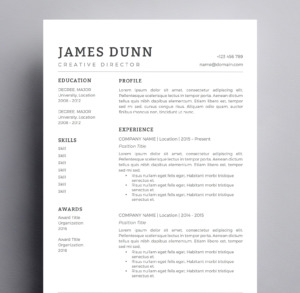
Rules of the Blog
Do not post violating content, tags like bold, italic and underline are allowed that means HTML can be used while commenting.
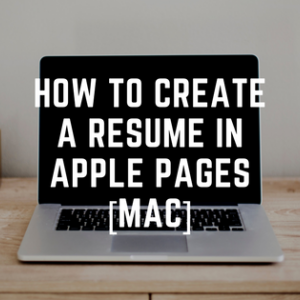
Top Selling Resumes
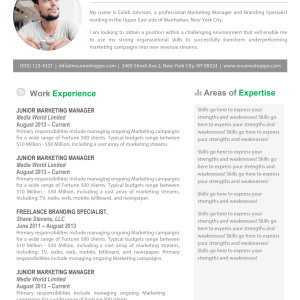
- Free Acting Resume Template Download [.docx]
- Why This Resume Got 5 out of 15 Callbacks [Resume Teardown]
- 10 Genius Answers to Interview Questions – and 3 Not so Genius
- Download a Free Infographic Resume! [No Strings Attached]
Advice Categories
- Free Downloads
- Linkedin Tips
- Mac Resume Templates
- Resume Tips
*IT'S SALE TIME!* All our templates now with huge discounts...Sale can end anytime!! Dismiss

Tips & Tricks
Troubleshooting, create a resume with pages on mac, iphone, ipad.
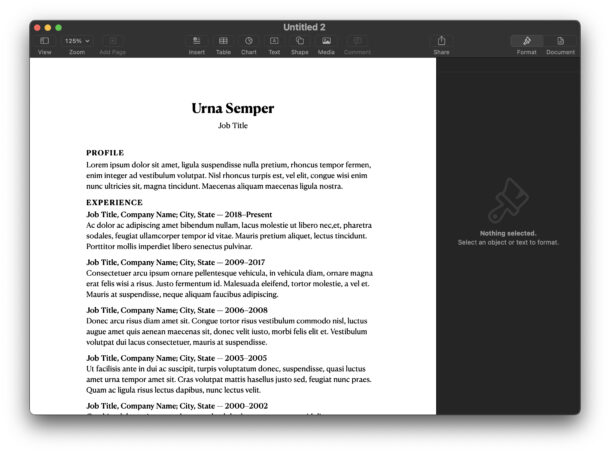
Creating a resume is one of those tasks that can be stressful, but it does not need to be if you’re in the Apple ecosystem. That’s because your iPhone, iPad, and Mac, all have a readily accessible series of resume templates that you can access.
Whether it’s updating a resume into a new format, or creating an entirely new resume, we’ll show you how you can easily make a resume on Mac, iPhone, or iPad, by using the bundled Pages app.
If you don’t have Pages yet, you will need to download it to your device free from Apple. You’ll find it at the App Store for iPhone, iPad here , or Mac here . You’ll be able to sync your Pages documents, including the resume, across any of your devices using the same Apple ID.
How to Create a Resume in Pages for Mac, iPad, iPhone from a Resume Template
Pages functions mostly the same whether it’s being used in macOS, iOS, or iPadOS:
- Create a New Document
- Scroll down to the “Resumes” section and select the resume type you wish to create (we chose Classic Resume for this example)
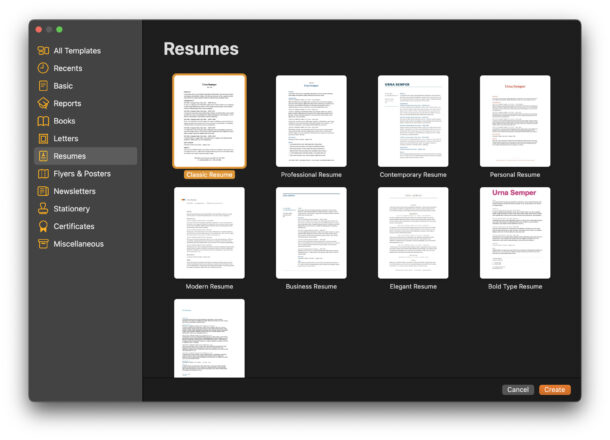
- Fill out the resume with your information, including name, job position and experience information, education information, the standard resume fair
Once finished creating the resume, you can print it out, save it as a Pages file, save it as a DOCX file, save it as a PDF , or whatever else you’d like to do with it.
Whether you’re hunting for a job, getting ready to apply for a first job, or preparing to get back into the job market, having a nice, easy to read, and professional looking resume can make a difference. There’s no need to be intimidated by creating a resume, with the Resume Pages template, you can simply just plug in your resume information, and you’ll be finished in no time.
Looking beyond resumes, the entire iWork suite is fantastic, and each of the office suite apps offers handy templates for all sorts of personal and life tasks, whether you’re making a resume like we discuss here, setting up a budget spreadsheet , using a net worth tracker , creating a picture book, or so much more.
Have you ever created a resume from the free templates that come with the Pages app on iPhone, iPad, and Mac? What do you think of these features? Share your thoughts in the comments.
Enjoy this tip? Subscribe to our newsletter!
Get more of our great Apple tips, tricks, and important news delivered to your inbox with the OSXDaily newsletter.
You have successfully joined our subscriber list.
Related articles:
- How to Export Pages as Word on iPhone & iPad
- How to Convert Pages to Word on Mac
- Disable Resume for Safari or Other Specific Applications in Mac OS X Lion
- How to Highlight in Pages for Mac
One Comment
» Comments RSS Feed
Hello. Please note that the word RÉSUMÉ is French and requires two accents to differentiate it from the non-French word resume, which has a totally different meaning.
Leave a Reply
Name (required)
Mail (will not be published) (required)
Subscribe to OSXDaily
- - 7 Helpful Uses of AirTags, from Pets to Packages
- - How to Use Window Tiling in MacOS Sequoia
- - How to Find a Lost Apple Pencil
- - Fix iOS 18 Bluetooth Connection Problems
- - Why is Wi-Fi Turning On By Itself on iPhone?
- - Have an Old iPhone or iPad? iCloud Backups & Safari Bookmark Syncing Will Soon Not Work
- - Beta 4 of iOS 18.2, iPadOS 18.2, MacOS Sequoia 15.2, Available for Testing
- - iOS 18.1.1 & iPadOS 18.1.1 Security Updates Released
- - MacOS Sequoia 15.1.1 with Security Fixes Available Now
- - Beta 3 of iOS 18.2, iPadOS 18.2, MacOS Sequoia 15.2, Available for Testing
iPhone / iPad
- - Notes Disappeared from iPhone or iPad? Here’s How to Fix Missing iCloud Notes
- - How to Turn Off Bluetooth in iOS 18 on iPhone
- - How to Fix Spotlight Search Issues on MacOS Sequoia
- - How to Turn Off Find My Mac
- - How to Install Windows 11 on Mac with UTM

About OSXDaily | Contact Us | Privacy Policy | Sitemap
This website is unrelated to Apple Inc
All trademarks and copyrights on this website are property of their respective owners.
© 2024 OS X Daily. All Rights Reserved. Reproduction without explicit permission is prohibited.
Resume templates
Put your best qualities on display with professional, customizable resume and cv templates. no matter your line of work or length of professional history, you'll find resume and cv templates that'll help you get the gig..
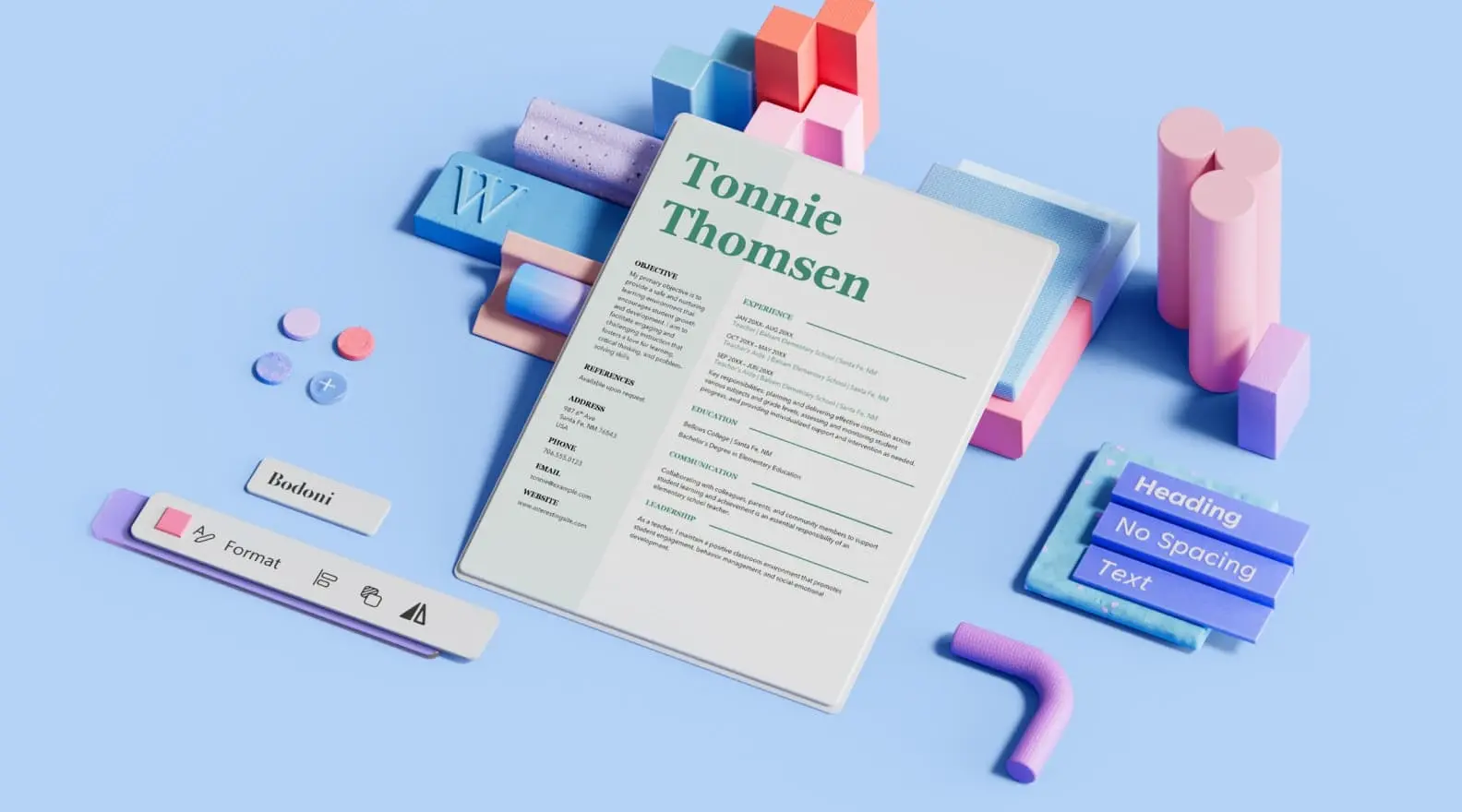
Download free resume templates
Land your dream job with free, customizable resume templates. Showcase your potential to recruiters and stand out from other candidates with a professional template. Whether you're applying to corporate positions or creative roles, go with a sleek design or show your creativity with bold colors .
Resumes don't need to look boring—add flair to your professional experience with a creative resume template. There are plenty of resume designs to choose from, like simple resume templates and modern resume templates. Each resume template is fully customizable in Microsoft Word , so you can personalize each design element and add your own text. Using a template also makes it easier to customize your resume for each position you apply to.
Print out as many copies as you'd like or download the template for free to share digitally when applying online. These professional resume templates are perfect for any stage of life or career. Whether you're a high school student, actor, or seeking a career in nursing, you can find any format for any job type.
There are also a variety of free CV (Curriculum Vitae) templates to choose from. A CV is often longer than a resume and contains an in-depth look at your education and professional accomplishments. Like our resume templates, these CV templates are also customizable in Word.
Remember, your next job is only a template away! Once you've customized your resume, explore free cover letter templates to help you land the job.
Resumonk Blog
Resume writing tips & career advice.
- Resumonk – Home
- Blog – Home
- Resume Writing Tips
- Career Tips
- Free Resume Writing eBook
- 11.23.24 How To Tailor Resume To Job Description (7 Tips With Example)
- 11.22.24 How To Shorten Resume Without Losing Valuable Information (With Templates)
- 11.21.24 How to Fix My Resume and Improve It Before a Job Search
- 10.31.24 A Complete Guide On How To Write A One-Page Resume (With Templates)
- 10.30.24 How Long is a Resume Supposed To Be? 10 Tips For the Right Length
- 10.29.24 How Should a Professional Resume Look In Terms Of Structure & Format?
- 10.29.24 Complete 4-step Guide on How to Use AI to Create a Resume (& 24 Timeless Tips)
- 09.06.24 The Ultimate AI Resume Toolkit: Resources, Templates, and Tools for Job Seekers
- 09.02.24 AI in Recruitment: What Every HR Professional Needs to Know
- 04.23.24 Utilizing AI Resume Builders for Job Applications: Dos and Don’ts
Popular Posts
- How to Fix My Resume and Improve It Before a Job Search
- How To Shorten Resume Without Losing Valuable Information (With Templates)
- 35 Most Common Interview Questions and How to Answer Them
- Fresher Resume
- How To Write A Resume
- Product Updates
Subscribe via Email
Join the others who've found our articles helpful! Get exclusive resume writing tips, sample resumes and career advice delivered to your inbox.
Email Address
A Complete Guide On How To Write A One-Page Resume (With Templates)

Imagine being surrounded by potential employers and industry professionals at a networking event. In your hand, you have your one-page resume, your career story condensed and curated to perfection. As you hand it to someone, you see them scan it, nodding in appreciation, and you feel a thrill of satisfaction. That’s the power of a one-page resume. It’s your career at a glance, a concise and compelling snapshot of who you are and what you bring to the table. Hiring managers don’t have time to sift through pages of information. They want to know, at a glance, if you’re the right person for the job. A one-page resume can make all the difference in getting noticed and landing an interview.
This guide will equip you with the knowledge and skills on how to use AI to create a resume that showcases your unique strengths and achievements. Resumonk’s AI Resume Builder can make this task a lot easier.
Does a CV Need to Be One Page?
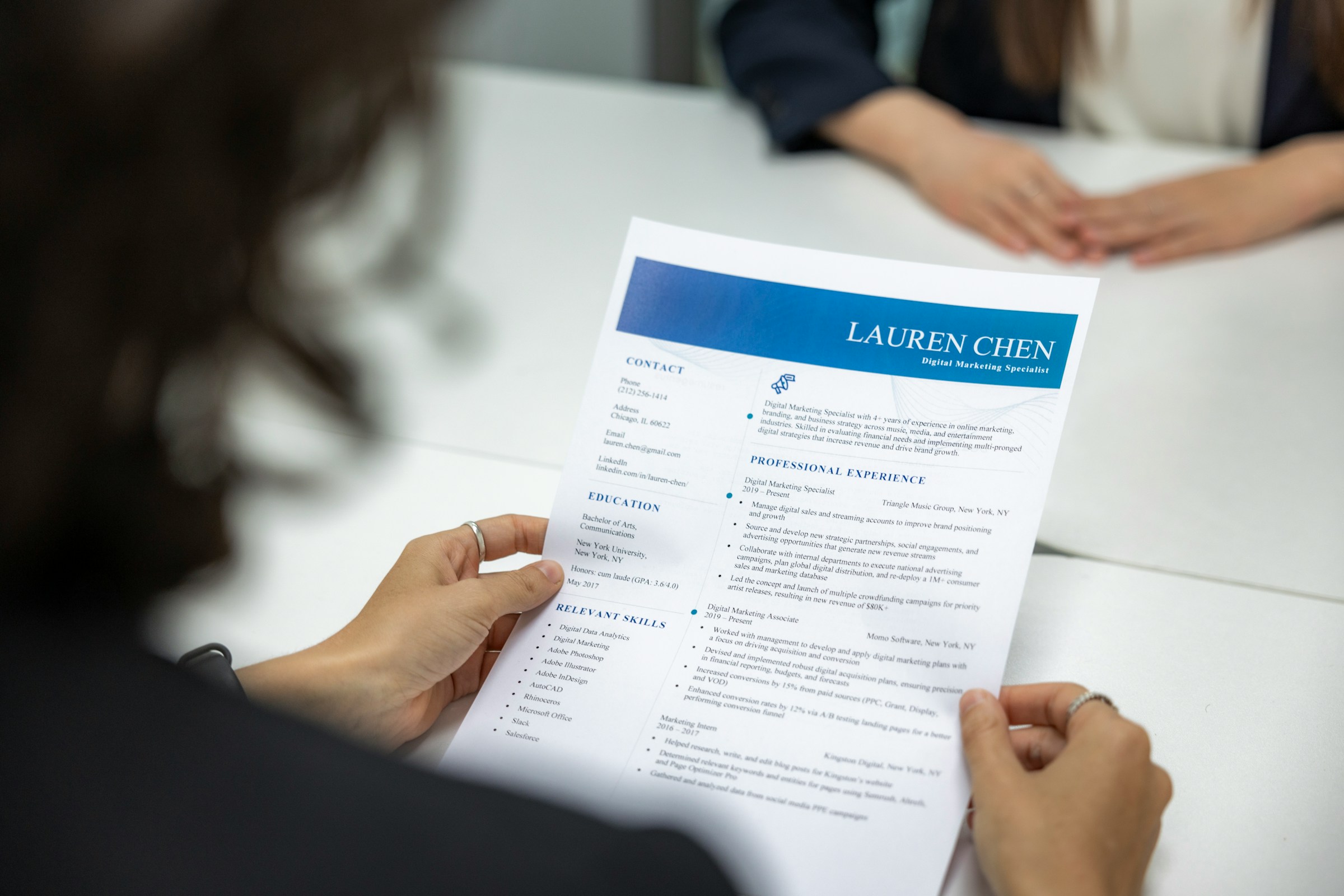
Should your resume be one page or two ? In most cases, one page is the way to go. If you have less than 10 years of relevant experience, you can fit everything you need to convey onto a single page. A two-page resume might be necessary if you have a decade or more of experience and many accomplishments to highlight. It’s all about making the most of your space and ensuring that every word counts.
Resume Length: How Many Pages You Need
The length of your resume will depend on your work experience and the industry in which you work. To figure out the best approach for you, review the list below of resume lengths for some common scenarios.
One-Page Resumes
The most common length for resumes is one full page. This length is especially well-suited for anyone with one to ten years of relevant work experience, including current or recent college graduates.
Career switchers might consider using a single-page resume instead of a two-page one, even if they have over a decade of work experience if some of their previous experience is irrelevant to the job. One-page resumes remain a standard length that will fit many use cases, particularly early-career professionals.
Two-Page Resumes
In the past, most resumes were expected to be only one page. Some professionals argue that two-page resumes are preferable because they allow job seekers to include more keywords that automated systems might recognize in their resumes. When in doubt, err on the more focused and shorter resume.
Benefits of Using a Two-Page Resume for Mid-Career Professionals
Two-page resumes are becoming increasingly common, particularly as electronic resumes replace paper ones. Hiring managers can easily scroll through resumes digitally rather than thumbing through a physical stack on their desks, making a two-page resume a less daunting prospect.
Two-page resumes are good for those with enough experience to fill both pages. Two-page resumes are best suited to mid-career professionals with 10-15 years of relevant experience applying to leadership positions within an organization.
Three-Page (Or More) Resumes
You should only submit a three-page resume if you meet a specific set of criteria or the industry in which you work specifically asks for resumes of this length.
Three-page resumes or longer are reserved for researchers, who often have lengthy resumes or CVs due to long lists of citations for published work. Mid-to-late-stage professionals with 15+ years of experience who are applying to senior-level positions may also find that a three-page resume is required to highlight their work experience and accomplishments adequately.
What are The Benefits of a One Page CV?

The Power of Simplicity: Crafting Your One-Page Resume
You’ve got a hiring manager with a stack of resumes in front of them. They’re scanning each one, searching for the perfect candidate. Imagine your resume lean, mean, and right to the point. That’s the beauty of a one-page resume. In a world where attention spans are shrinking, this format ensures that every word on your resume counts.
It’s about getting straight to the point and showcasing your top skills and experiences without fluff. By keeping it concise, you’re helping the hiring manager quickly grasp what you bring. It’s like a handshake brief, firm and meaningful, leaving no room for confusion or filler.
Create Lasting Impressions with Your One-Page Resume
Let’s talk about being memorable. A one-page resume is your secret weapon when you want to leave a lasting impression on hiring managers. When they reflect on all the resumes they’ve received, yours stands out because it’s focused and impactful. It’s easy to remember.
This can work wonders in ensuring you’re not just another applicant but a candidate they’re genuinely interested in. A well-organized, concise resume has the power to stay in their minds, increasing the likelihood of you getting that interview call. It’s about making hiring managers remember you and want to interview you.
How a One-Page Resume Shows Your Prioritization Skills
Creating a one-page resume isn’t just about saving space; it’s a skill that demonstrates your ability to prioritize. When you’re limited to one page, carefully select which experiences and achievements to include. This means you must prioritize what’s most relevant to the job you’re applying for.
You’re showcasing your experiences and proving that you can focus on what truly matters. It’s a skill that employers value in any professional setting. It’s about showing you know how to set priorities and focus on the most important.
Efficiency Speaks Volumes: The ‘Less is More’ Approach in Competitive Fields
Competitive industries are like fast-moving trains. If you want to hop on, you’ve got to be quick and efficient. A one-page resume helps you communicate your value without any extra baggage. It’s about confidently presenting your most valuable skills and experiences.
You project an image of efficiency, which is greatly appreciated in fast-paced environments. It’s about showing that you can keep up with the industry’s demands and have the confidence to highlight your expertise. In competitive fields, efficiency is key; your one-page resume helps you convey just that.
One-Page Resumes: Making it Easy for Employers to Navigate
Hiring managers don’t have time to read long resumes. They seek specific information, like:
- your latest job title
A one-page resume makes it incredibly easy to find what they need. Everything’s right there, on one page.
There is no need to flip through multiple sheets. This ease of navigation makes your resume more user-friendly, which hiring managers appreciate. It’s about making their job easier and ensuring they don’t miss any crucial details about your qualifications.
Writing with Impact: How a One-Page Resume Encourages Strong Writing
Crafting a one-page resume requires concise, impactful language. Since you have limited space, you must communicate your value effectively. This means writing every accomplishment and experience clearly and compellingly.
Employers highly value the ability to write concisely, especially in positions that require effective communication.
Leave Them Wanting More: The Art of Intrigue with a One-Page Resume
A one-page resume captures the most critical aspects of your professional journey without revealing everything. It’s like a teaser of your qualifications. If you’ve piqued the hiring manager’s interest, they will likely have follow-up questions during an interview.
This allows you to expand on your achievements and experiences, adding depth to your candidacy. It’s about creating a sense of intrigue and leaving them wanting to know more about you. Elevate Your Resume with Resumonk
Ready to create a resume that truly stands out? Resumonk’s professional resume templates are here to help. With smart AI rewriting and suggestions, plus 20 premium templates, you can easily craft an impressive resume .
How to Write a One-Page Resume

Zero in on Key Accomplishments
Imagine you’re trying to impress someone at a party. You wouldn’t just list everything you’ve ever done, right? You’d focus on the stories that show who you are. Your resume is no different. You might have a lot of achievements, but you only have limited space to show your best to your potential employer.
Focus on each role’s two or three most impressive accomplishments. Make sure they’re directly relevant to the job you’re applying for, and cut anything redundant. This will keep your one-page resume clean, concise, and impactful.
Tailor Your Resume to the Position
Applying for multiple jobs with the same resume can feel productive but counterproductive. Each time you send your resume, it should be tailored to fit the:
- Experiences
- Requirement
Be Selective with Content
To create a one-page resume, you must be brutally selective with your content. Carefully review your:
- Accomplishments
Choose the most relevant experiences for the job you’re applying to. Your content should be tailored to the job description and only address what the hiring manager or recruiter seeks. Even if it feels hard, eliminate irrelevant or outdated information to create space for more essential details.
Prioritize the Most Relevant Information
It’s also important to prioritize details within each section. For example, in the “ Work Experience ” section, only focus on accomplishments, projects, and responsibilities that demonstrate the skills and experiences most relevant to the job you’re applying for.
If you find yourself short on space in the “ Education ” section, focus on your highest level of education.
Cut Unnecessary Sections
Including volunteer work or interests on your resume can be helpful when you have limited work experience; they should be the first thing to go if you need to free up space for your work experience. You shouldn’t include references on your resume. Most employers don’t require references; others will ask to see your references later in the hiring process.
How to Easily Make a One-Page CV Without Reducing its Content
There are several ways to shorten your resume length on Resumonk apart from reducing the content.
- You can change the page size for your resume PDF.
- You can use the smallest spacing setting for your resume PDF.
- You can try reducing the PDF page margins .
All these options are available on the ‘ Preview & Download’ tab.
What Not to Include on a One-Page Resume

Objective Statements: Say Goodbye
Let’s address the elephant in the room: objective statements. They’re outdated. Instead of cluttering your resume with a generic objective, switch to a concise summary that highlights your skills and aligns with the job you’re after. This approach packs a punch and catches the eye faster.
Outdated Skills: Don’t Be Stuck in the Past
Nobody needs to know you can use Microsoft Word or browse the internet. Those are baseline skills we all possess. Trade them out for relevant technical skills or niche software expertise. Tailor your skills to match the job description, making your resume stand out.
Long Descriptions for Minor Roles: Keep It Short and Sweet
If you’ve held positions unrelated to your target job, don’t waste valuable space detailing them. Opt for summaries or omit them altogether. This focused approach leaves room to highlight experiences that matter.
Full Mailing Address: Skip the Snail Mail
Gone are the days when your complete mailing address was included on your resume. For privacy and efficiency, stick to just your city and state. This change reflects modern resume standards and saves space.
Excessive Formatting or Graphics: Keep It Clean
A clean, professional format beats unique graphics, colors, or elaborate fonts. Opt for a simple, easy-to-read design that lets your content shine through. This makes your resume more accessible and appealing to employers.
Salary Expectations: Don’t Be Premature
Your resume isn’t the place to discuss salary expectations. These conversations are better left for interviews, where you can gauge the employer’s interest. Including them on your resume can come off as presumptive and may even hurt your chances.
Jargon and Clichés: Skip the Buzzwords
Steer clear of overused phrases like “ team player ” or “ hard worker .” These clichés don’t add value to your resume. Highlight your quantifiable achievements to demonstrate your abilities directly.
Get An Interview for Your Dream Job with Ease with Resumonk
Your resume needs to grab attention immediately in job applications. Resumonk is an AI-powered resume builder that streamlines this process. Imagine having a tool that helps you create stunning resumes and optimizes each entry with smart AI rewriting and suggestions. Resumonk offers 20 premium resume templates and matching cover letters, ensuring your application stands out visually and content-wise.
Resumonk simplifies the often tedious task of resume creation with features like:
- LinkedIn profile importing
- Existing resume uploads
- Multiple resume management
Whether you’re a detail-oriented job seeker, a student, or a seasoned professional, our intuitive platform transforms resume building into an intelligent and seamless experience.
Related Posts:

Published by Team Resumonk
- Category Resume Writing Tips
- Share Twitter Facebook Google+
Apple Intelligence is now available on iPhone, iPad, and Mac!
⏺ Join the discussion
⏺ Press release
⏺ Learn more
⏺ Watch the video
Looks like no one’s replied in a while. To start the conversation again, simply ask a new question.
Using Pages to create a resume
I am looking for tips on how to create a resume in pages. Are the templates good?
Posted on Mar 16, 2021 11:39 AM
Similar questions
- How do I get a resume template in pages How do I get a resume template in pages 300 1
- How do i save a resume in pages as a doc/pdf? How do I save a resume in Pages as a doc/pdf? 927 2
- Can't edit my resume in/with Pages How to edit my resume in/with Pages 3068 1
Loading page content
Page content loaded
Mar 17, 2021 8:11 AM in response to BDAqua
I am wondering if many people use pages for resumes. I found these when search Safari as well.
There is not much out there!
Mar 16, 2021 12:22 PM in response to SSS215
Here's how...
https://www.resumeshoppe.com/how-to-create-resume-apple-pages/
https://www.template.net/tutorials/create-a-resume-on-a-mac/
Mar 16, 2021 12:37 PM in response to SSS215
Mar 16, 2021 9:00 PM in response to SSS215
You're welcome, take care & good luck my friend! :)
Mar 17, 2021 8:16 AM in response to SSS215
I would say not many, most probably use Word or LibreOffice, & directions...
https://www.thebalancecareers.com/blank-resume-form-to-create-your-own-resume-2063590
How to Make a Resume in 2024 | Beginner's Guide

For most job-seekers, a good resume is what stands between a dream job and Choice D. Get your resume right, and you’ll be getting replies from every other company you apply to.
If your resume game is weak, though, you’ll end up sitting around for weeks, maybe even months, before you even get a single response.
So you’re probably wondering how you can write a resume that gets you an interview straight up.
Well, you’ve come to the right place!
In this guide, we’re going to teach you everything you need to know about how to make a resume, including:
- The 8 Essential Steps to Writing a Resume
- 11+ Exclusive Resume Tips to Up Your Resume Game
- 27+ Real-Life Resume Examples for Different Professions
….and more!
So, let’s dive right in.
How to Make a Resume (The Right Way!)
Before we go into detail about how you should make a resume, here’s a summary of the most important steps and tips to keep in mind:
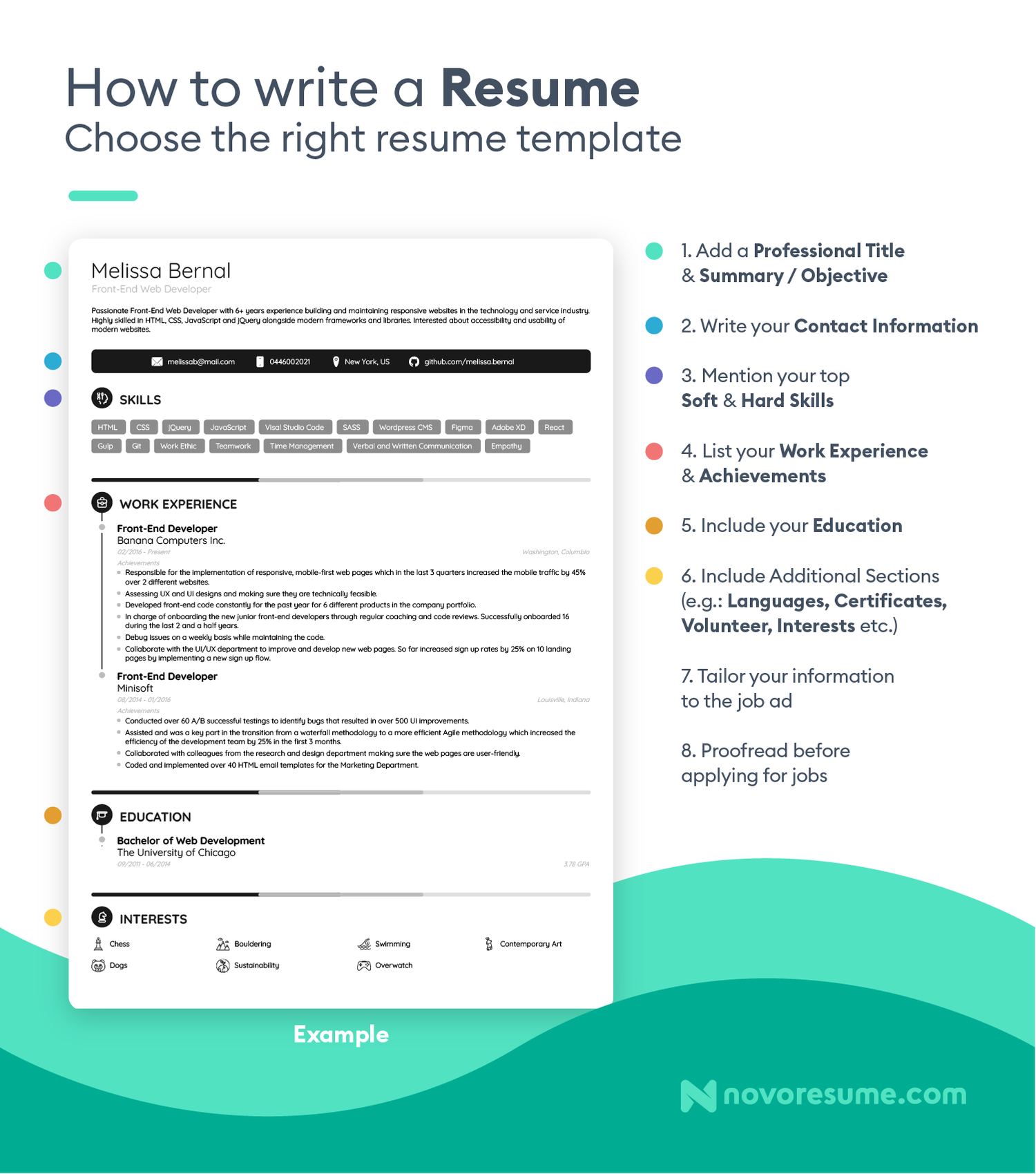
- Choose a resume format carefully. In 99% of cases, we recommend the reverse-chronological format .
- Add the right contact details. Leave your headshot out and make sure to include your job title , a professional email address, and any relevant links. (E.g.: your LinkedIn profile , online portfolio, personal website, etc.).
- Write an impactful resume summary. Unless you’re an entry-level professional, always go for a resume summary. If you do it right, it’s your chance to get the hiring manager to go through the rest of your resume in detail.
- Pay attention to your work experience section. Take your work experience section from OK-ish to exceptional by tailoring it to the job ad, making your achievements quantifiable, and using action verbs and power words.
- Add the right skills for the job. Keep this section relevant by only including the hard and soft skills that are required for the position.
- Keep your education short and to the point. Your most recent and highest degree is more than enough for a strong education section. You only need to add more details here if you’re a recent graduate with barely any work experience.
- Leverage optional resume sections. Optional sections like languages, hobbies, certifications, independent projects, and others can set you apart from other candidates with similar skills and experience.
- Include a cover letter. That’s right, cover letters matter in 2024, and the best way to supplement your resume is by adding an equally well-crafted cover letter to your job application. To make the most of it, check out our detailed guide on how to write a cover letter .
To get the most out of our tips, you can head over to the resume builder and start building your resume on the go as you read this guide.
New to resume-making? Give our ‘7 Resume Tips’ video a watch before diving into the article!
#1. Pick the Right Resume Format
Before you start filling in the contents of your resume, you have to make sure it’s going to look good.
After all, the first thing hiring managers notice is what your resume looks like, and then they start reading it. So, this is your best chance to make a great first impression.
Start by choosing the right resume format.
There are three types of resume formats out there:
- Reverse-chronological. This is by far the most popular resume format worldwide and, as such, it’s the best format for most job-seekers.
- Functional. This resume format focuses more on skills than work experience. It’s a good choice if you’re just getting started with your career and have little to no experience in the field.
- Combination. The combination resume format is a great choice for experienced job-seekers with a very diverse skill set. It’s useful if you’re applying for a role that requires expertise in several different fields and you want to show all that in your resume.
So, which one should you go for?
In 99% of cases, you want to stick to the reverse-chronological resume format . It’s the most popular format and what hiring managers expect to see. So, in the rest of this guide, we’re going to focus on teaching you how to make a reverse-chronological resume.
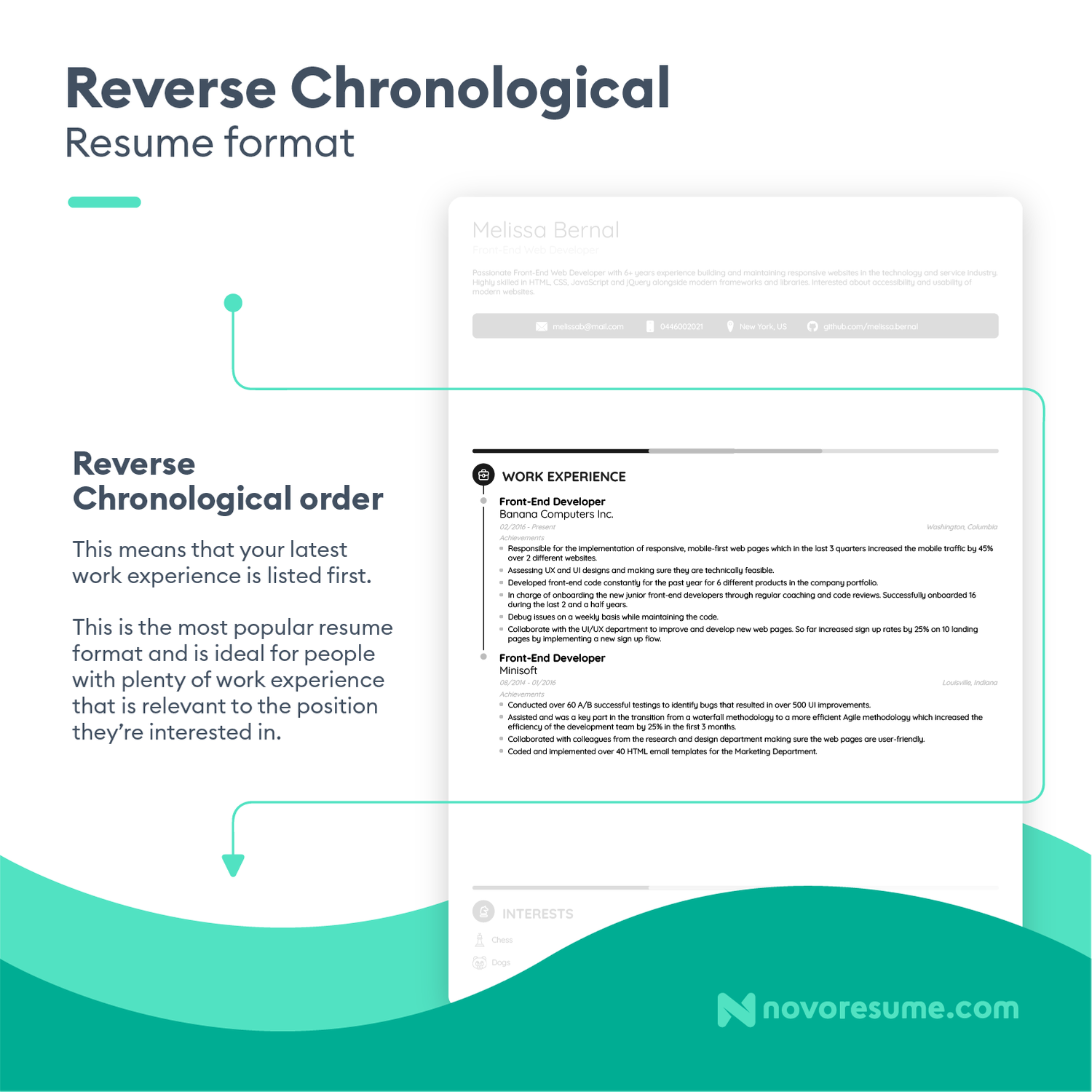
Fix Your Resume’s Layout
With formatting out of the way, let’s talk about your resume’s layout , which determines the overall look of your resume.
Does it look organized or cluttered? Is it too short or too long? Is it boring and easy to ignore, or is it reader-friendly and attention-grabbing?
Here are some of the best practices you should apply:
- Stick to one page. You should only go for a two-page resume if you have decades of experience and you’re sure the extra space will add significant value. Hiring managers in big companies get hundreds of applications per job opening. They’re not going to spend their valuable time reading your life story!
- Add clear section headings. Pick a heading and use it for all the section headers so the hiring manager can easily navigate through your resume.
- Adjust the margins. Without the right amount of white space, your resume will end up looking overcrowded with information. Set your margins to one inch on all sides so your text fits just right on the page.
- Choose a professional font. We’d recommend sticking to a font that’s professional but not overused. For example, Ubuntu, Roboto, or Overpass. Avoid Times New Roman, and never use Comic Sans.
- Set the correct font size. As a rule of thumb, go for 11-12 pt for normal text and 14-16 pt for section titles.
- Use a PDF file. Always save your resume as a PDF file, unless the employer specifically requests otherwise. Word files are popular, but there’s a good chance they’ll mess up your resume’s formatting.
Another thing you need to consider in terms of your resume’s layout is whether you’re going for a traditional-looking resume template or something a bit more modern :
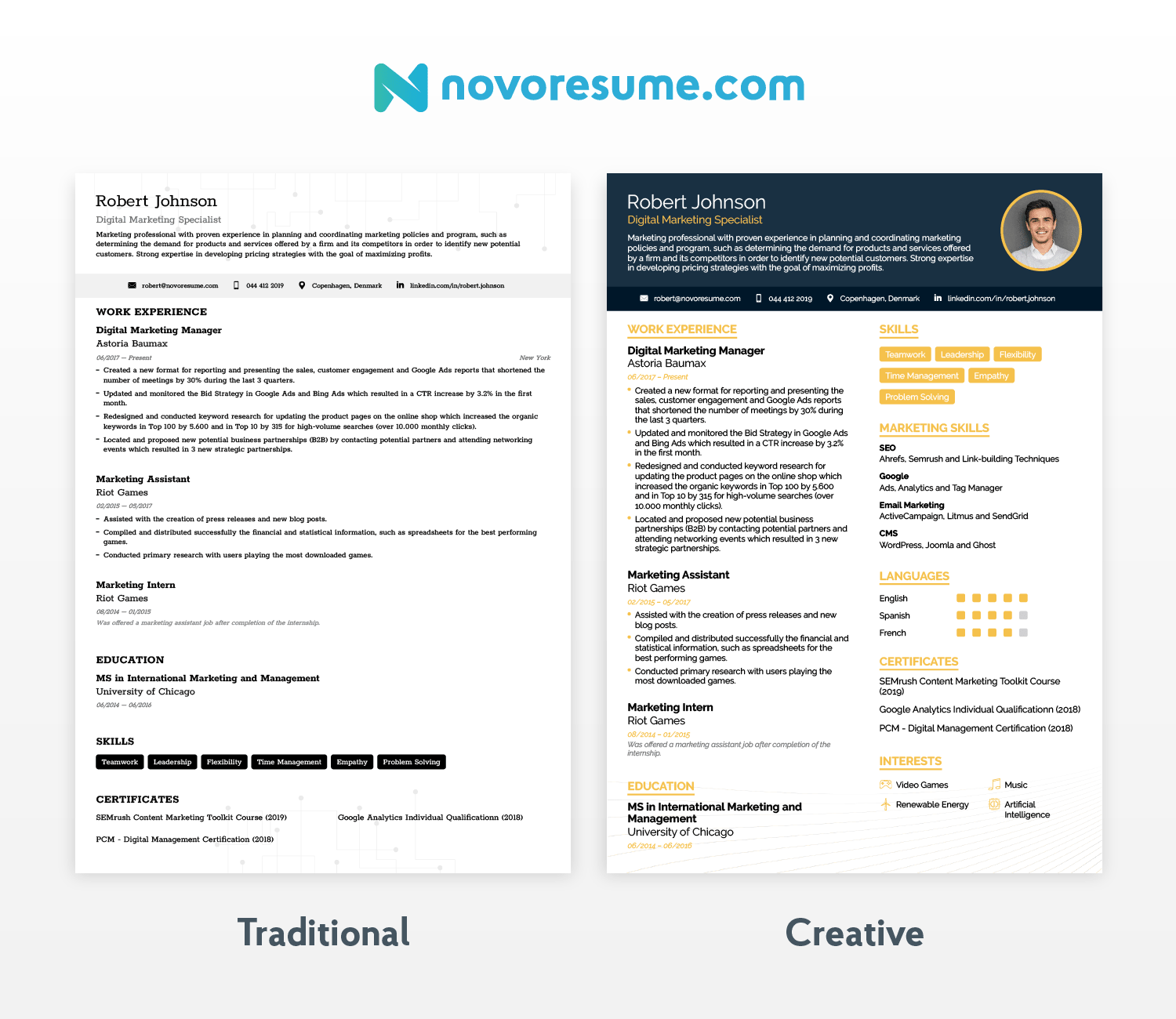
If you’re pursuing a career in a more traditional industry, like law , banking , or finance , you might want to stick to the first.
But if you’re applying to a tech company where imagination and innovation are valued, you can pick a more creative resume template .
Want to Save Time? Use a (Free) Resume Template
Anyone who’s ever tried creating a resume from scratch knows how boring the formatting can be.
Before you can even start filling in the contents, you need to tweak the margins, adjust font sizes, and make sure everything fits into one page while still looking good.
What if you could skip past all that and still create a compelling resume?
Try one of our free resume templates . They’re pre-formatted, so all you have to do is fill in the contents.
They’re also created in collaboration with recruiters from around the globe, ensuring that the templates are visually appealing and ATS-friendly!
See for yourself how one of our templates compares to a resume created in a standard text editor:


#2. Add Your Contact Information
Now that we’ve got all the formatting out of the way, let’s get into what your resume is all about— the information you put on it .
The first thing you want to do when filling out the contents of your resume is to add your contact information .
This section is pretty straightforward but crucial. Your contact details belong at the top of your resume in a designated resume header , so the hiring manager can easily find them.
Even if everything else about your resume is perfect, that all flops if you misspell your email address or have a typo in your phone number. If the hiring manager can’t contact you, it’s a missed opportunity.
So, double-check, and even triple-check your contact information section and make sure everything is factually correct and up-to-date.
Must-Have Information
- Full name. Your first and last name should stand out at the top of your resume.
- Email address. Stick to an address that’s professional and easy to spell, like a combination of your first and last name. (E.g.: [email protected])
- Phone number. Add a reliable number where the hiring manager can easily reach you.
- Location. Add your city and state/country. If you plan to relocate for the job or want a remote position, specify it on your resume.
Optional Information
- Job title. Add your professional title underneath. Write it down word for word, whether it’s “Digital Marketing Specialist” or “Junior Data Scientist.” Just don’t make up job titles like “Marketing Wizzard” or “Data Manipulator.” They’re not quirky; they’re just unprofessional.
- LinkedIn profile . We recommend that you include a link to your updated LinkedIn profile since over 77% of hiring managers use the platform when evaluating a candidate.
- Relevant links. Include links to personal websites or any social media profiles that are relevant to your field. For example, a developer could include a Github profile, while a graphic designer could link their Behance or Driblle account, and so on.
- Date of birth. Unless this is specifically required in the job ad, the hiring manager doesn’t need to know how old you are. It’s not important for their decision-making, and at worst, it might lead to age-based discrimination.
- Unprofessional email address. Your quirky, old high school email address doesn’t belong on your resume. Instead of [email protected] , go for a [email protected] type of address.
- Headshot. (USA, UK or Ireland) Depending on the country where you’re applying, it might even be illegal to include a picture of yourself on your resume . While it’s the norm to include a picture in most of Europe and Asia, always check the regulations for each specific country or industry you’re applying to.
All clear? Good! Now, let’s look at what a great example of a resume's contact information section looks like:
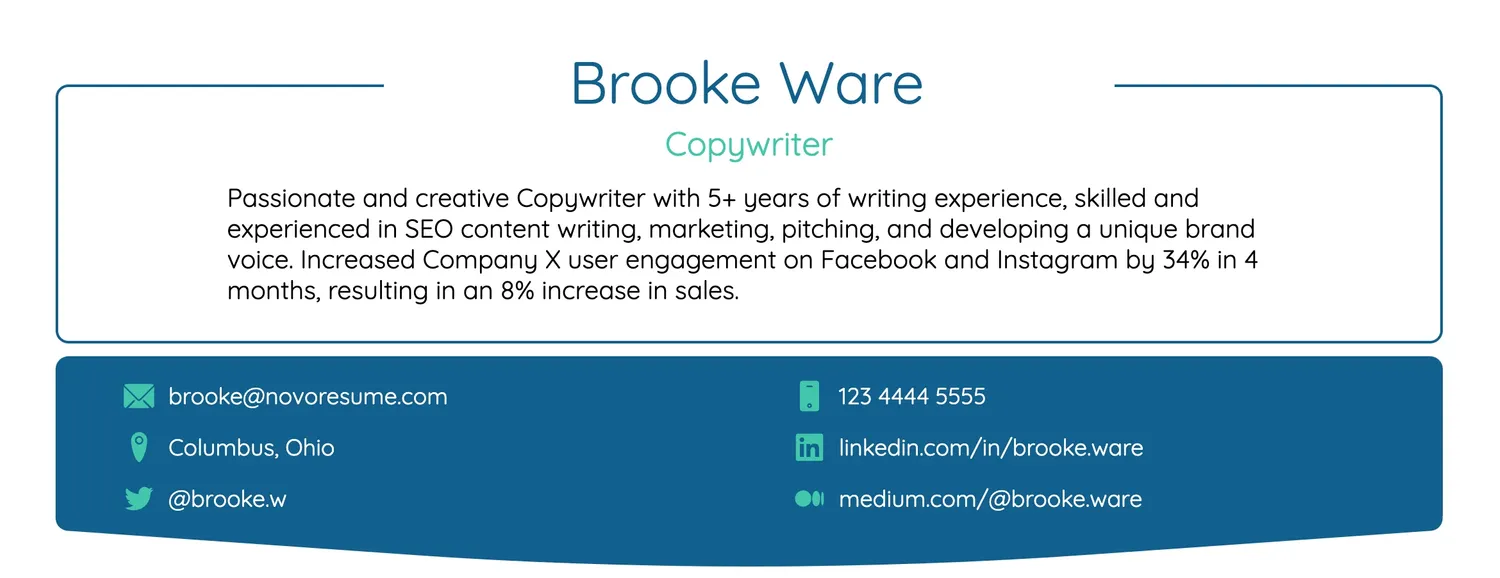
#3. Write a Resume Headline (Summary or Objective)
It's no secret that recruiters spend an average of less than seven seconds on a resume .
When you receive hundreds, if not thousands, of applications daily, it's physically impossible to spend too much time on each.
So, what the hiring managers do to go through resumes more effectively is to skim through each resume and read it in depth only if it piques their interest.
This is where the resume headline comes in.
Placed right next to (or underneath) your contact information, this brief paragraph is the first thing the hiring manager is going to read on your resume.
Now, depending on how far along in your career you are, your resume headline can be either a resume summary or a resume objective.

So, how do you choose between a resume summary and a resume objective? Here’s all you need to know:
Resume Summary
A resume summary, as the name suggests, is a two to three-sentence summary of your career so far. If done right, it shows that you’re a qualified candidate at a glance and gets the hiring manager to give you a chance.
Here’s what your resume summary should include:
- Your job title and years of experience.
- A couple of your greatest professional achievements or core responsibilities.
- Your most relevant skills for the job.
Here’s an example of a well-written resume summary:
Experienced Java Developer with 5 years of experience in building scalable and efficient applications. Contributed to a major project that enhanced application performance by 25%. Strong background in Spring Framework and microservices. Aiming to apply robust coding skills to develop innovative software solutions at XYZ Tech Solutions.
Unless you’re a recent graduate or amid a career change, we recommend you stick to a resume summary. Otherwise, a resume objective might be a better option for you.
Resume Objective
A resume objective is supposed to express your professional goals and aspirations, academic background, and any relevant skills you may have for the job.
It communicates your motivation for getting into a new field, so it’s the go-to headline for recent graduates and those going through a career change. As with a resume summary, a resume objective should be brief—around two to four sentences long.
So, here’s what it would look like if you’re a student:
Hard-working recent graduate with a B.A. in Graphic Design from New York State University seeking new opportunities. 3+ years of practical experience working with Adobe Illustrator and Photoshop, creating illustrations and UX/UI design projects. Looking to grow as a designer and perfect my art at XYZ Design Studio.
Or, on the other hand, if you’re going through a career change, it might look more like this:
IT project manager with 5+ years of experience in software development. Managed a team of developers to create products for several industries, such as FinTech and HR tech. Looking to leverage my experience in managing outsourced products as a Product Owner at Company XYZ.
#4. Prioritize Your Work Experience
The most important part of your resume is your work experience.
This is where you get to sell yourself and show off your previous accomplishments and responsibilities.
If you manage to master this section, you’ll know most of what’s there to know about how to make a resume.
There are plenty of good practices for writing your work experience . But before we dive into all the nits and grits, let's start with the basics.
The standard format for each work experience entry is as follows:
- Job title/position. Your job title goes on top of each work experience entry. When the hiring manager looks at your resume, you want them to know, at a glance, that you have relevant work experience for the job.
- Company name/location/description. Mention the name of the employer and the general location, such as the city and state/country where you worked. In some cases, you may also want to briefly describe the company, like when the organization isn’t particularly well-known.
- Dates employed. Add the approximate timeframe of your employment at each company. You don’t need to give exact dates since the standard format for this is mm/yyyy.
- Achievements and responsibilities. This is the core of each work experience entry. Depending on your field, you want to list either your achievements or responsibilities. List them in bullet points instead of paragraphs, so they’ll be easier to read.
Here’s a real-life example:
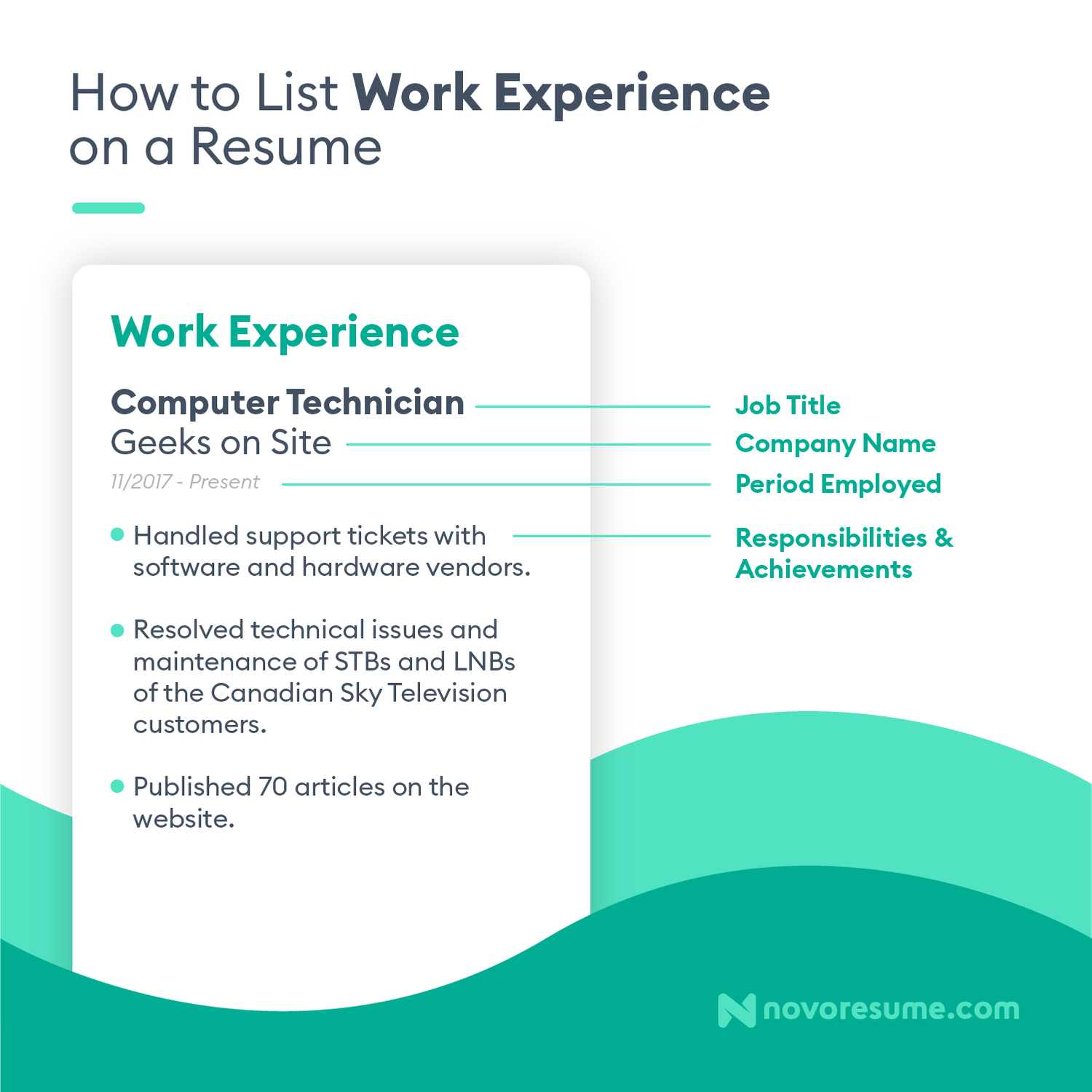
Your work experience entries should always be listed in reverse chronological order , starting with your most recent job and working your way back into the past.
Now that you know how to list your experience, we’re going to show you how to write about it in a way that makes you stand out from the competition, starting with:
Are you a student with no work experience? We’ve got you covered. Check out our guide to writing a resume with no experience here.
Focus on Achievements Whenever Possible
One of the most common resume mistakes is only listing responsibilities in your work experience section.
Here’s the thing—in most cases, the hiring manager knows exactly what your job responsibilities are.
For example, if you’re a sales manager, your responsibilities would be:
- Reach out to potential clients over the phone or email.
- Maintain relationships with existing company clients and upsell relevant products.
- Tracking and reporting on leads in CRM.
Coincidentally, this is also the same list of responsibilities for every sales manager out there. So, 90% of all other resumes probably mention the same thing.
To stand out from the competition, you want to focus on writing achievements in your resume instead. These can be how you helped your previous company grow, reach quarterly quotas, and so on.
Let’s compare how responsibilities hold up next to achievements for the same job:
- Exceeded sales team KPIs by 30%+ for 3 months straight.
- Generated over $24,000 in sales in 1 month.
- Generated leads through cold-calling
- Managed existing company clients
Keep in mind, though, that in some fields, there just aren’t that many achievements you can mention. Let’s say you’re a warehouse worker .
Your day-to-day responsibilities probably include:
- Loading, unloading, and setting up equipment daily.
- Packaging finished products and getting them ready for shipping.
- Assisting in opening and closing the warehouse.
In fields like this, it’s pretty hard to distinguish yourself through achievements, so it’s okay to stick to responsibilities instead. You can still make them shine by following the rest of our advice about listing your work experience.
Keep in mind, though, that in some fields, there aren’t that many achievements you can mention. Let’s say you work in a warehouse. Your day-to-day responsibilities probably involve:
- Loading, unloading and setting up equipment on a daily basis.
- Package finished product and get it ready for shipping.
- Assist in opening and closing the warehouse.
In such fields, it’s pretty hard to distinguish yourself, so it’s totally OK to stick to responsibilities instead.
Tailor Your Resume to the Job
Tailoring is what sets an amazing resume apart from an okay one.
Hiring managers don’t need to know about every single job you’ve ever worked at or every single skill that you have.
They only want to know about your jobs, experiences, or skills that are relevant to the role you’re applying for.
For example, if you’re applying for a job doing Google Ads, you don’t need to talk about your SEO internship from eight years ago.
By focusing your resume on whatever is important for the specific role, you’re a lot more likely to stand out and catch the hiring manager’s attention.
Let’s take a look at an example of a job ad:
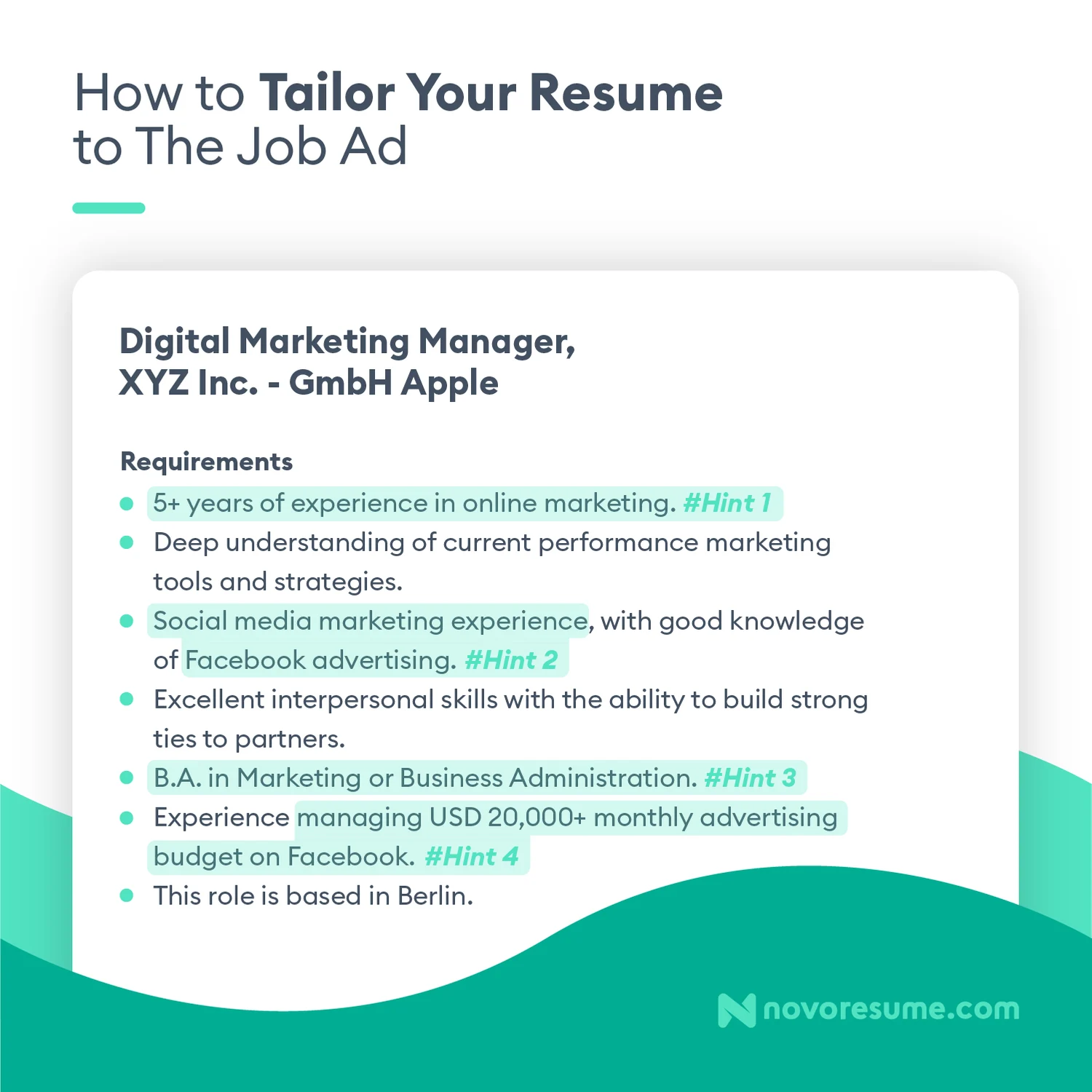
As you can see, we’ve highlighted the most important requirements.
To tailor your resume accordingly, you just need to mention how you meet each of these requirements in your resume.
You can highlight your relevant achievements and qualifications in different parts of your resume, such as:
- In your resume summary, where you should recap your years of experience.
- Throughout your work experience section, where you should list achievements and responsibilities that reflect your social media marketing experience.
- In your education section, where you can let the hiring manager know you have the degree that they’re looking for.
Include the Right Amount of Work Experience
If you’ve got over a decade’s worth of work experience, you’re probably wondering whether all of it belongs on your resume. In most cases, you’d end up writing a novel if you listed everything you’ve ever done, and that’s not how long a resume should be .
If you’re new to the job market, on the other hand, you probably don’t have any experience, and you’re wondering what you could even add to this section.
So, here’s how much information your resume should include, depending on your level of experience:
- No experience. If you’re looking for your first job , you won’t have any work experience to fill this section with. So, you can either keep it empty and focus on all the other sections or fill it up with any experience gained in student organizations, extracurricular activities, volunteering, and other projects.
- Entry-level. List all your work experience so far. While some of it won’t be relevant, it can still show the hiring manager that you do have some actual work experience.
- Mid-level. Only mention relevant work experience to the position you’re applying for. There’s no need to waste space on jobs that aren’t related to what you’re after.
- Senior-level. List up to 15 years of relevant work experience, tops. If your most recent experience is as a marketing executive , the hiring manager doesn’t care how you started your career as a junior marketing specialist 23 years ago.
Consider Applicant Tracking System (ATS) Software
Did you know that over 70% of resumes don’t even make it to the hiring manager ?
Most companies these days use ATS to evaluate hundreds of resumes instantaneously and automatically filter out the ones that don’t meet their criteria.
For example, if a resume doesn’t mention a specific skill or isn’t formatted correctly, the ATS will automatically reject it.
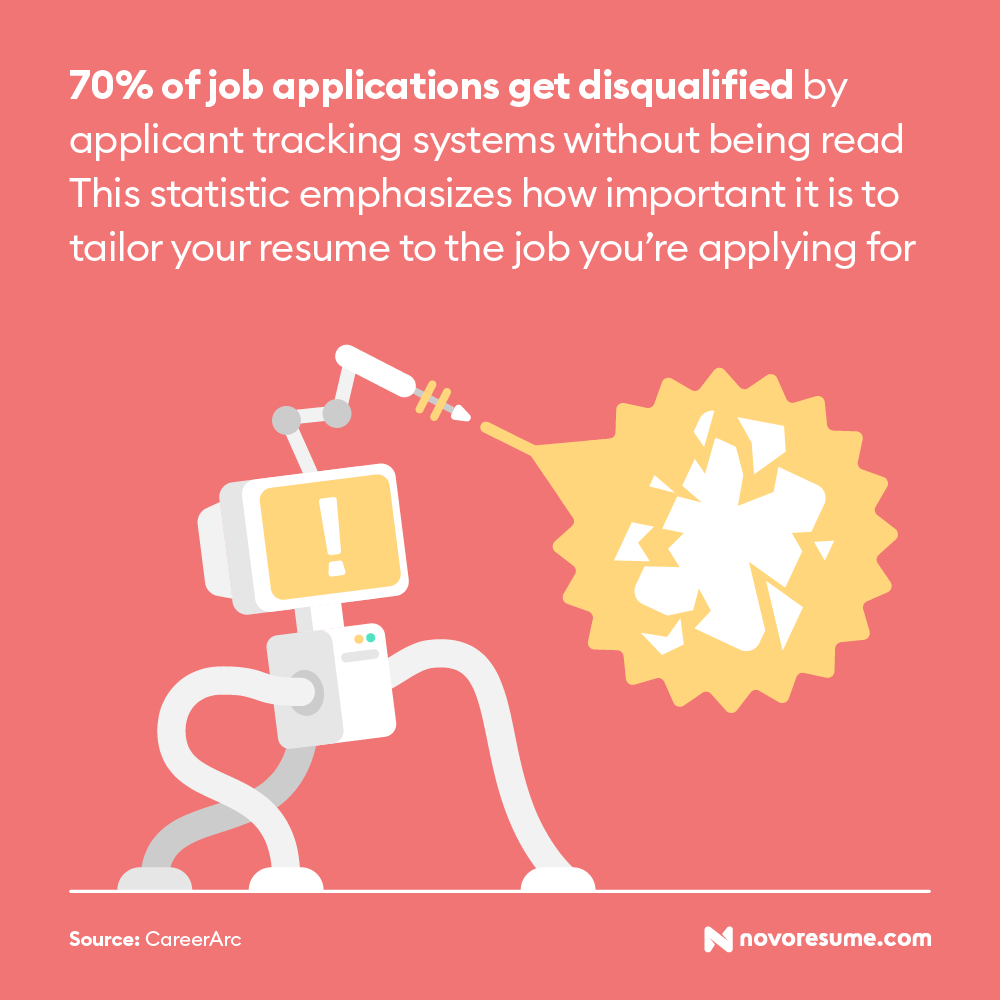
Fortunately, there are some easy ways to make an ATS-friendly resume .
Here are a couple of tips to help you get past those pesky robots:
- Stick to one page. Sometimes employers set a limit on how long a resume should be. This means that if your resume is longer than one page, it might get automatically disqualified.
- Incorporate keywords. Tailoring your resume to the job helps a ton with beating the ATS. Just carefully read the job description to find hints for what the ATS will be looking for. Then, whenever you find keywords related to your responsibilities and achievements, make sure to include them in your work experience section.
- Use an active voice. Passive voice is too vague and unclear, so make sure to use active voice as much as possible when describing your previous jobs. (E.g.: “Managed a team of ten people,” instead of “ A team of ten people was managed by me.” )
- Leverage powerful action words. Instead of starting each of your sentences with “was responsible for," make your work experience impactful by using words that can grab attention. Saying that you “spearheaded” or “facilitated” something sounds a lot more impressive than “helped.”
Want to make sure your resume formatting passes the ATS test? Choose one of our tried and tested ATS-friendly resume templates , and you’ll be good to go!
#5. List Your Education
The next section on your resume is dedicated to your academic qualifications. Let’s start with the basics!
Here’s how you should format the education section on your resume :
- Program Name. Your major and degree type should be listed. (E.g.: “B.A. in Business Administration” )
- University Name. Add the name of the institution. (E.g.: “New York State University” )
- Dates Attended. Use a mm/yyyy format for the dates you attended. (E.g.: “08/2008 - 06/2012” )
- Location. If your university is less well-known, you can also add the location. (E.g.: “Stockholm, Sweden” )
- GPA. Use the appropriate grading system for the country you’re applying to work in. (E.g.: In the USA, it would be “3.9 GPA” )
- Honors. Add any honors and distinctions you’ve been given. (E.g.: Cum Laude, Magna Cum Laude, Summa Cum Laude )
- Achievements. You can mention interesting papers you’ve written, projects you’ve done, or relevant coursework you’ve excelled in.
- Minor. “Minor in Psychology”
Pretty simple, right? Now let’s see what an education section looks like in practice:
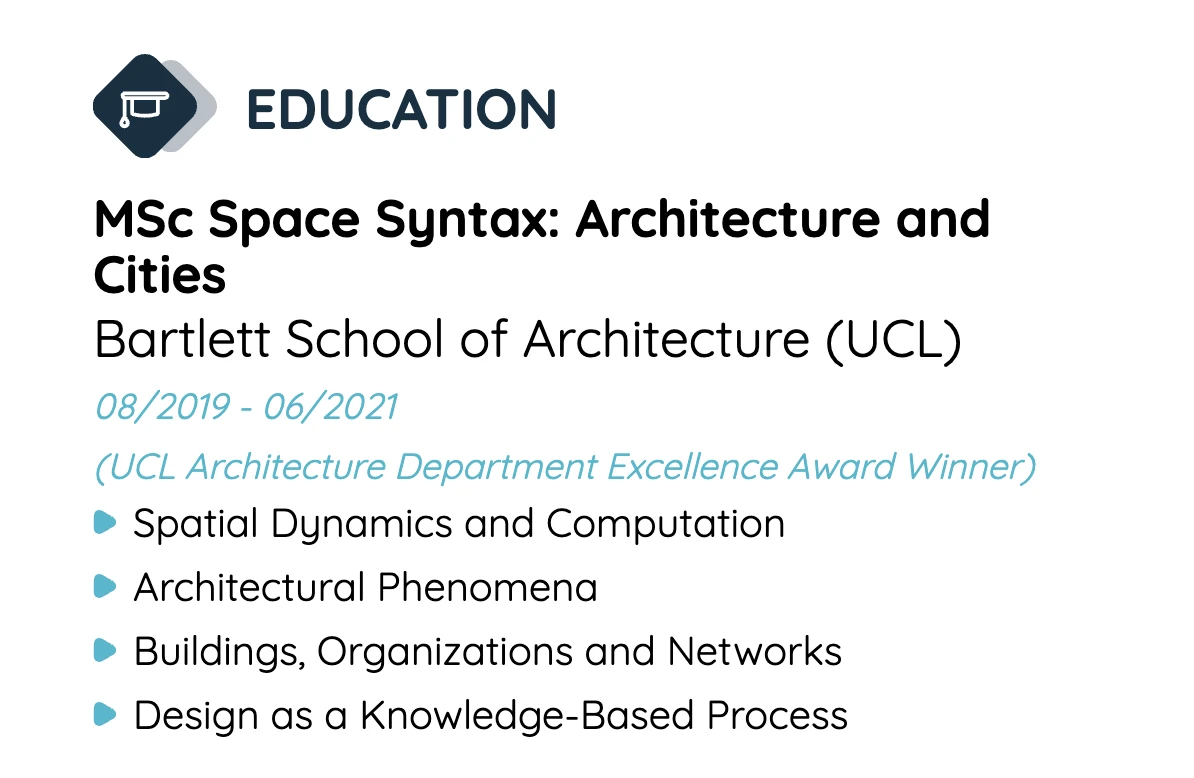
This example includes all the necessary information, plus an eye-catching award and relevant classes this candidate has taken.
Resume Education Tips
Now that you know how to list your education on your resume, let’s take this section to the next level.
Just follow these expert tips:
- If you’re making a resume as a student and don’t have any work experience yet, you can list your education section at the beginning of the page instead of work experience.
- You can add your expected graduation date if you’re still pursuing your degree.
- If you already have relevant work experience, just keep this section short and sweet. Recent graduates can expand on their education more and add optional information like projects, classes, academic achievements, etc.
- Always list your degrees in reverse chronological order, starting with your highest degree on top. Your highest and most recent degree is usually enough, so if you have a Master’s degree that’s relevant to the job, there’s no need to mention your earlier degrees.
- Don’t add your high school degree to your resume if you already have a university degree. It doesn’t have as much weight, and you can use the space for something else.
- Only mention your GPA if you had an impressive academic career. Anything below a 3.5 GPA doesn’t need to be on your resume.
Are you in the process of applying for college? Check out our guide to writing a college application resume to wow that admissions officer!
#6. Emphasize Your Know-How in the Skills Section
After your work experience, your skills are the first thing the hiring manager is going to look for. In fact, together, work experience and skills make up 90% of the hiring decision .
So, this is the place where you want to mention all the know-how that makes you the perfect candidate for the job.
There are two types of skills you can include when writing your resume:
- Hard Skills. These are measurable abilities. What you can list here can be anything from coding in Python to knowing how to cook Thai cuisine.
- Soft Skills. Also known as personal skills, these are a mix of communication skills , personal traits, career attributes, and more. They can include leadership, critical thinking, and time management , just to name a few.
Your resume should always cover both hard skills and soft skills . Here’s an example in action:
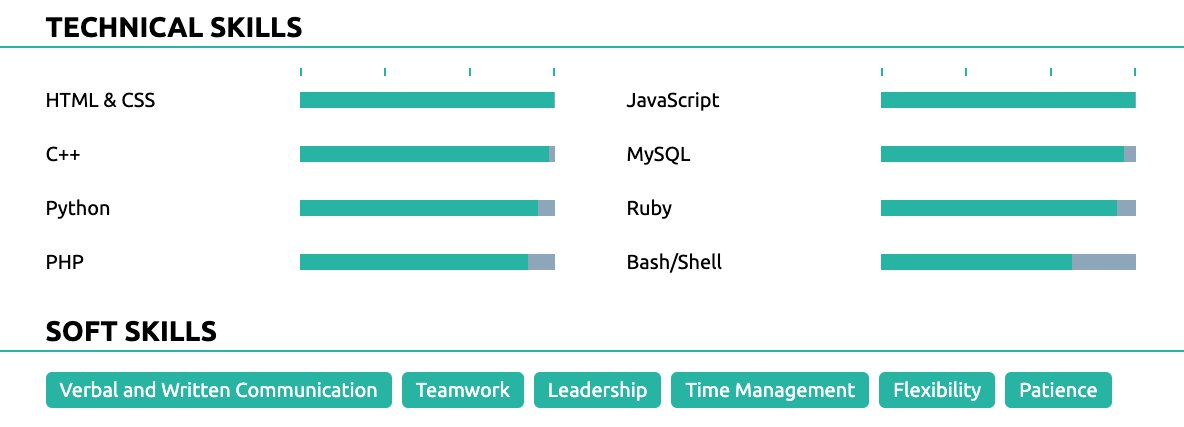
Now, let’s discuss how you should list your most important skills on your resume.
There are a few essential steps you need to follow:
Always List Hard and Soft Skills Separately
Your resume should be easy and neat to navigate. The hiring manager shouldn’t have to waste time looking for a specific skill because you didn’t separate it into the appropriate subsection.
So, just create separate categories for your hard and soft skills.
Depending on your field, you could customize the name of your “hard skills” subsection to something like “technical skills," “marketing skills," or something else related to your field.
Let’s look at an example of what skills look like on a project manager’s resume :
Methodologies & Tools
- Agile Methodology
- SCRUM Framework
- Waterfall Project Management
- Microsoft Project
- Critical Path Method (CPM)
- Earned Value Management (EVM)
- Risk Management
Soft Skills
- Team Management
- Conflict Resolution
- Negotiation
Tailor Your Skills to the Job
You might have some awesome skills, but the hiring manager only needs to know about the ones that are relevant to the job.
For example, if you’re applying for a job as an accountant, your gourmet chef skills shouldn’t be on your resume.
Look at the job ad and list at least two to three essential skills you have that are required for the role. Remember—there’s no need to list every skill you have here; just keep it relevant.
Qualifications:
- Bachelor’s degree or higher in Graphic Design or a related field.
- Tech-savvy, with some background in CMS systems such as WordPress.
- Thrives in a stressful environment and juggles multiple tasks and deadlines.
- Strong organizational and time management skills.
- Excellent communication skills.
- Self-reliant, with the ability to manage their own work.
- A can-do attitude and an outside-the-box thinker.
- Proficient in Adobe Photoshop, InDesign, Illustrator, Keynote, and Pages.
- Basic understanding of Office software such as Microsoft Word, Excel, PowerPoint, and Outlook.
So, the must-have hard skills here are Photoshop, InDesign, Illustrator, Keynote, and Pages. Other good computer skills to have are WordPress or similar CMS systems.
While you can also mention Word, Excel, PowerPoint, and Outlook, it’s pretty much assumed that you know how to use them since they’re required for most office jobs.
List Hard Skills with Experience Levels
For each hard skill you list on your resume, you should also mention your proficiency level. This tells employers what they can expect from you and how much training you might need.
- Beginner. You have some experience with the skill, whether it’s from some entry-level practice or classroom education.
- Intermediate. You’ve used the skill in a work environment with good understanding.
- Advanced. You’re the go-to person for this skill in your office. You can coach other employees, and you understand the skill at a high level.
- Expert. You’ve applied this skill to more than a handful of different projects and organizations. You’re the go-to person for advice about the skill, not just in your office but even amongst some of the best professionals in your field.
Just make sure to never lie about your actual skill level. Even if you get the job, once you need those skills you exaggerated, it will be pretty awkward for both you and your employer.
Include Transferable Skills
These are the types of skills that are useful for almost any job out there.
Transferable skills can be both soft skills (e.g.: teamwork, creativity, problem-solving skills, and others) and hard skills (MS Office Suite, HTML, writing, etc.)
Whatever job you’re applying to, chances are you have transferable skills from your experience that can come in handy one way or another. So, feel free to include them, even if they’re not specifically required for the position.
Not sure which skills to mention on your resume for your specific field? Check out our list of 101+ essential skills for inspiration!
#7. Leverage Optional Resume Sections
The sections we’ve covered so far are must-haves for any resume. They’re the bread-and-butter for any job application, and if you get them right, you’ll land any job you apply to.
But if you have some leftover space, there are a few optional sections you can choose from to give your resume a boost!
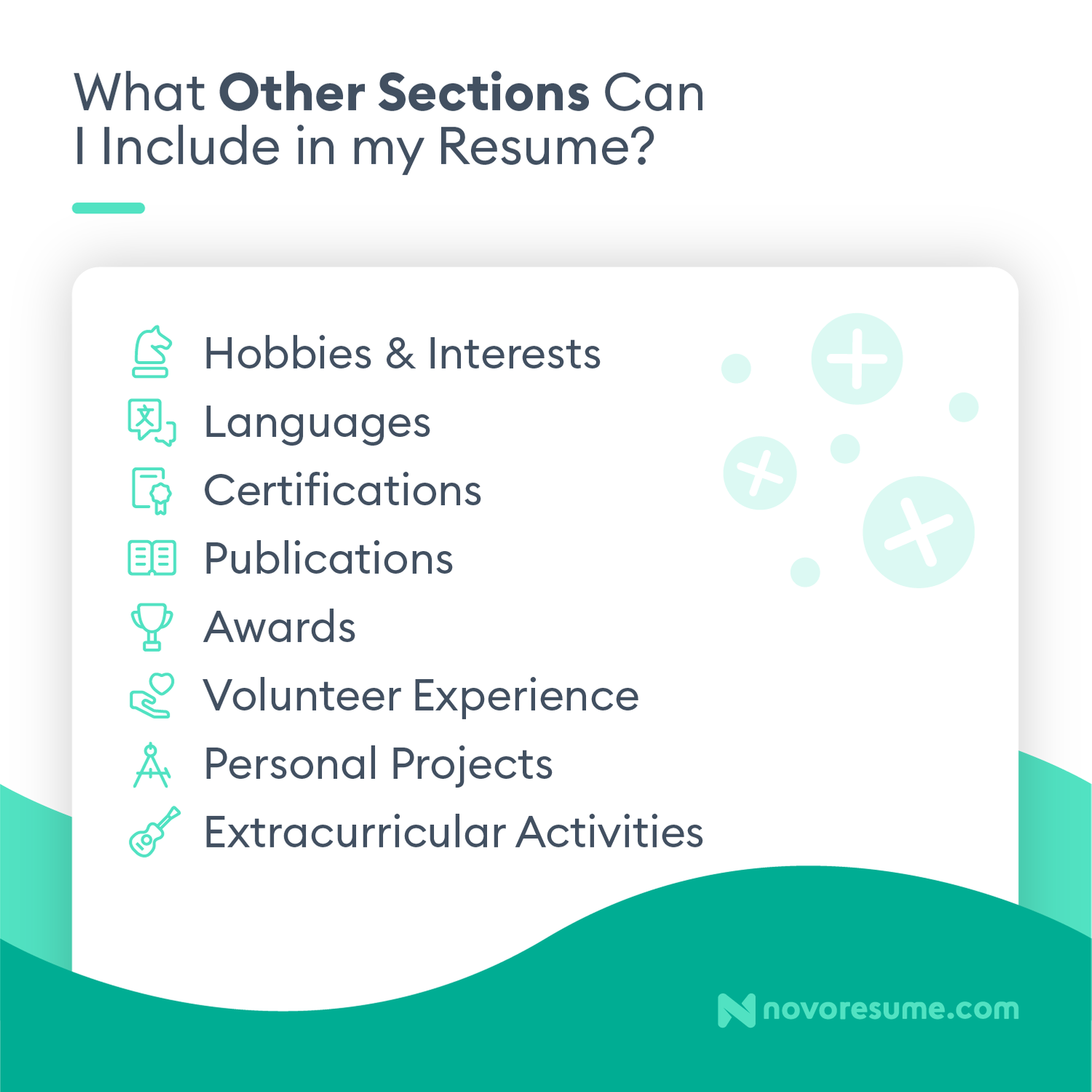
Are you bi-lingual? Or even better – multi-lingual? You should always mention that on your resume!
Even if the position doesn’t require you to know a specific language, it can still come in handy at some point. At the end of the day, it’s always better to know more languages than less.
To list languages in your resume , just write them down and assign them the appropriate level:
- Intermediate
You can also use the Common European Framework of Reference for Languages (CEFRL) or the American Council on the Teaching of Foreign Languages (ACTFL) proficiency scales.
As a given, you should never lie about your language skills. You never know—your interviewer might turn out to be fluent in the language or even be a native speaker!
Hobbies and Interests
If you want to spice up your resume, hobbies and interests could be just what you need.
While this section isn’t a game-changer, it can help the hiring manager see who you are as an individual.
For example, if you listed “teamwork” as one of your skills, hobbies like team sports can back up your claim.
And who knows? Maybe you and your interviewer have some hobbies or interests in common!
Volunteering Experience
If you’re the type of person who devotes their free time to helping others while expecting nothing in return, chances are that you’re the type of employee who’s in it for more than just the money.
Seeing volunteer experience on your resume tells hiring managers that you’re a loyal employee who’s after something meaningful.
Several studies show that listing your volunteer experience can boost your chances of getting hired, especially if you have little to no work experience.
Certifications
Hiring managers love candidates who invest in themselves, and that’s exactly what they see when you list certifications on your resume .
If you value continuous learning and strive to expand your skill set, that’s always a plus.
Certifications can also show employers how much expertise you have.
For example, if you’re a Microsoft Cloud Engineer and you specialize in Microsoft Technologies, you should definitely include all essential certifications on your resume, such as the Azure Solutions Architect Expert one.
Awards and Recognitions
There’s no harm in showing off a little on your resume. After all, you want to be a candidate that shines above the rest.
So, if you’ve received any awards or recognitions that make you stand out in your field, make sure to add them.
For example, if you’ve been recognized for your contributions to data science or received a hard-to-come-by scholarship , mention it in your resume. Just keep your entries here relevant to the field you’re applying to.
Publications
Whether you’re a freelance writer or a distinguished academic, publications are always impressive.
If you have any published works (online or in an academic journal), you can add them to your resume. Just make sure to include a link so the hiring manager knows where to check your work!
Are you looking for a career in academia? Check out our guide to writing the perfect academic CV to get started!
Working on side projects can show off your passion for your field. Whether they’re university class projects or part-time entrepreneurial endeavors, they’re relevant.
For example, if you worked on a mock software product as part of a university competition, it shows you went through every step of product creation, from ideation to creating a marketing strategy.
This project also shows off your organizational skills , and if you mention it in your resume, you stand a better chance of landing the job you had your sights set on.
But projects can also be personal, not academic. For example, you might manage an Etsy store where you sell hand-made arts and crafts to customers online. This is a great opportunity to highlight your creativity, management, and customer service skills .
Overall, hiring managers love employees who do cool work in their free time, so projects are always a great section to add to your resume.
Looking to kickstart your career? Check out our guide on how to get an internship for useful tips and real-life examples!
Extracurricular Activities
Every college freshman knows that extracurricular experience can make a difference in their application.
Especially if you don’t have a lot of experience outside of school, extracurricular activities are a great way to show potential employers your skills and give them insight into you as a person. Different clubs and after-school projects can help you gain real-life skills and considerably increase your chances of landing your first job after college.
For example, joining a student government organization can hone your leadership skills and teach you how to work as part of a team.
For example, if you’re part of a student government or public speaking club, these activities can help you hone your leadership and presentation skills.
11+ Expert Resume Tips
You’ve got the gist of how to make a resume. Now, it’s time to make it really stand out from the crowd!
Follow these exclusive resume tips to take your resume game to the next level:
- Match the professional title underneath your name to the job title of the position you’re applying for. Hiring managers often hire for several roles at once, so giving them this cue about what role you’re after helps things go smoother.
- Mention any promotions from your previous jobs. Use the work experience entries for them to focus on the achievements that helped you earn them.
- Describe your achievements using Laszlo Bock’s formula : accomplished X as measured by Y by doing Z . This way, your work experience can go the extra mile and show the hiring manager what you can bring to the table.
- Always list your achievements and responsibilities in concise bullet points. This makes your resume more reader-friendly, and it’s more likely that the hiring manager will see your impressive achievements at a glance.
- Don’t use personal pronouns like “I” or “me,” and don’t refer to yourself by name. Stick to a slightly altered third person, like “managed data integrity at XYZ Inc.” instead of “he managed data integrity at XYZ Inc.”
- Name your resume sections correctly, or it might get rejected by the ATS. Swapping out quirky names like “career history” or “expertise” for “work experience” and "skills" makes it easier for the hiring manager to find what they’re looking for, too.
- Prioritize important keywords instead of adding all of them. Make sure the relevant skills, qualifications, and experiences you add all make sense in context, too. Your goal is to get past the ATS and impress the hiring manager.
- Focus on transferable skills if you don’t have a lot of relevant work experience. Any extracurricular activities or personal projects can help you stand out here.
- Add a strategic pop of color to headings, bullet points, or key elements you want to highlight. It can help your resume stand out, but don’t overdo it—you want the information to be more impressive than the color palette.
- Don’t include the line “references available upon request.” Hiring managers already know they can request a list of references from you, so there’s no need to waste valuable space on it.
- Make sure your resume is optimized for mobile viewing. Most hiring managers use their mobile phones as often as desktop computers, so save your resume to a PDF file and make sure your formatting stays intact across any device.
- Rename the resume file you plan to send so it includes your name and the name of the position you’re applying for. It’s a small detail that can turn into a crucial mistake if you forget it.
- Read your resume out loud when you’re done. This is a great way to catch awkward phrases or spelling mistakes you might have missed otherwise.
- Use a tool like DocSend to track your resume. You’ll get a notification any time someone opens your resume, and you can see how long they spend reading it.
FREE Resume Checklist
Are you already done with your resume? Let’s see how it holds up!
Go through our checklist for perfecting your resume and see where you stand!
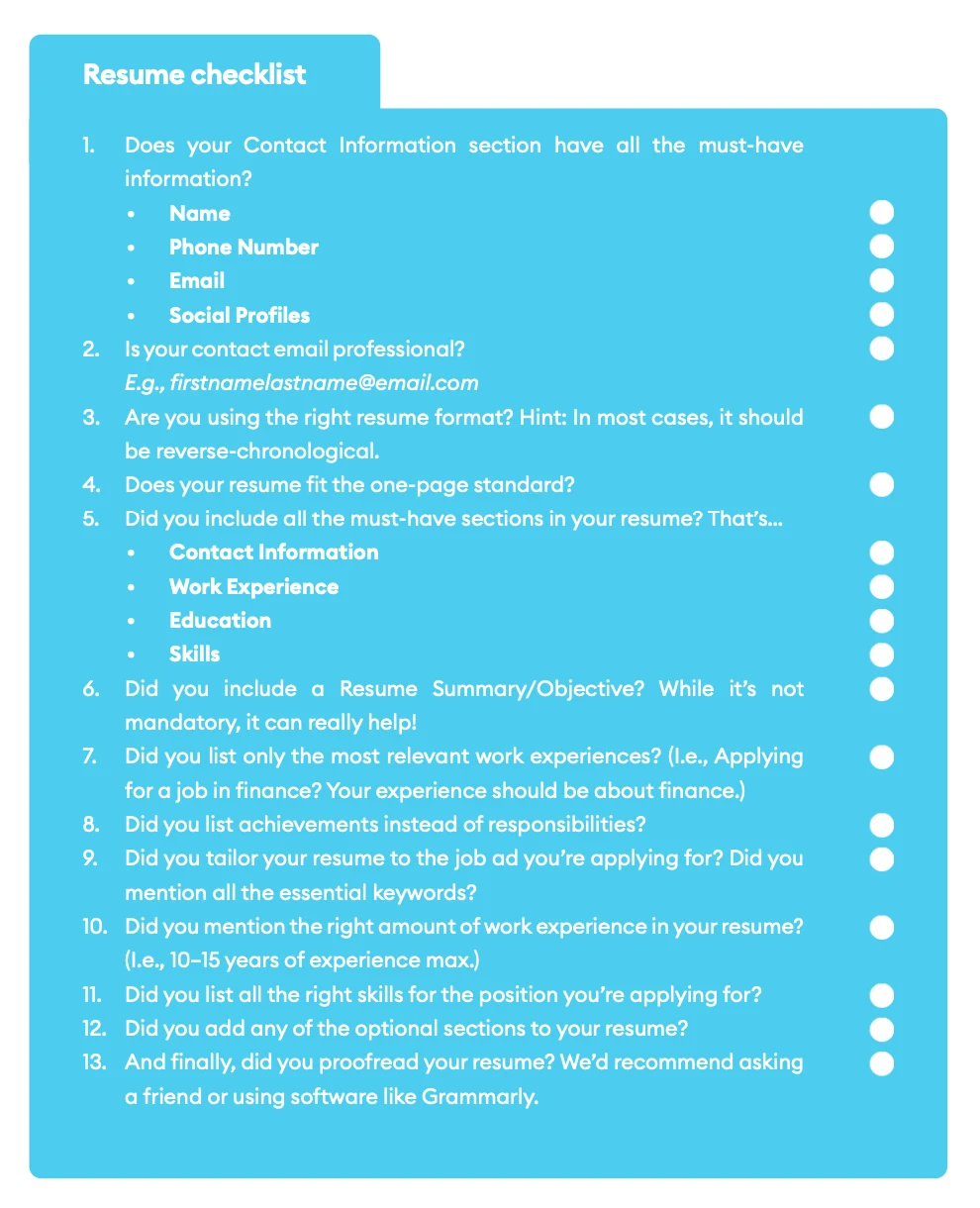
If you missed some points, just go through your resume one more time and perfect it.
And if you ☑’d everything—congrats! You’ve learned all there is to know about writing a resume, and you’re good to go with your job search.
Need to write a CV instead of a resume? Check out our step-by-step guide on how to write a CV with dozens of examples!
9 Resume Templates for Different Industries
Looking to create an effective resume without dealing with the formatting hassle? Just choose one of the templates below.
#1. Traditional Resume Template
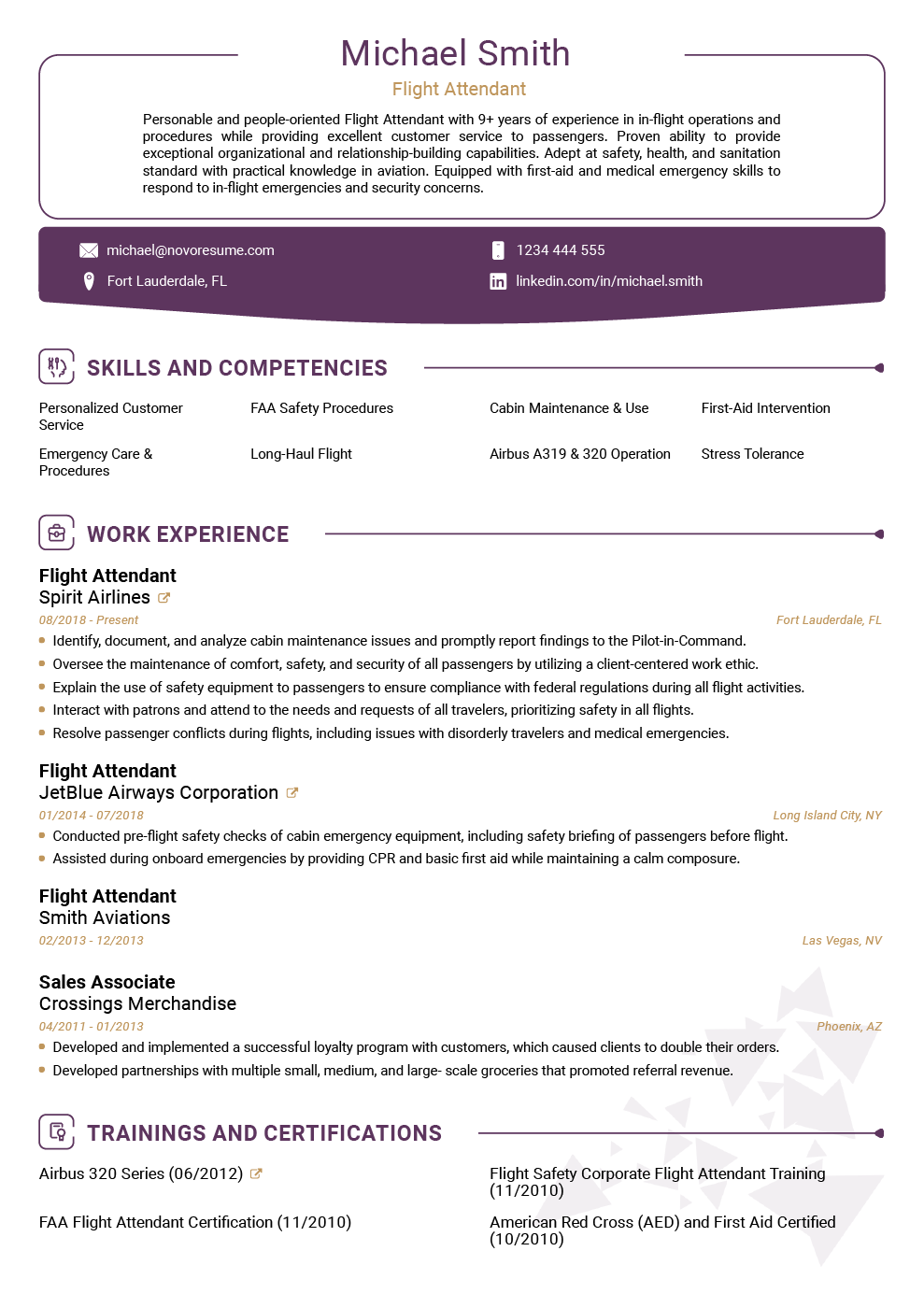
Good for traditional industries like finance, banking, law, and manufacturing.
#2. Modern Resume Template
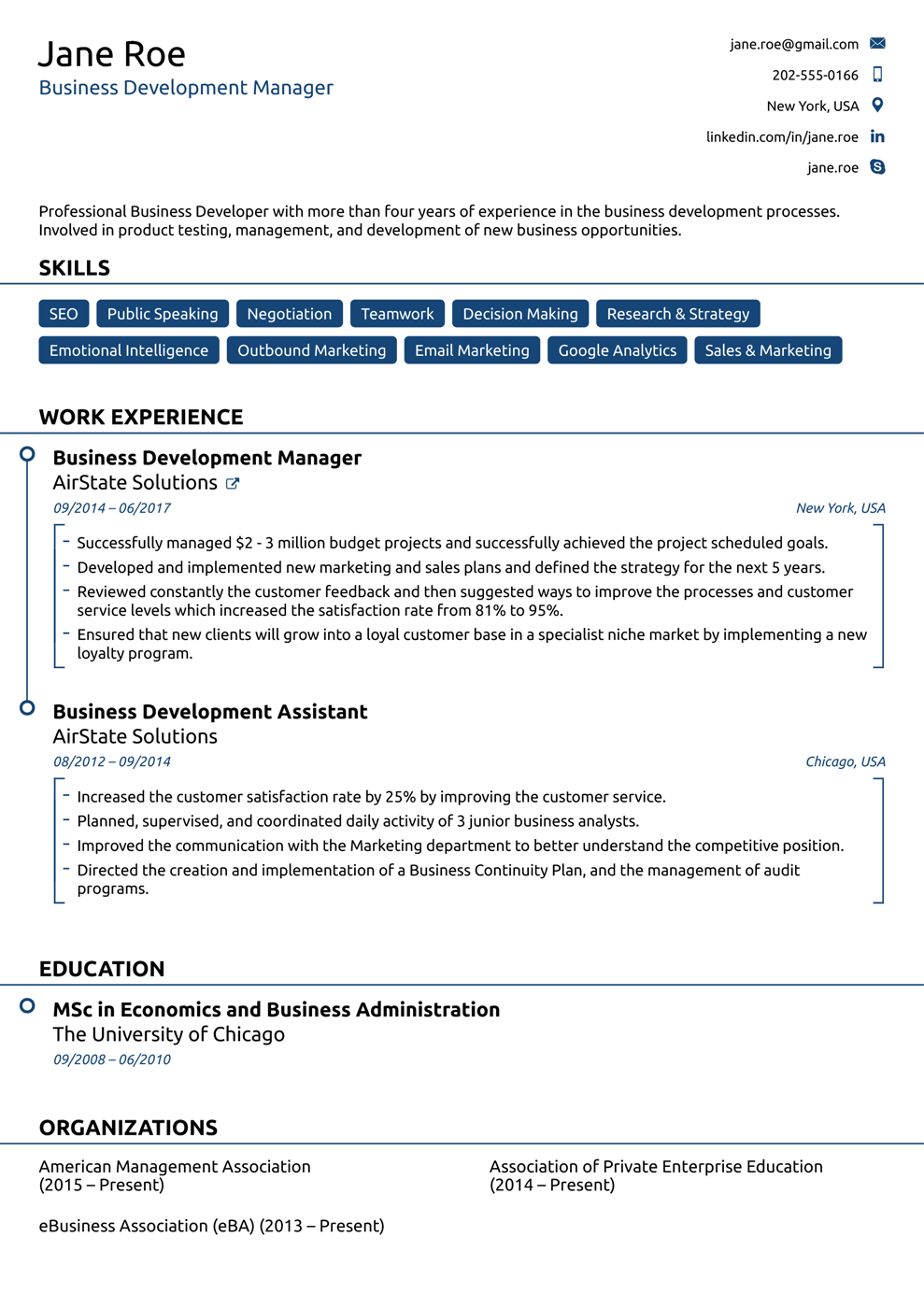
Good for both contemporary and forward-looking industries, including entrepreneurship, medical technology, and engineering.
#3. Creative Resume Template
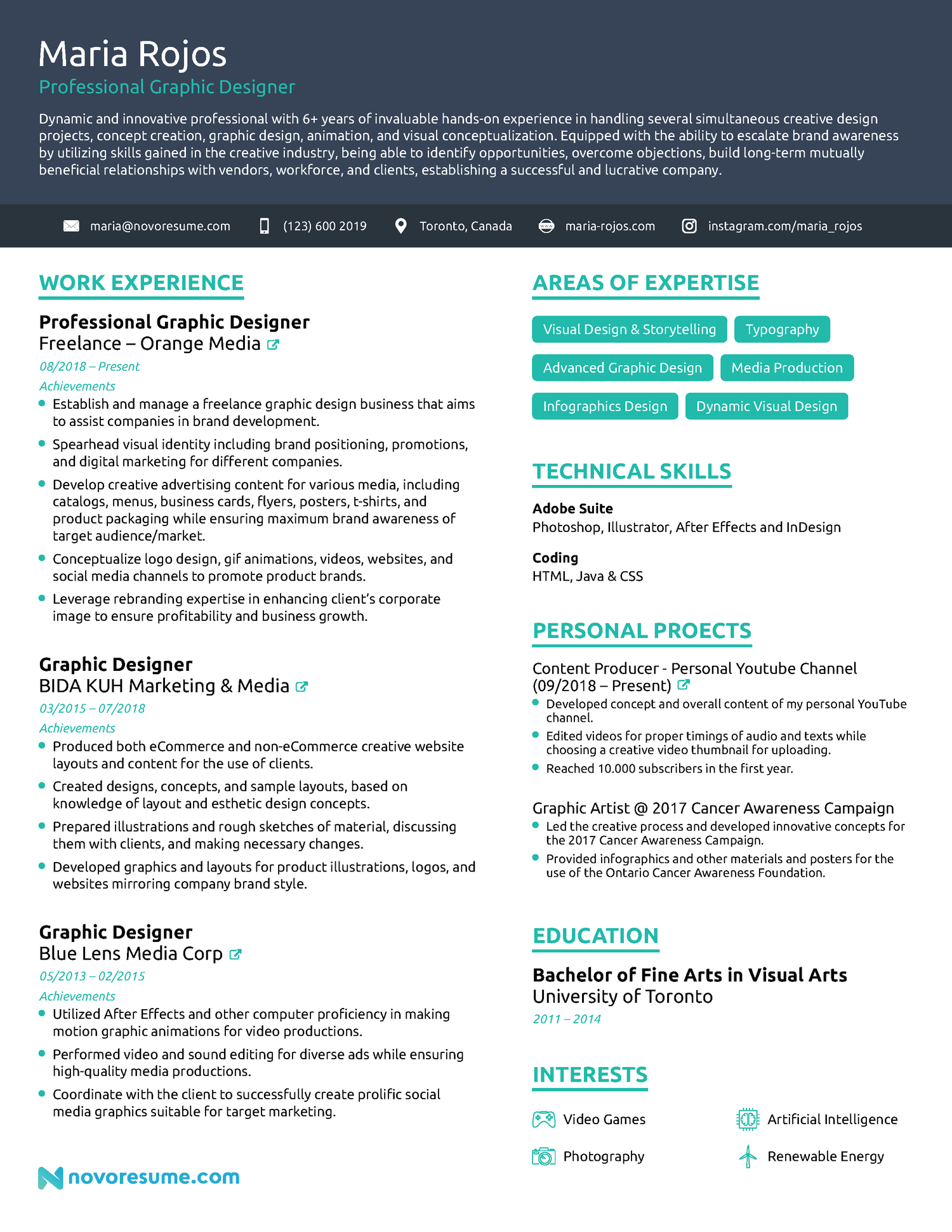
Good for creative industries, including entertainment, design, and architecture.
#4. Minimalistic Resume Template
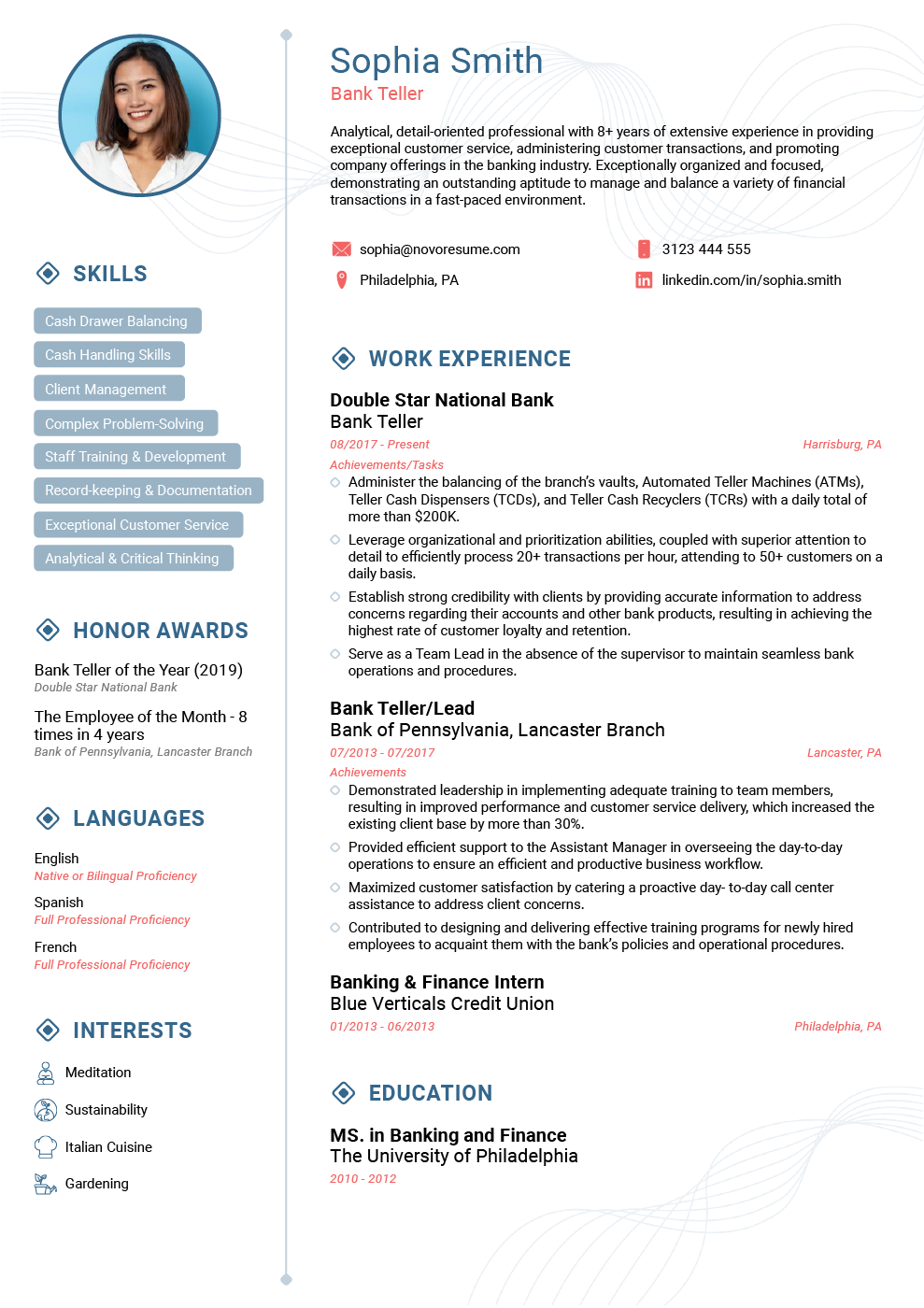
Good for experienced professionals in basically any industry who want to let their achievements do the talking.
#5. IT Resume Template
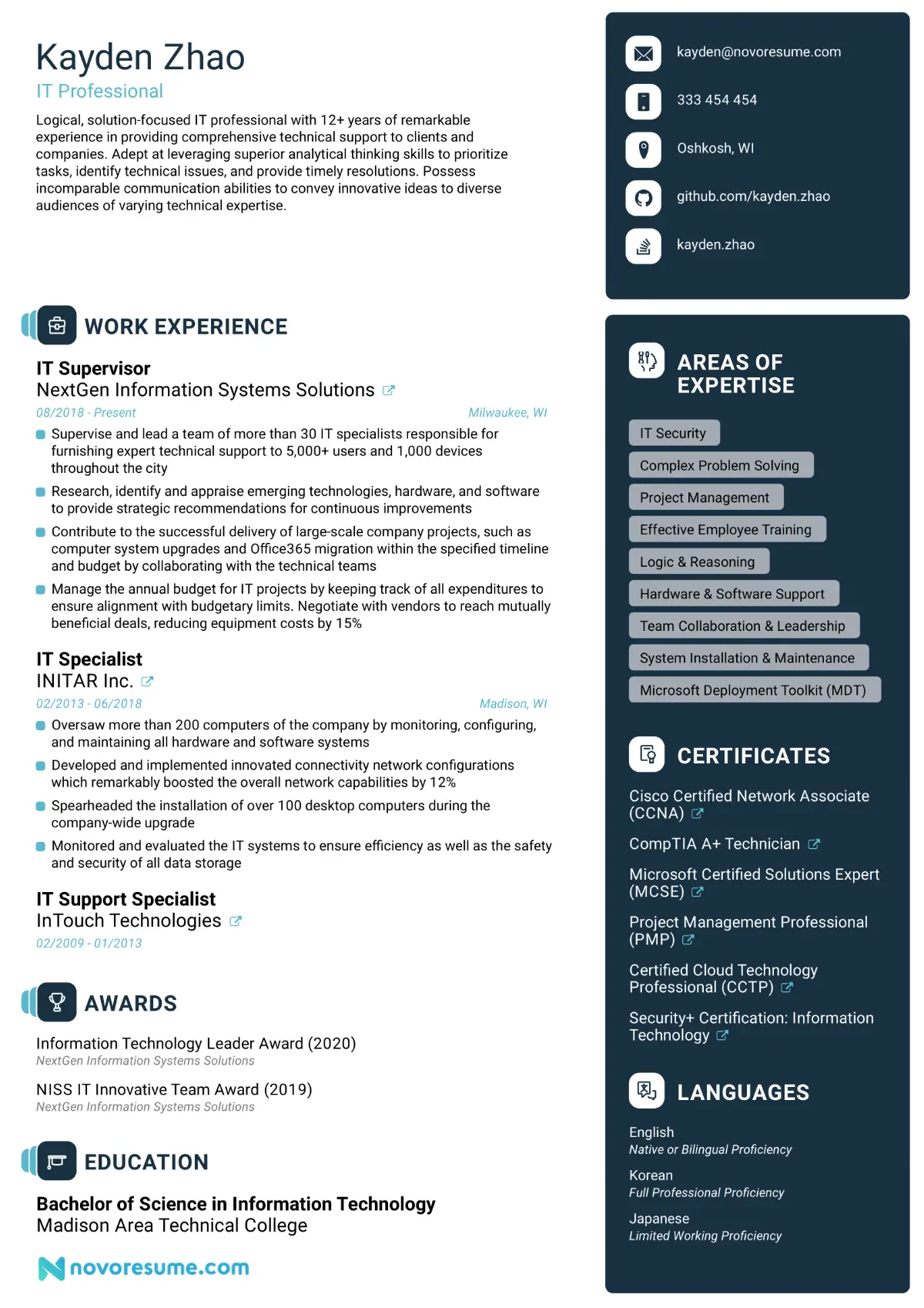
Good for any IT-related profession like software development, cyber security, and DevOps engineering.
#6. Tech Resume Template
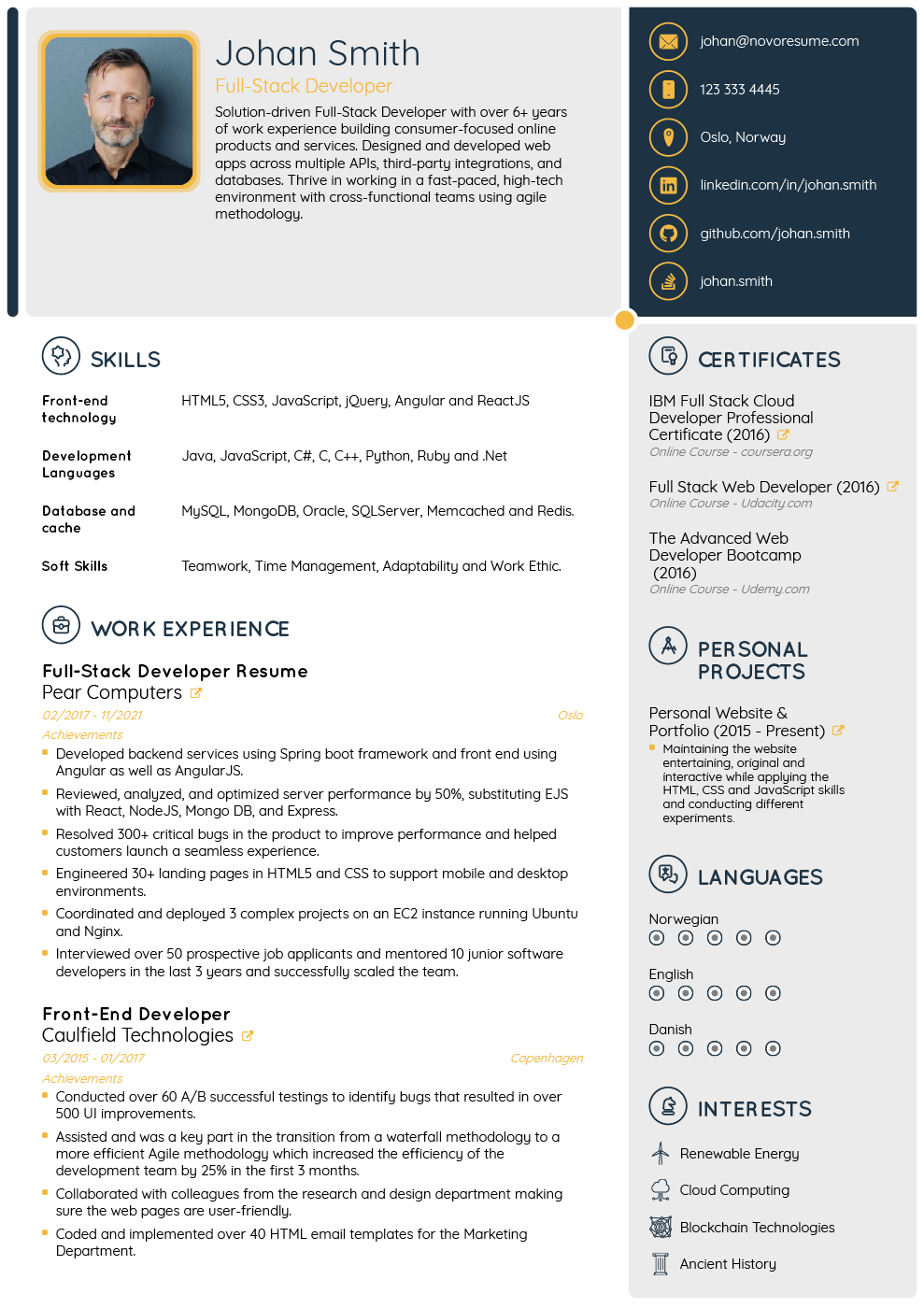
Good for the tech industry and everything it encompasses.
#7. College Resume Template
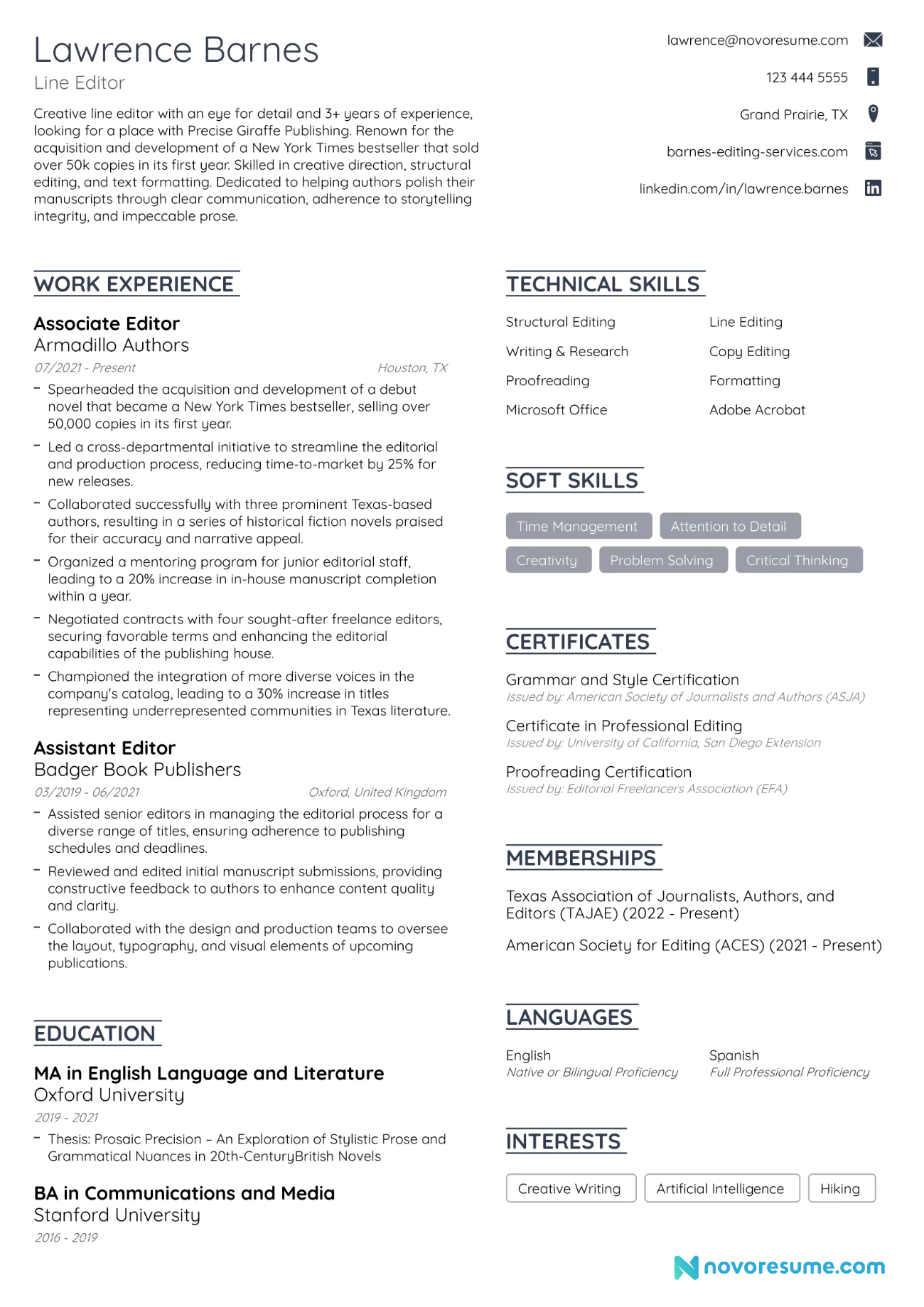
Good for college students and recent graduates alike.
#8. General Resume Template
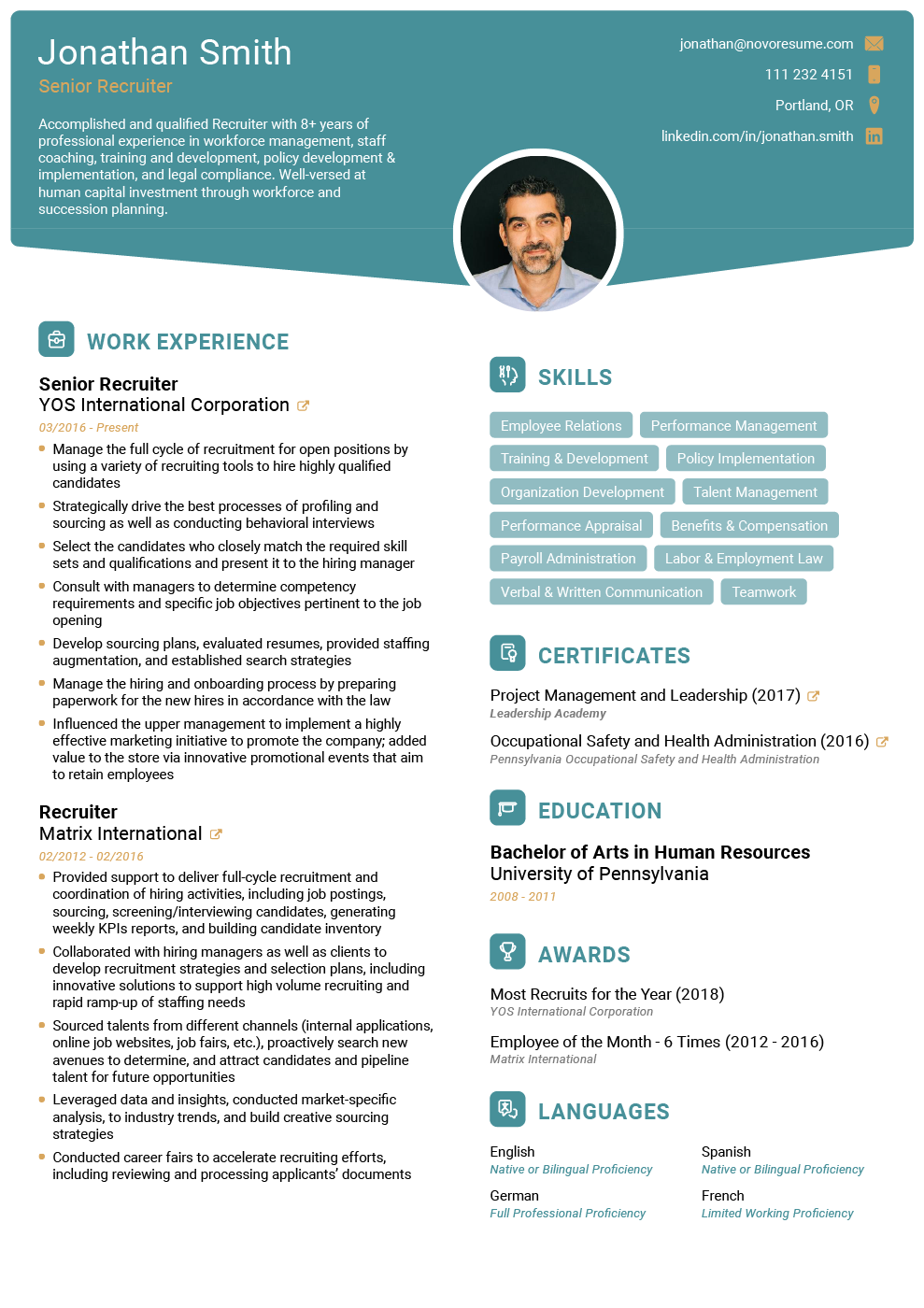
Good for multiple industries, including HR, education, and customer service.
#9. Executive Resume Template
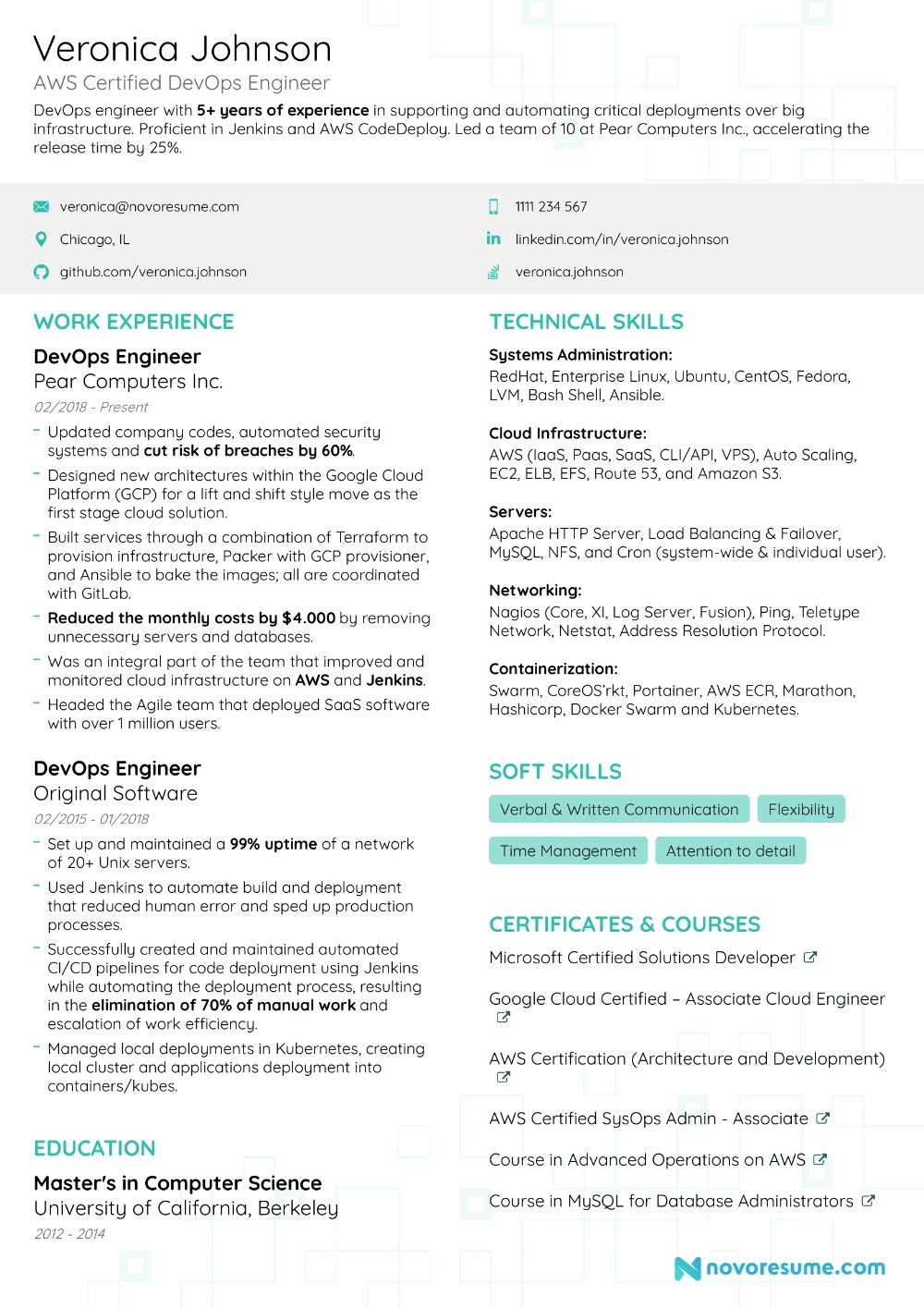
Good for senior professionals across different industries, including hospitality, marketing, and logistics.
17+ Resumes for Different Jobs
Knowing how to write a resume is one thing, but making a resume that stands out is something entirely different. Without inspiration, even top career experts might stumble on a roadblock or two.
Check out the following effective resume examples for specific jobs to get a better sense of what a good resume looks like:
#1. Nurse Practitioner Resume Example
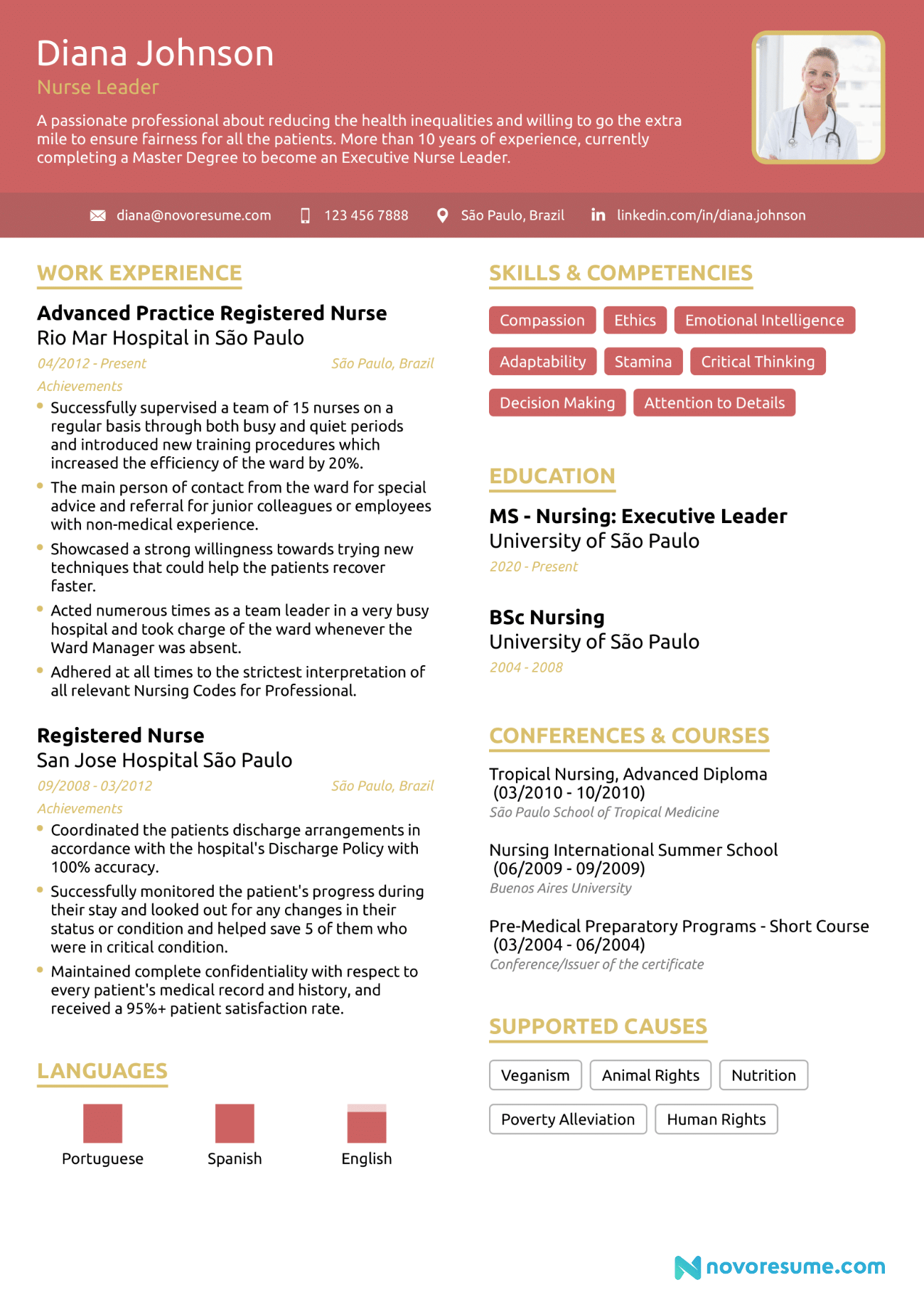
Check out our full guide to writing a nurse resume here.
#2. Data Scientist Resume Example
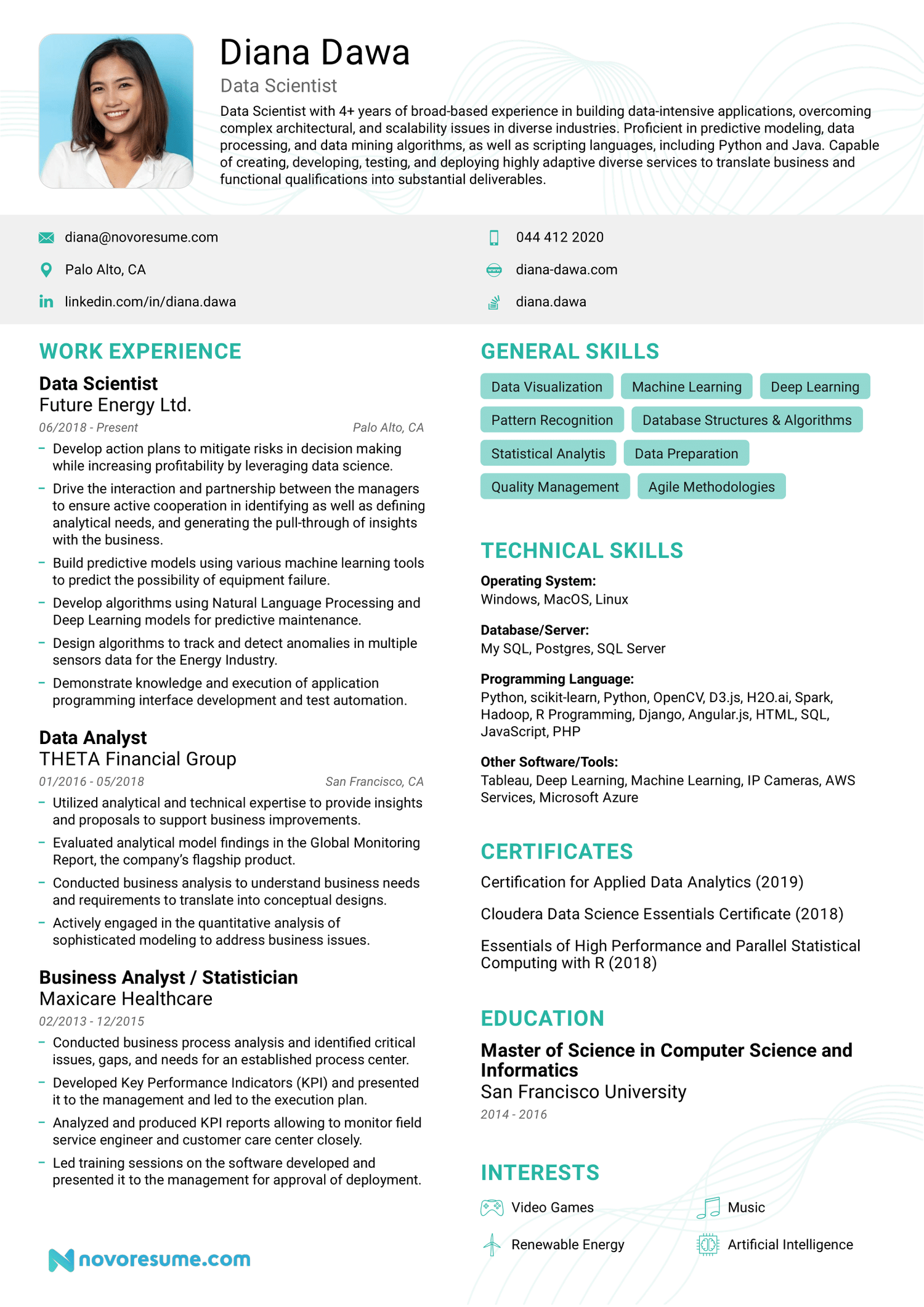
Check out our full guide to writing a data scientist resume here.
#3. Business Analyst Resume Example
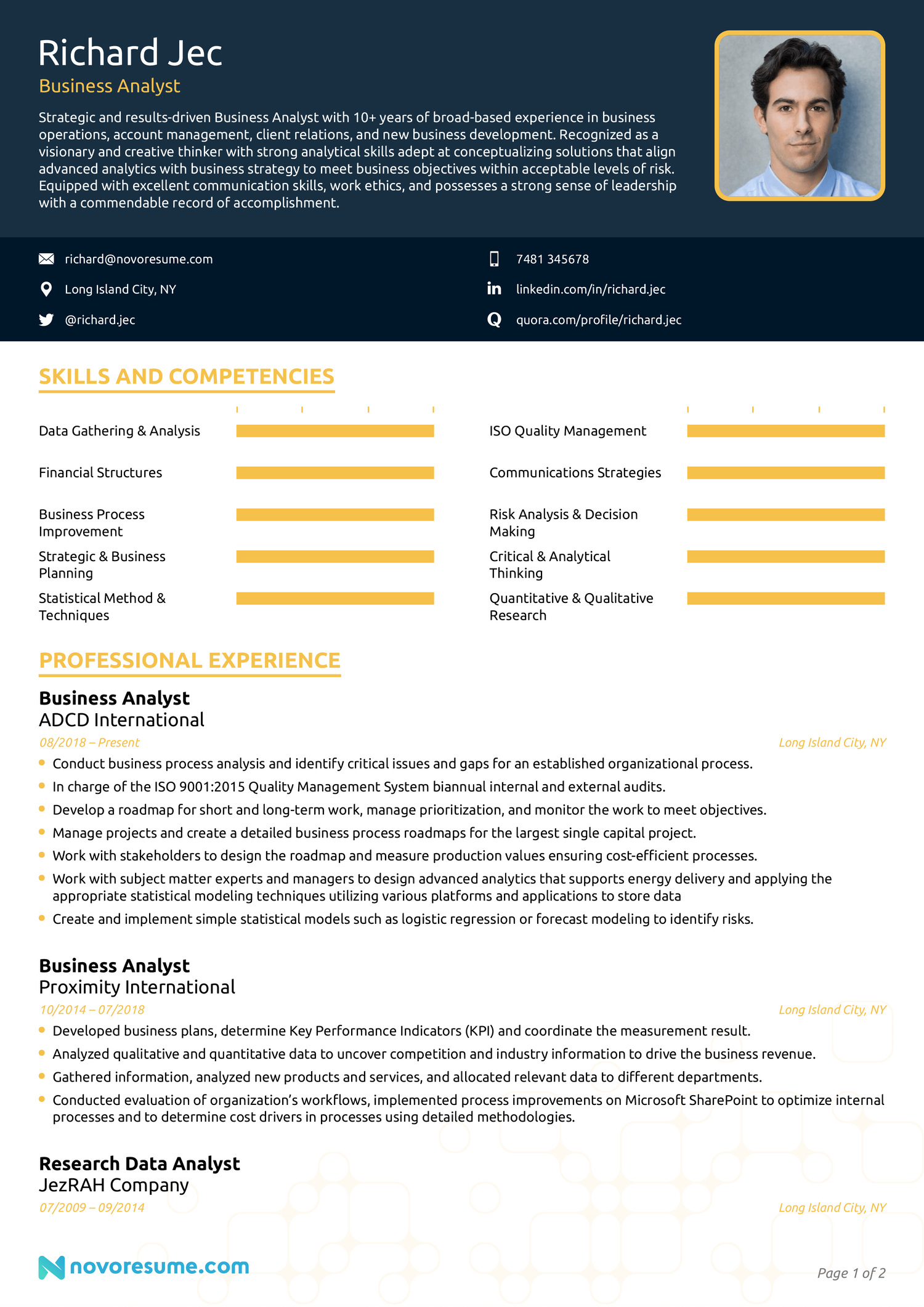
Check out our full guide to writing a business analyst resume here.
#4. Digital Marketing Resume Example
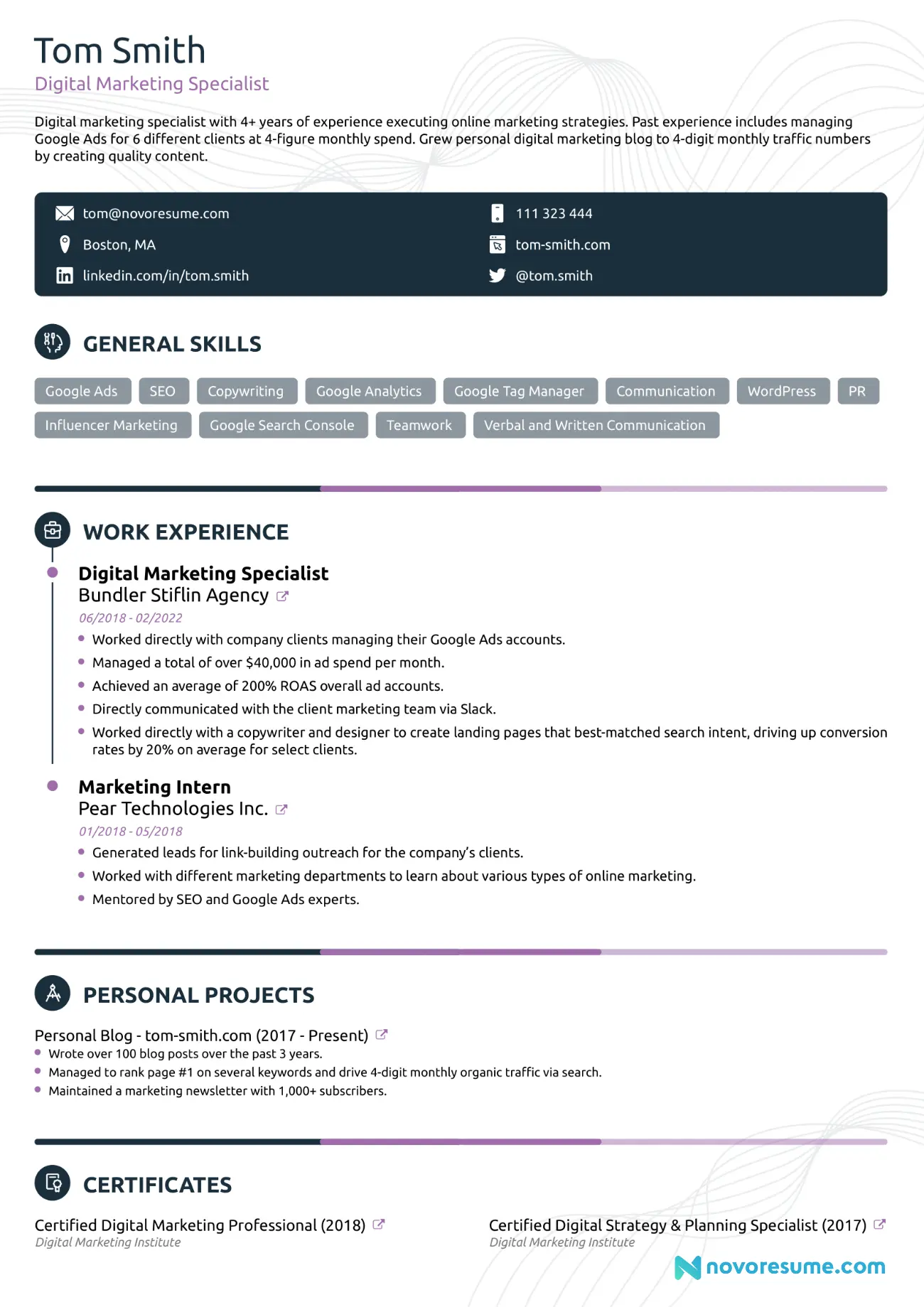
Check out our full guide to writing a digital marketing resume here.
#5. Software Engineer Resume Example
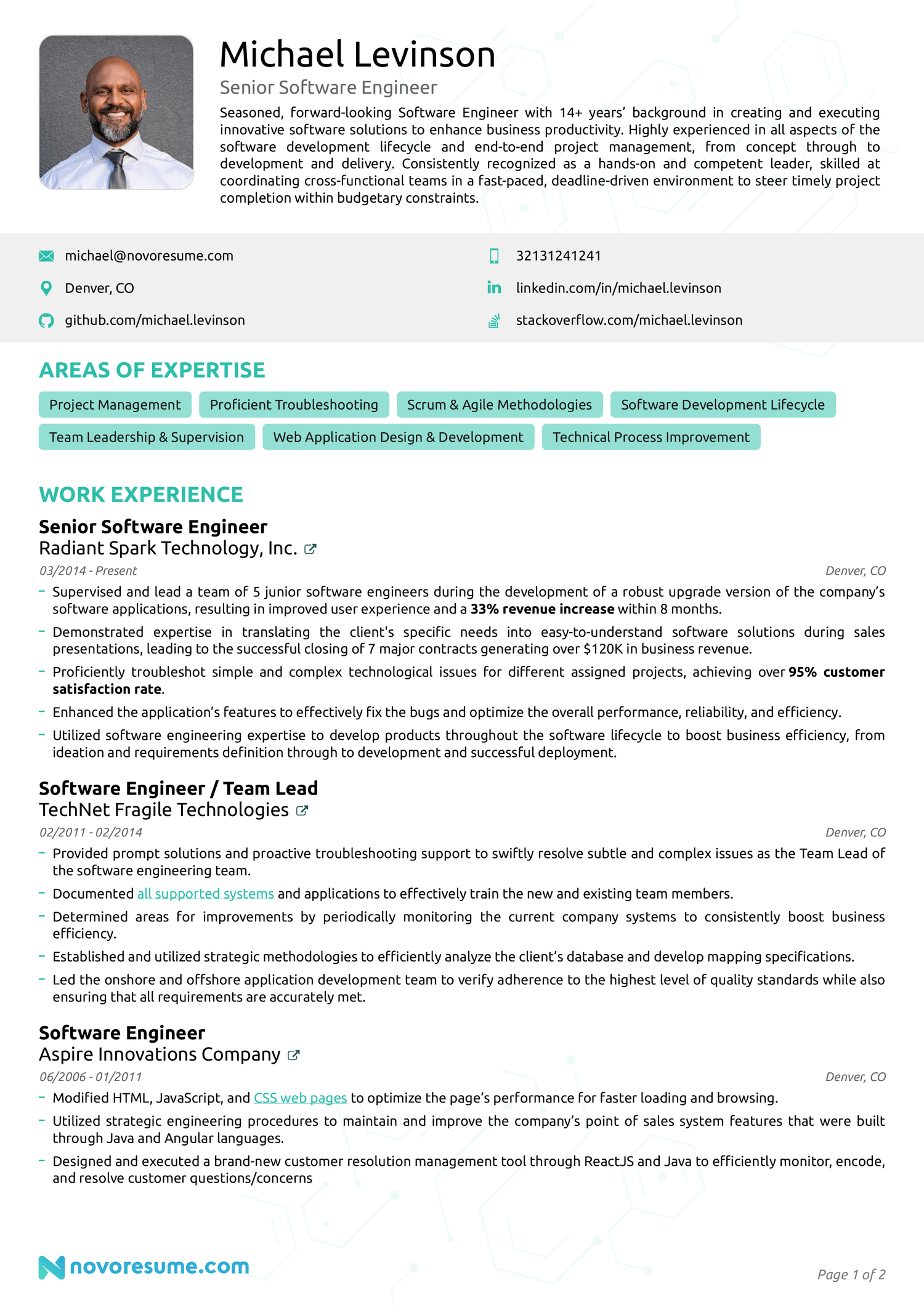
Check out our full guide to writing a software engineer resume here.
#6. Construction Project Manager Resume Example
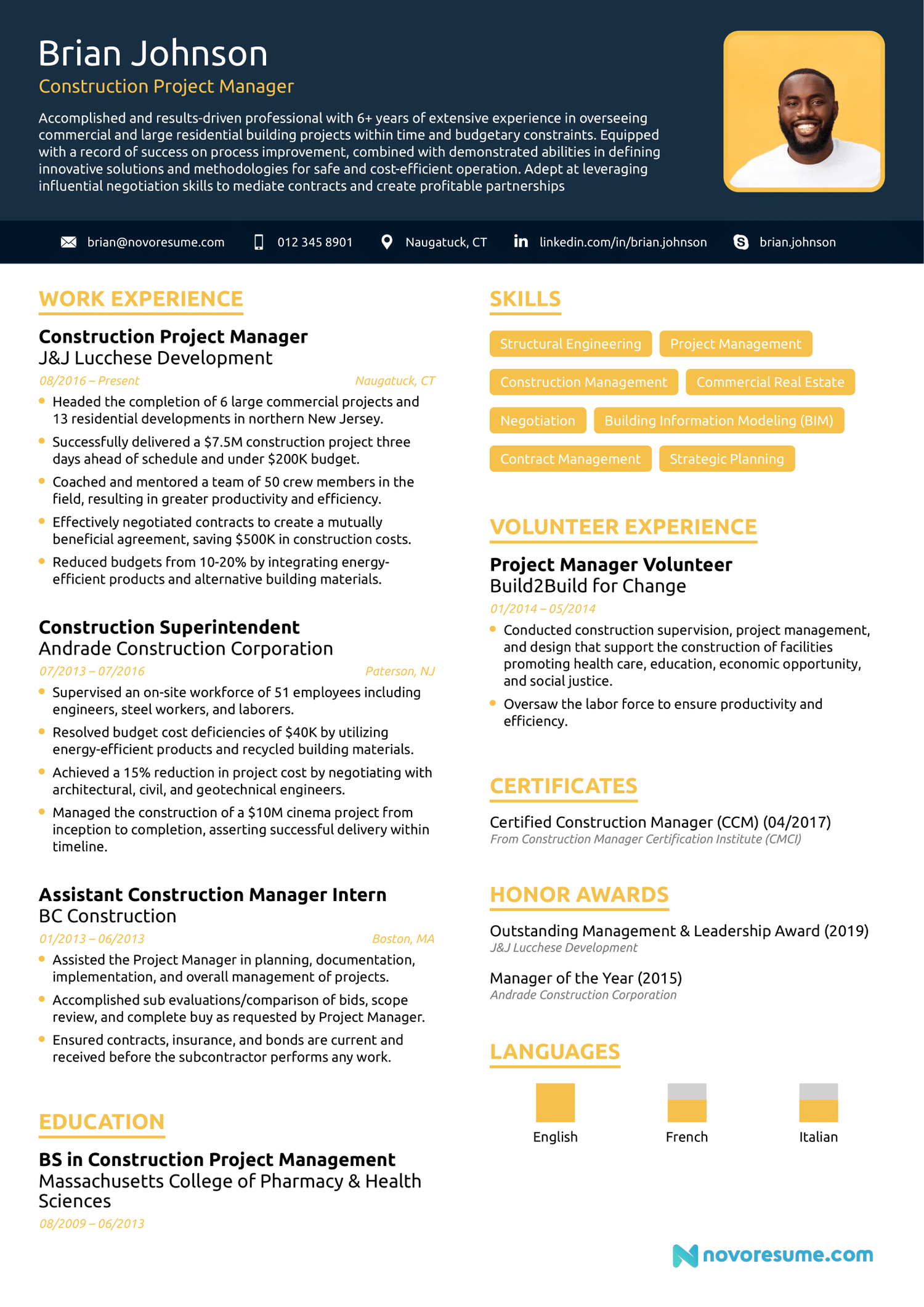
Check out our full guide to writing a construction project manager resume here.
#7. Customer Service Resume Example
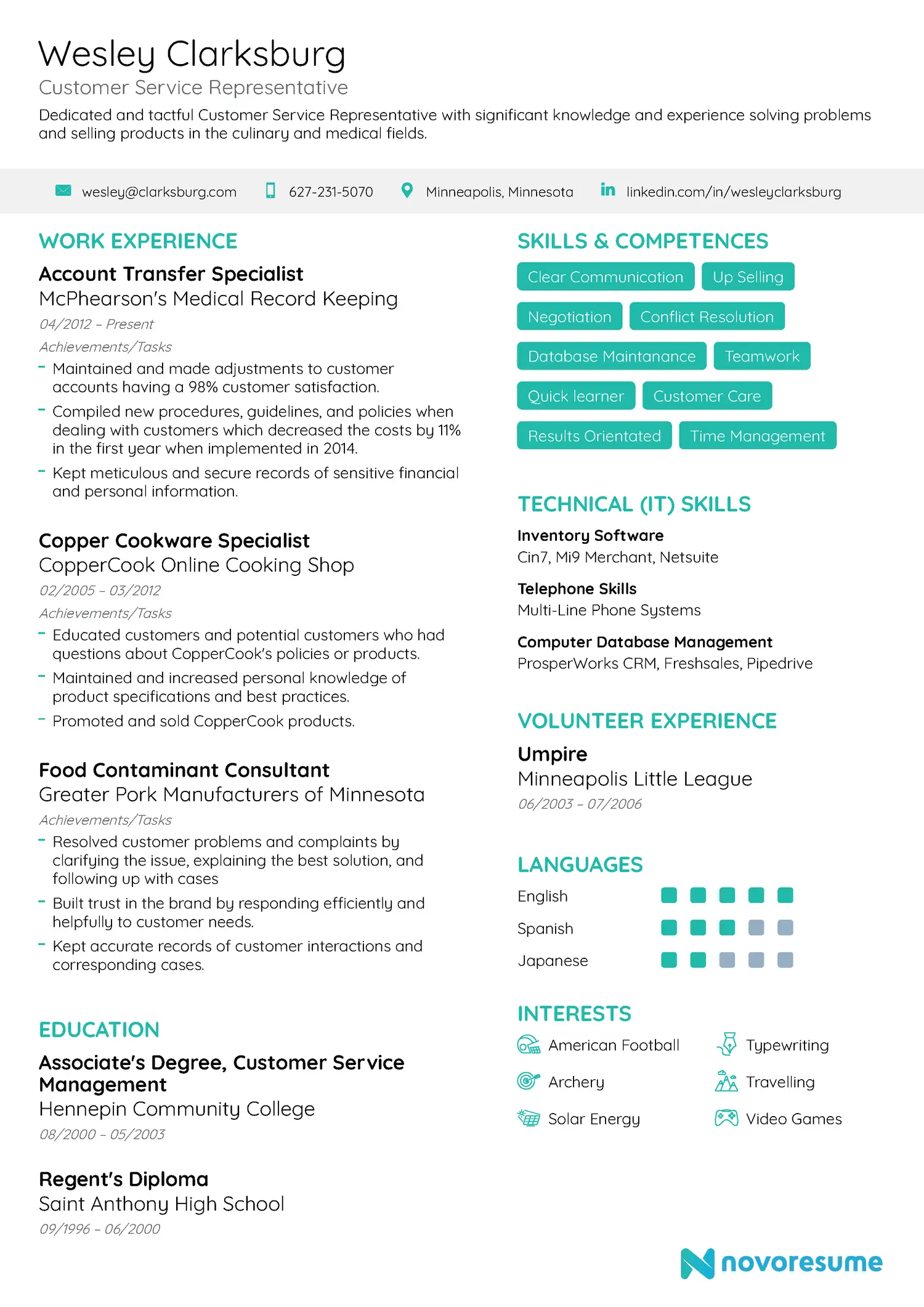
Check out our full guide to writing a customer service resume here.
#8. High School Resume Example
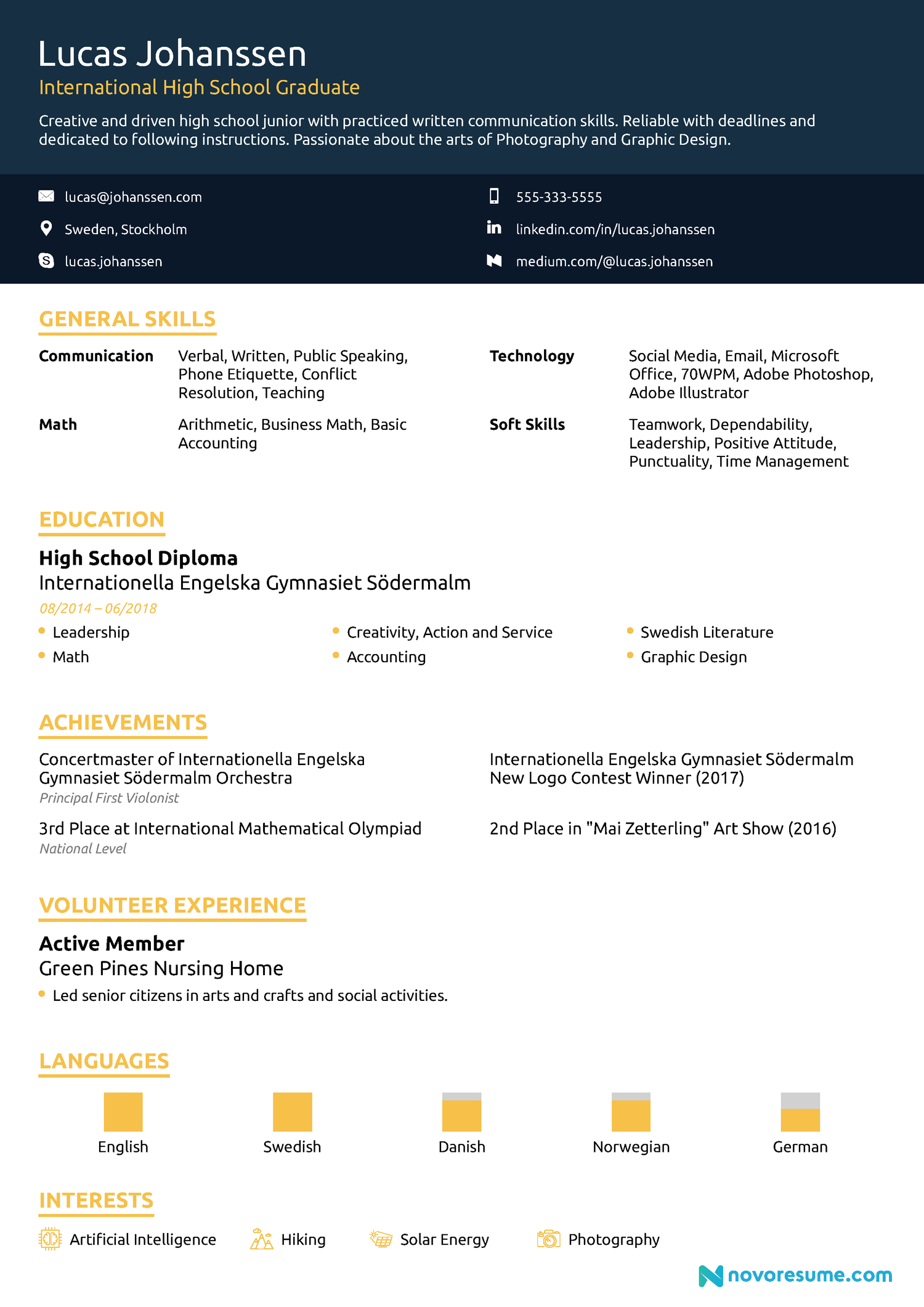
Check out our full guide to writing a high school resume here.
#9. Student Resume Example
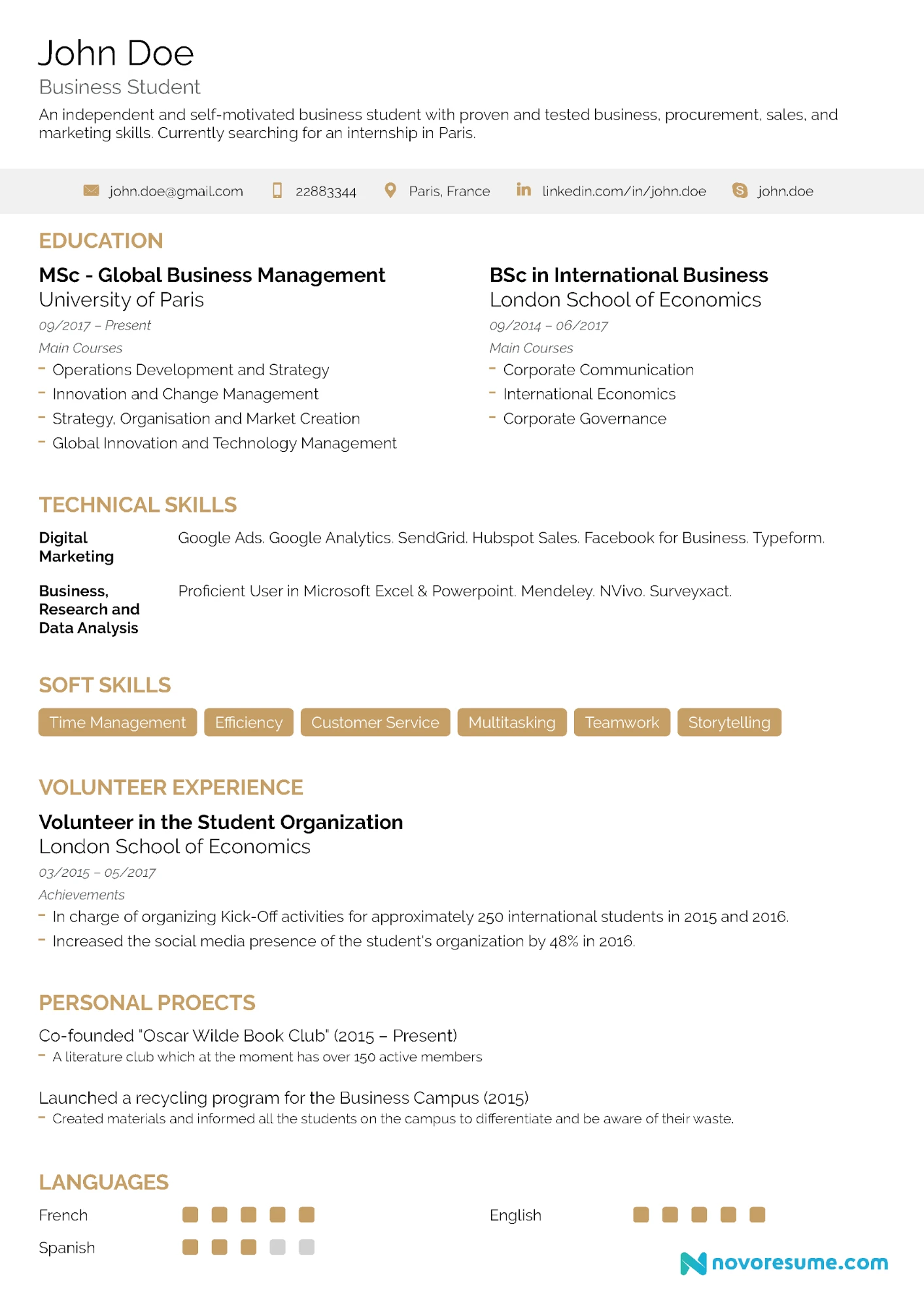
Check out our full guide to writing a student resume here.
#10. Server Resume Example
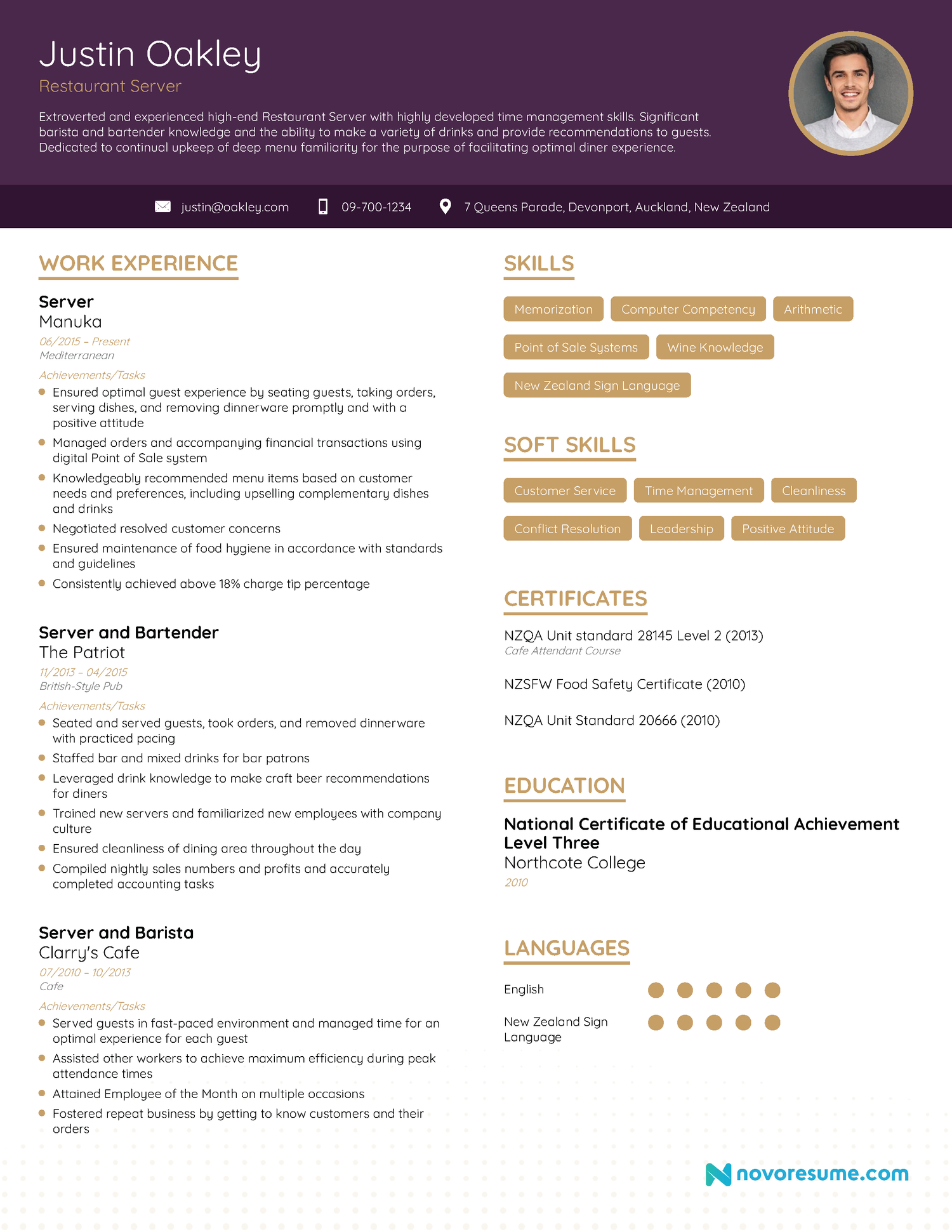
Check out our full guide to writing a server resume here.
#11. Actor Resume Example
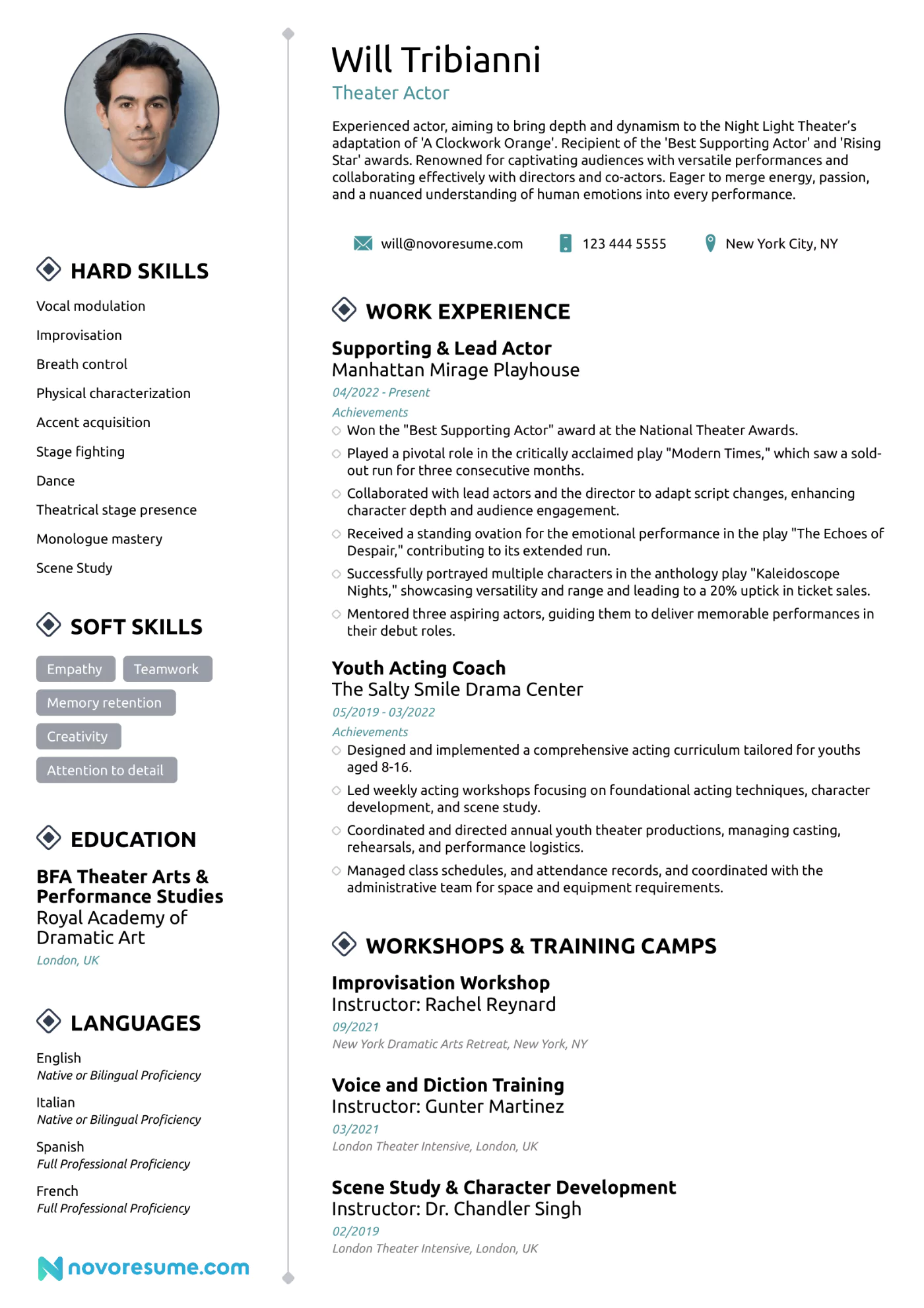
Check out our full guide to writing an actor resume here.
#12. Web Developer Resume Example
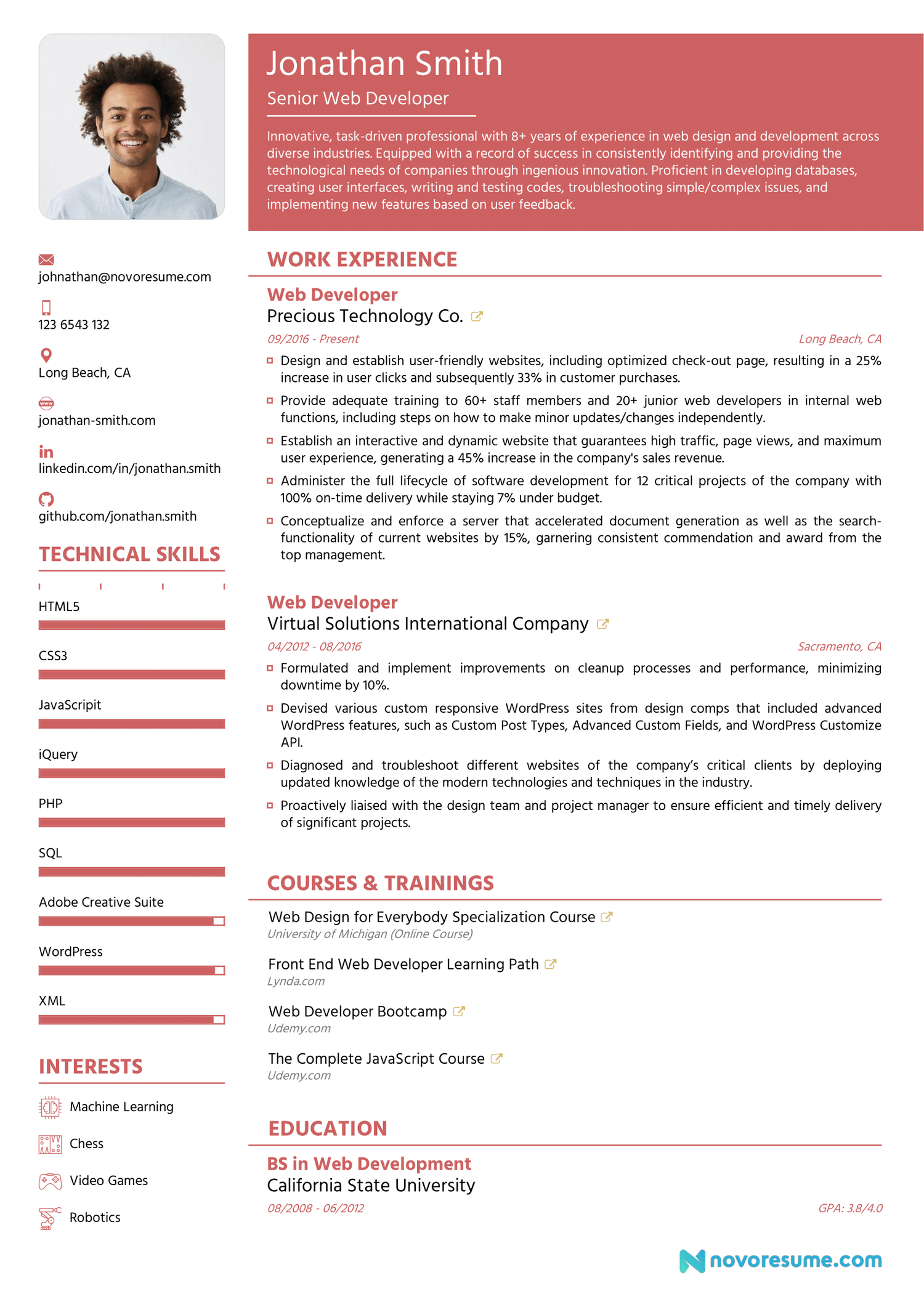
Check out our full guide to writing a web developer resume here.
#13. Engineering Resume Example
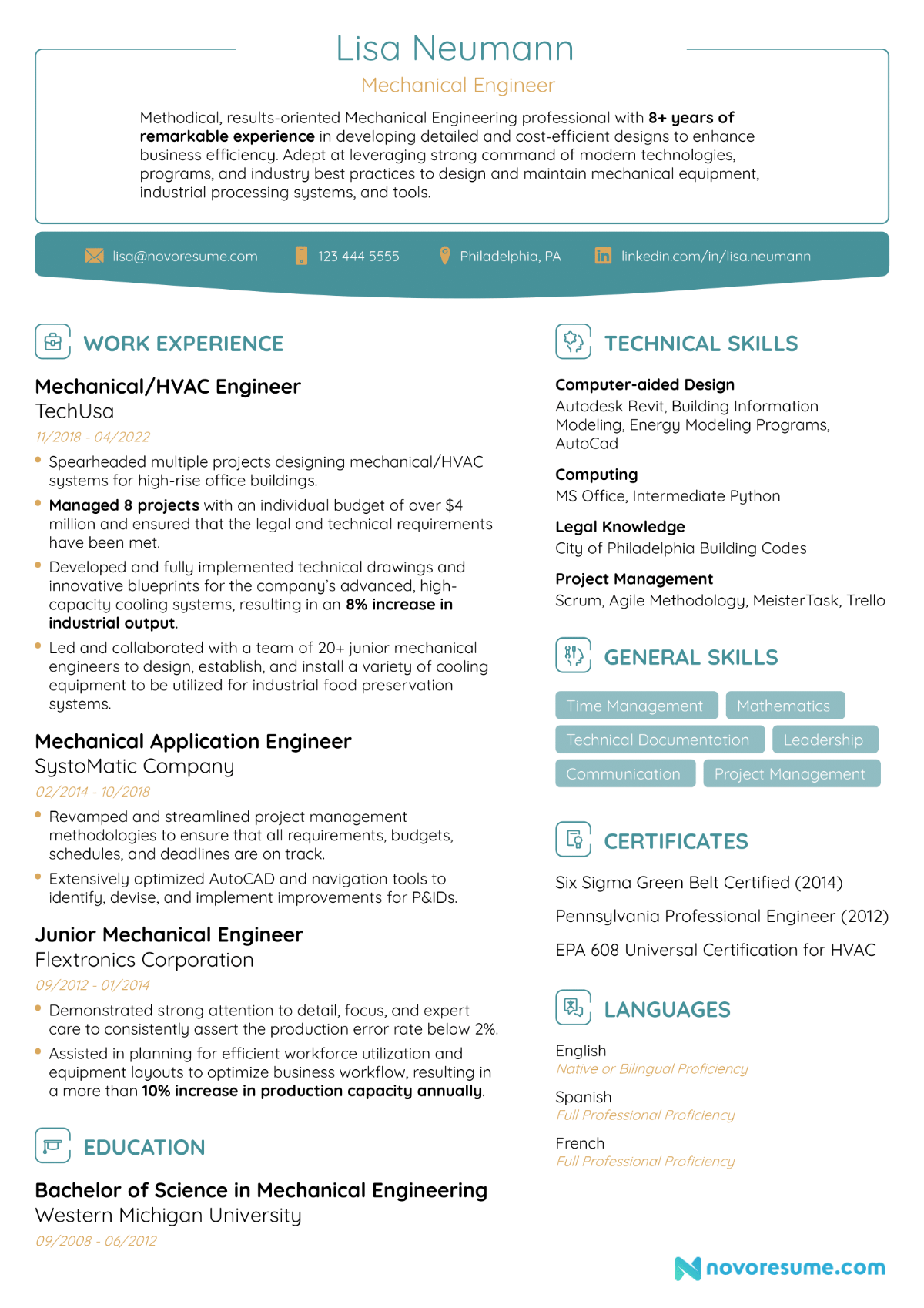
Check out our full guide to writing an engineering resume here.
#14. Computer Science Resume Example
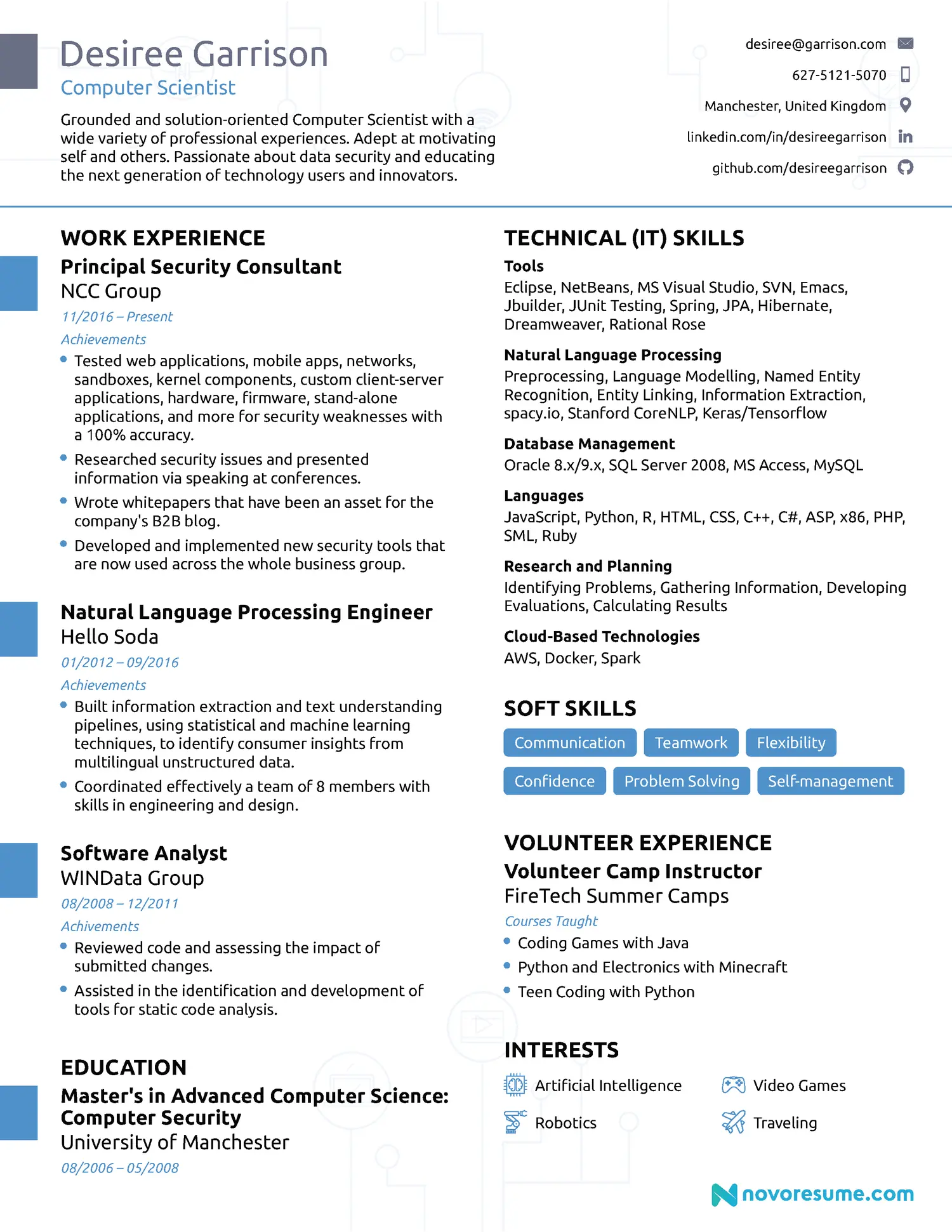
Check out our full guide to writing a computer science resume here.
#15. Architect Resume Example
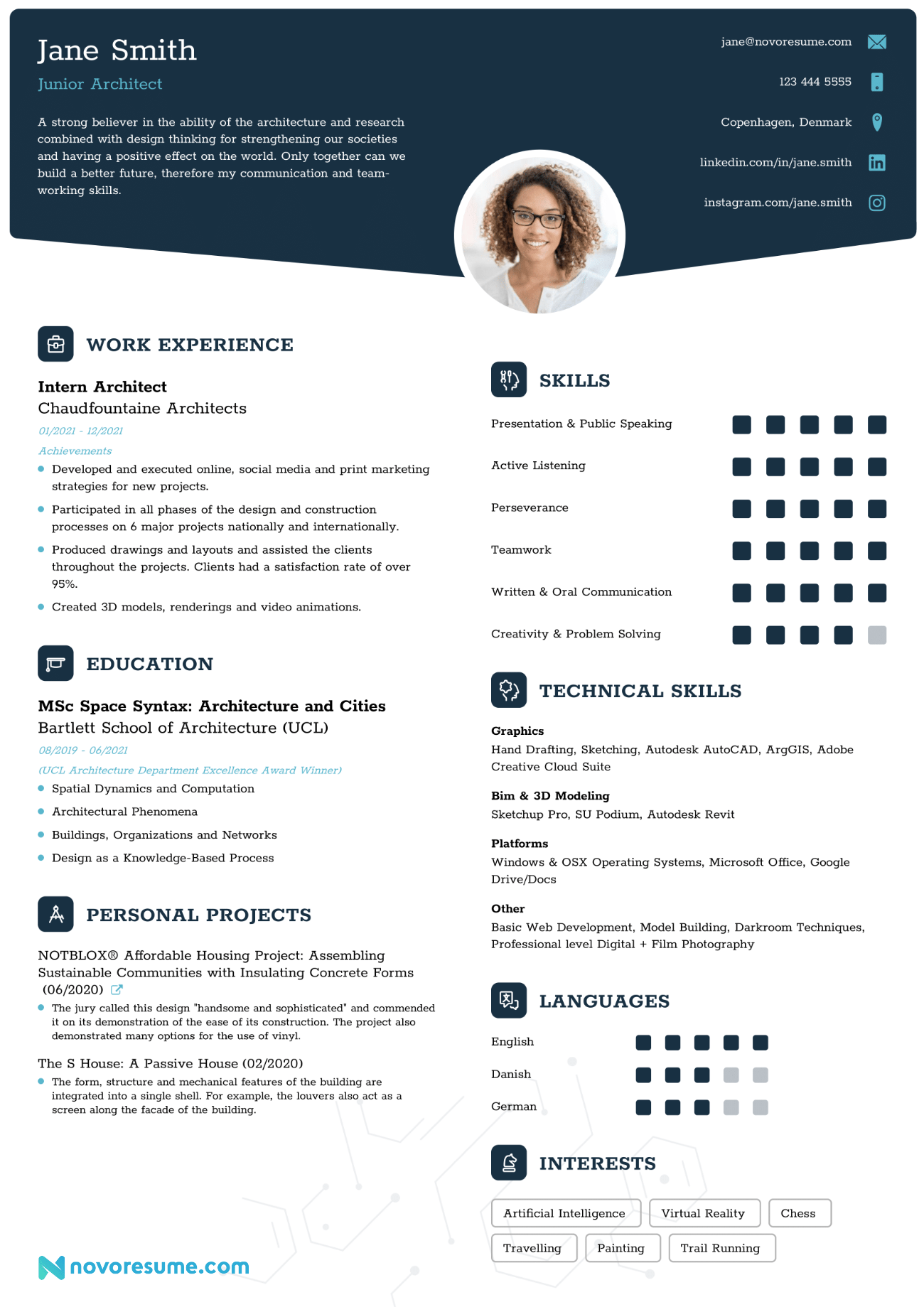
Check out our full guide to writing a data analyst resume here.
#17. Remote Job Resume Example
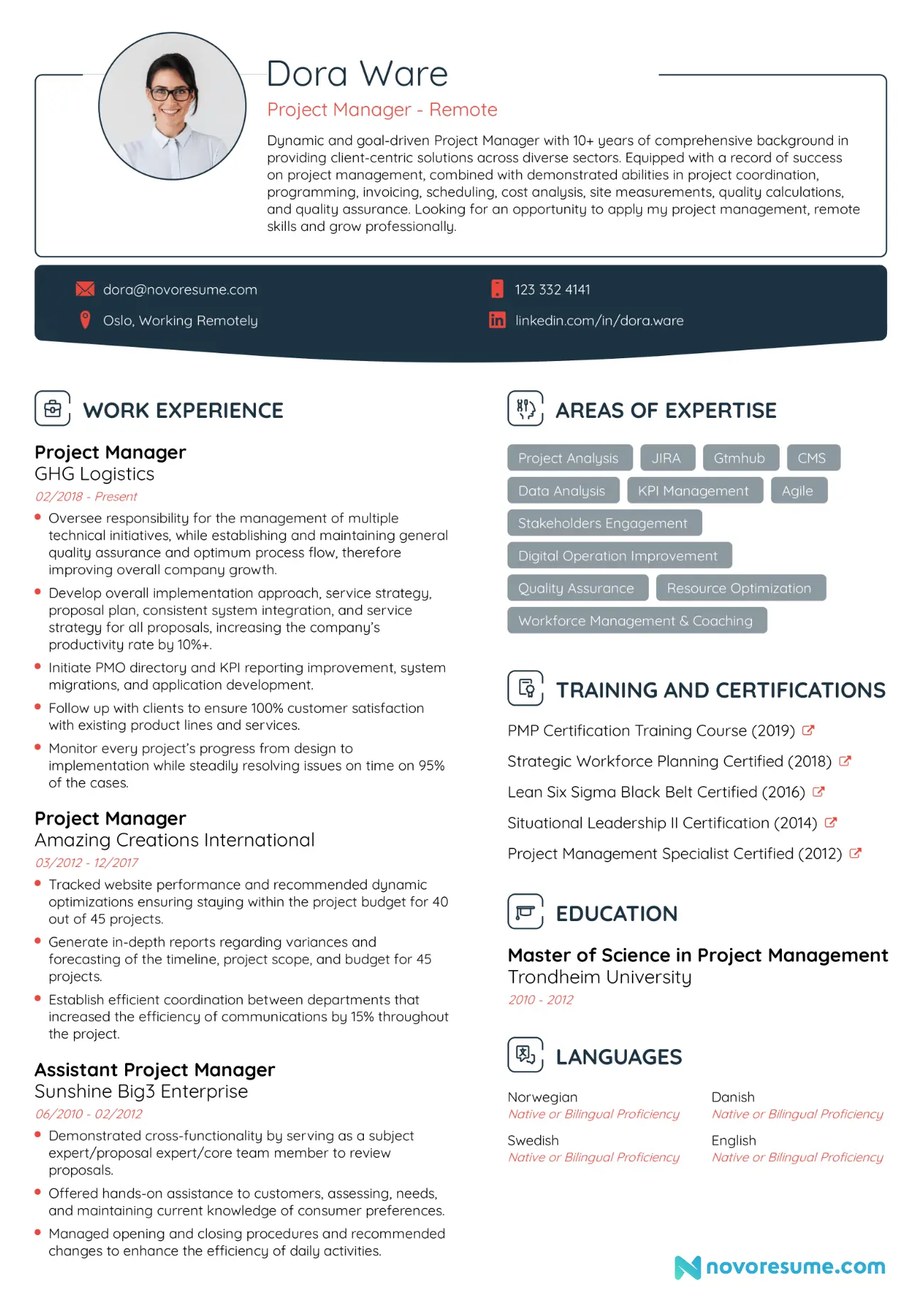
Check out our full guide to writing a remote job resume here.
#18. Sales Associate Resume Example
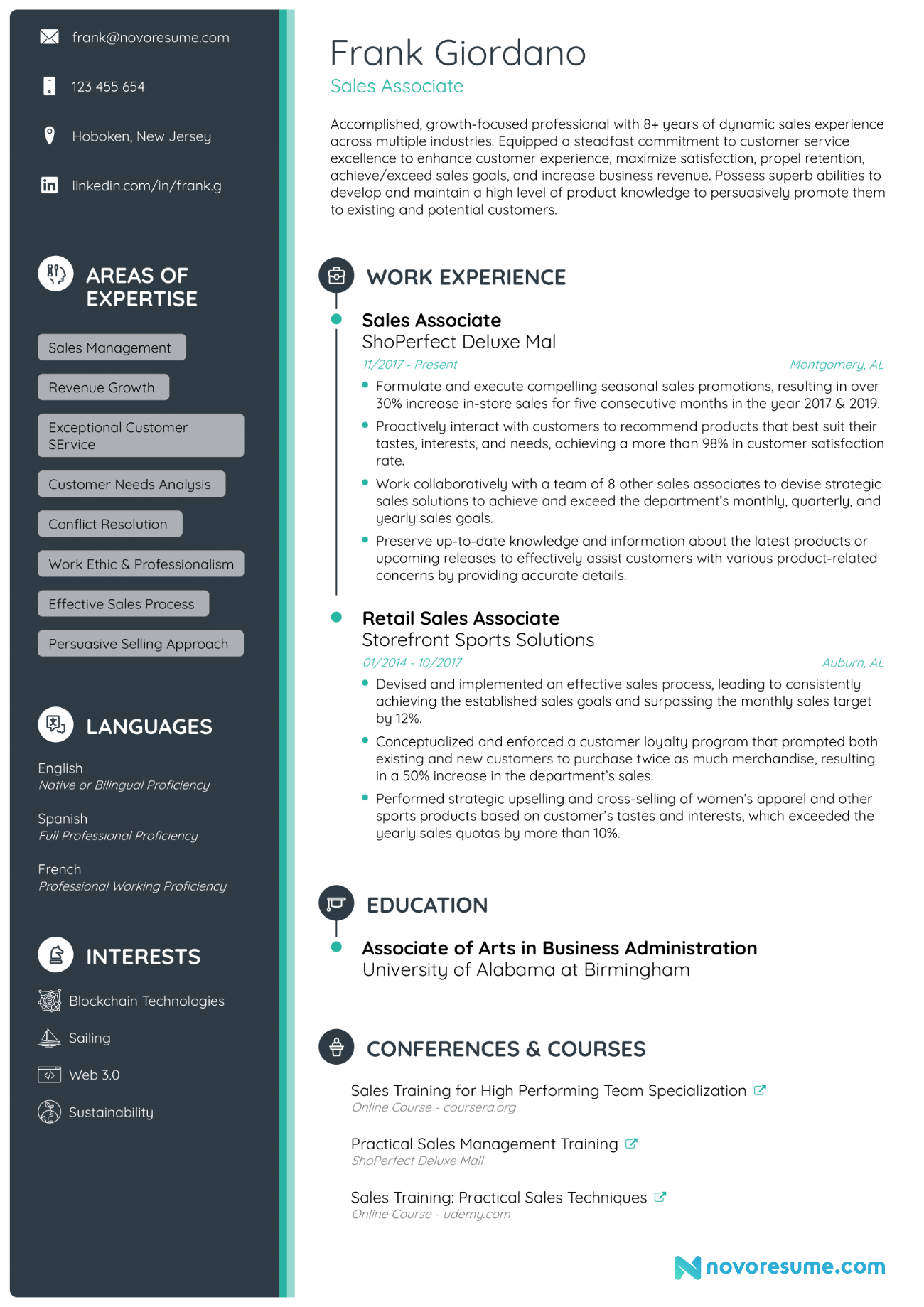
Check out our full guide to writing a sales associate resume here.
#19. Receptionist Resume Example
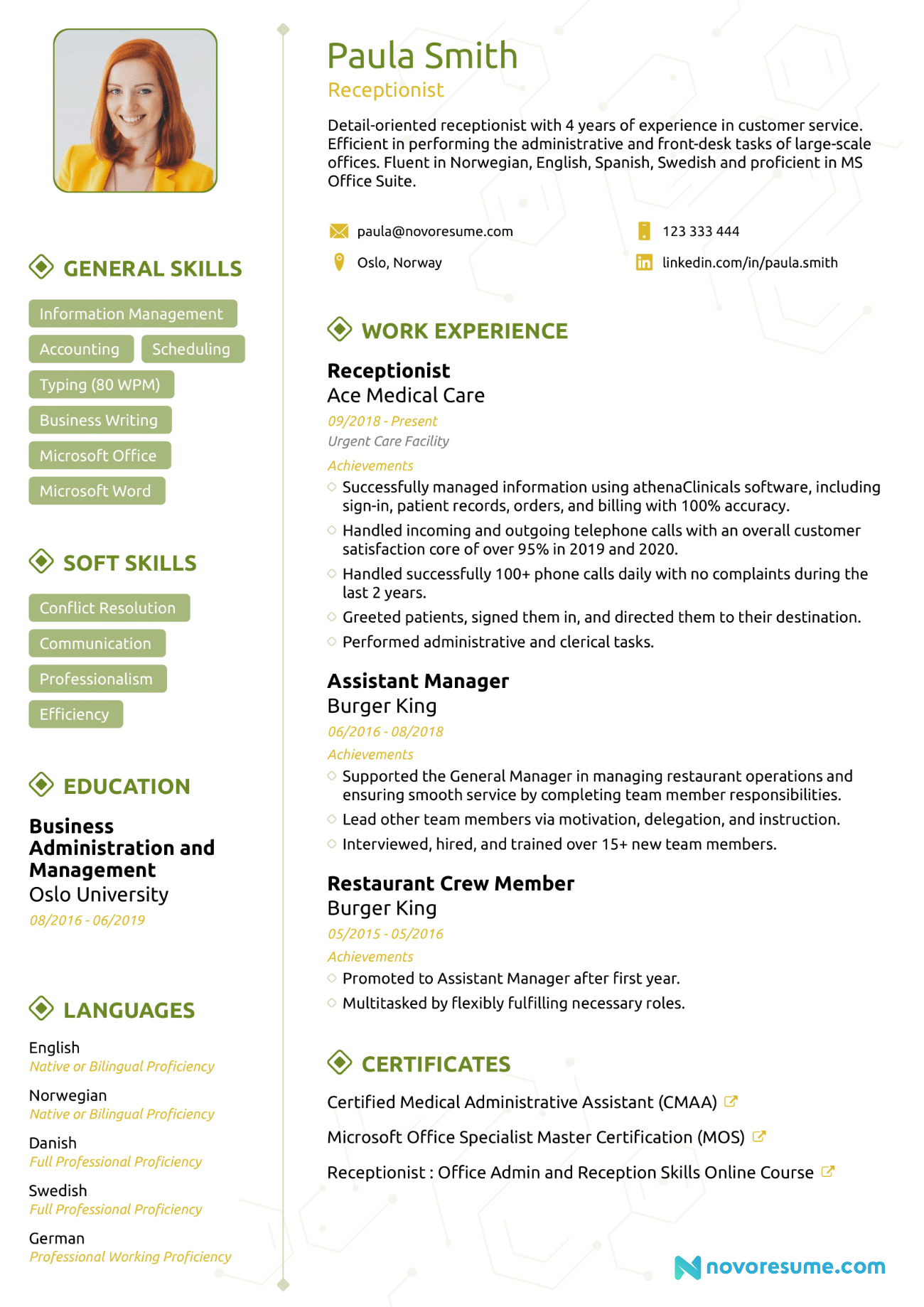
Check out our full guide to writing a receptionist resume here.
Want to see more examples? Check out our compilation of 80+ resume examples for different fields .
- Administrative Assistant Resume
- Bartender Resume
- DevOps Engineer Resume
- Executive Assistant Resume
- Flight Attendant Resume
- Graphic Designer Resume
- Paralegal Resume
- Pharmacist Resume
- Recruiter Resume
- Supervisor Resume
Next Steps After Your Resume
Now that we’ve covered everything you need to know about how to make a resume, it’s time to talk about the rest of your job application.
After all, your resume is only the first step in your job search. To land the job you deserve, you also need to write a captivating cover letter and ace that upcoming interview. Here’s how:
#1. How to Write a Convincing Cover Letter
The companion piece to every resume is the cover letter.
Most job-seekers flinch when they hear that they have to write a cover letter. What do you even mention in a cover letter, anyway? If you were good at writing cover letters, you’d be applying for a job as a writer !
In reality, though, writing a cover letter is very simple once you know its purpose.
Think of your cover letter as a direct message to the hiring manager. It’s your chance to briefly explain why you’re such an awesome fit for the position. And with a few cover letter tips to point you in the right direction, you’ll write the perfect cover letter for your job application.
Just follow this structure:
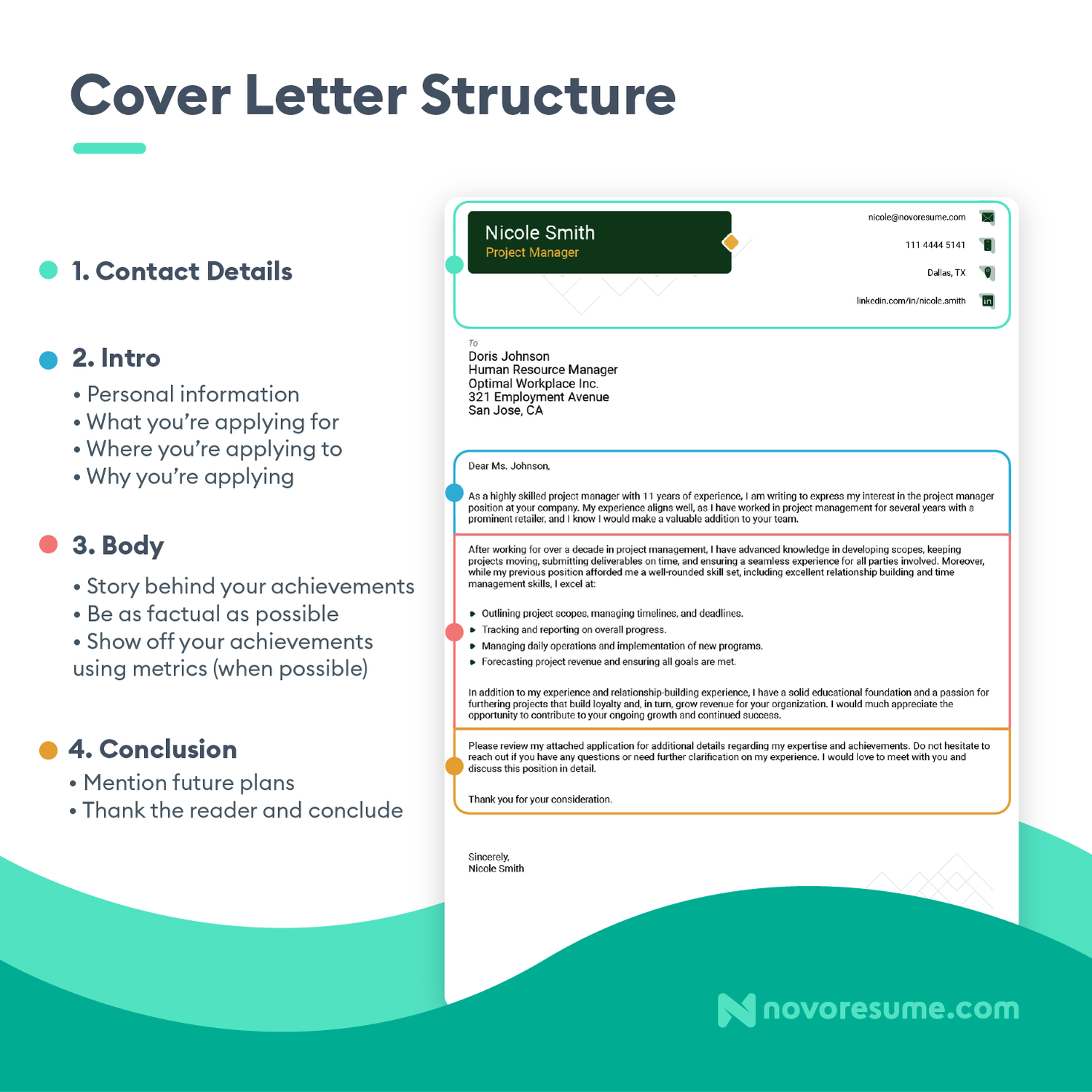
- Add the contact details. Include the same contact information as on your resume, plus additional contact details for the hiring manager, including their name, job title, the company’s name, and location.
- Introduce yourself. Start your cover letter by mentioning who you are, what your work experience is, and why you’re interested in the position. Mention a standout achievement or two, relevant skills, and what you’d like to do for the company you’re applying for.
- Explain why you’d excel at the job. Find the requirements in the job ad that you meet, and elaborate on how you fulfill the most important ones. Research the company so you know what you like about it, and mention it in your cover letter. Make sure to convey your enthusiasm for the job and confidence that you’ll be a great fit for their team.
- Wrap it up politely. Conclude your cover letter by recapping your key selling points and thanking the hiring manager for their time. Then add a call to action, such as “Please don’t hesitate to reach out to me at the provided phone number so that we can discuss my application in greater detail.” Then, add a closing line and follow it with your full name.
Sounds easy, right? Here’s a real-life example to drive the point home:
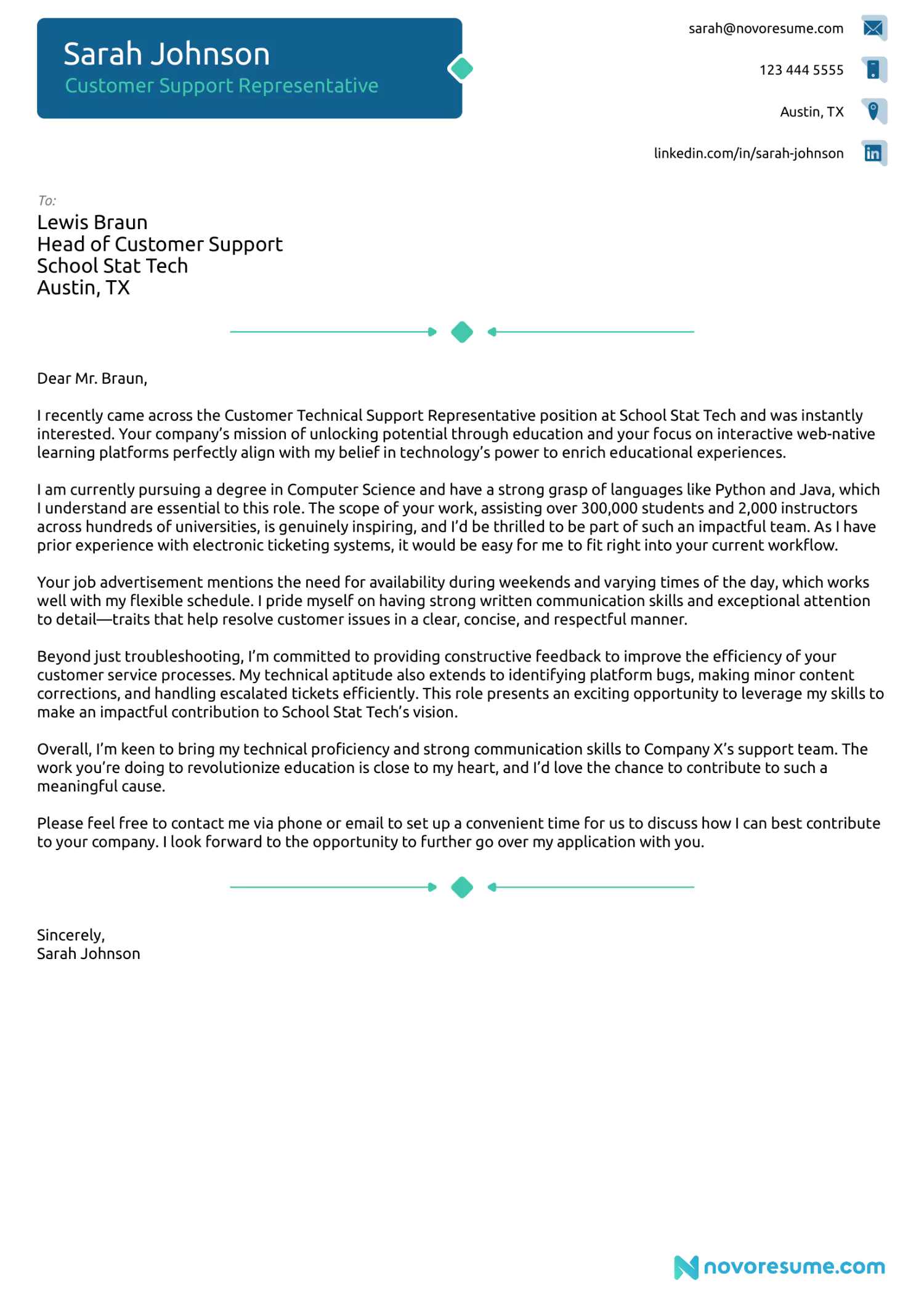
Do you need more help perfecting your cover letter? Learn what the most common cover letter mistakes are and check out cover letter examples for all professions here.
#2. How to Ace Your Next Interview
Once you’ve perfected both your resume and cover letter, there’s only one thing left.
It’s time for the final step—the dreaded job interview.
Whether you’re an extrovert or an introvert, you probably hate the interviewing process. No matter how experienced you are, it can be nerve-wracking. Sitting there while someone’s prodding into your past experiences and judging you isn’t fun.
But did you know that most interviewers ask the same questions?
That’s right—all you have to do is learn how to answer some of the most common interview questions, and you’ll be an interview away from landing your dream job!
Just check out our complete guide to the 35+ Job Interview Questions and Answers and learn how to ace your next interview.
FAQs on How to Make a Resume
Do you still have some questions about making a resume? Check out the answers to the most frequently asked questions below!
#1. What does a good resume look like in 2024?
For your resume to look good in 2024, make sure it’s organized and clean and isn’t longer than one page.
Be sure to include information that adds value to your application—leave out the focus on your relevant work experience and skills that you can back up, and list as many achievements as possible.
If you’re using a resume template, choose one based on your industry. Conservative industries like law, banking, and business require more traditional resume templates. But if you’re going for an industry like design, architecture, or marketing, you can go for a creative resume template .
Remote work is also big in 2024, so if that’s what you’re after, tailor your resume to match the job you want.
#2. How do you make a resume in Word?
The best way to create a resume in Word is to use a pre-designed Microsoft Word template. To access them, you should:
- Open MS Word
- Click “file” from the menu bar
- Select “new”
- Type “resume templates” in the search bar
That said, Word resume templates are generic, hard to personalize, and overall not very stylish.
Want a resume that looks good and is extremely easy to make? Check out resume templates to get started!
#3. How do I write a resume for my first job?
If you’re writing your first-ever resume for an entry-level position, the hiring manager won’t expect you to have any work experience.
However, you can make up for your lack of experience with your skills and academic achievements.
For example, you can take advantage of extracurricular activities, internships, volunteering experiences, and other non-professional experiences. You can use them to highlight the skills you’ve gained and what you’ve achieved so far.
So, your first job resume should have a resume objective, emphasize your education, and replace your work experience with any internships, volunteering, independent projects, or other experiences.
#4. How to make a resume on Google Docs?
You can make a resume on Google Docs by choosing one of their templates and filling it in on the go.
All you have to do is go to your Google Drive’s template gallery, choose your preferred template, fill in your information, and your Google Docs resume is ready to go!
That said, Google Docs templates aren’t the most user-friendly choice. You don’t have much flexibility with the layout and formatting isn’t that easy. For example, you tweak a section to the slightest, and the whole resume becomes a mess.
If you want an easier option, check out our resume builder !
#5. What kind of resume do employers prefer?
Typically, employers prefer one-page-long resumes that follow the reverse chronological format.
Hiring managers receive hundreds of resumes every day, so they don't have the time to read three-page resumes. Try one of our one-page resume templates so you don’t go over the recommended resume length.
Meanwhile, the reverse-chronological format is the most popular because it draws attention to your most recent jobs and professional achievements, which is the #1 most important thing hiring managers look at when evaluating a resume.
#6. How many jobs should you put on your resume?
You should only include relevant job positions on your resume.
This means that your work experience section should be tailored to the job you are applying for. If you’ve worked five different jobs and they can all add value to your current application, then you should include all five.
If, on the other hand, you’re applying for, say, a customer service position and some of your past jobs don’t have anything to do with customer service, you should skip them.
#7. Should I put my address on my resume?
You can put your location (city, state, or country) on your resume, but you don’t need to put your entire physical address.
Putting a physical address on a resume was the norm back when companies would contact you via mail. In today’s world, everyone communicates via email, which is why adding a correct and professional email address to your contact information section is far more important than putting your physical address.
So, just include your location or-–if you’re a remote worker—specify you prefer to work remotely by writing “working remotely from [location].”
#8. What information should I leave out of my resume?
As a general rule, you shouldn’t include your birthday or your headshot on your resume. This norm varies from country to country but it applies to the USA, Canada, and UK.
If you have plenty of achievements to list under your work experience, then you can leave your basic work responsibilities out of your resume.
In your education section, you should only include your highest and most recent degree. So, if you hold a Ph.D., you can list that and your Master’s degree and leave your Bachelor’s degree and high school diploma out.
Finally, leave out any skills that aren’t relevant to the job you’re applying for.
#9. Is a resume a CV?
Depending on where you are, a CV (Curriculum Vitae) and a resume might be completely different things.
In most of the world, though, including Europe and Asia, they are used interchangeably for the same document. Both CVs and resumes are one to two pages long, and list skills and experiences relevant to the position you’re applying for.
Sometimes more detailed resumes that go over one page are referred to as CVs. These are typically only used by senior professionals, executives, CEOs, etc.
In the USA, however, a CV is a completely different document. Typically, CVs are detailed and comprehensive documents that highlight your entire academic and professional history. They’re often used for academic, scientific, or research positions, which is why this type of CV can also be referred to as an academic CV.
You can create your CV using one of our CV templates !
#10. Should I write my own resume?
Yes, you should always write your own resume.
Your resume is your opportunity to show the hiring manager your communication, writing, and presentation skills . Employers also evaluate you based on how effectively you can convey information about yourself, and there’s no one that can represent you better than yourself.
Writing your own resume lets you introduce yourself authentically. You have the best understanding of your skills and experiences, and you can personalize them to make your resume stand out.
And, as a bonus, the experience of writing your resume yourself can be reflective and insightful, so it might help you understand your professional journey and career goals better.
#11. Can a resume be two pages?
Generally, we strongly recommend that your resume stick to one page.
Hiring managers go through hundreds of resumes every day, and keeping your resume to one page increases the odds that they’ll see your qualifications faster.
In some cases, like when you have a lot of relevant experience, your resume can go over two pages. But this exception is reserved for senior professionals with over a decade of relevant experience and tons of skills and achievements that simply can’t fit on one page.
#12. Is a simple resume okay?
Absolutely, a simple resume is often more than okay—it's preferable.
Before your resume even gets to the hiring manager, a complicated layout could get it rejected by the applicant tracking system (ATS). A simple resume template can help get your application straight to the hiring manager.
A clean layout can also make sure that your resume is easily readable and looks professional. This can focus the hiring manager's attention on your work experience and skills without excessive clutter or flashy colors to distract them.
Key Takeaways
And that’s a wrap!
If you’ve followed all of our advice until now, congrats! You’re probably an expert on how to make a resume.
To recap, let’s go through some of the most important lessons we’ve learned so far...
- Use the right resume builder to make the process as smooth as possible. You don’t want to mess around with formatting for hours before even starting to work on your resume!
- Focus on your achievements over responsibilities. This can help you stand out from all the other applicants, especially if you back your claims up with data.
- Include all the must-have sections, like the resume summary, work experience, education, and skills. Then leverage optional sections if you have leftover space.
- Tailor your resume for the job you’re applying for. Everything listed on your resume should be relevant to the specific job you’re applying for, and you should write a new resume for every new job application.
- Take the time to perfect your cover letter. It’s just as important as your resume, so make sure you pay as much attention to it!

To provide a safer experience, the best content and great communication, we use cookies. Learn how we use them for non-authenticated users.

IMAGES
COMMENTS
Step 1: Launch Pages from Applications. Open the Apple Pages app located in your Applications folder. You will be greeted with the following window. If you don't see this window, go to your top menu bar and select File > New… (or use the shortcut Cmd+N). At the left sidebar, navigate to the Stationery tab, scroll down to the Resume section ...
Learn how to format and create a resume in Page on MacOS High Sierra.Subscribe: https://youtube.com/c/chasecarringtonTwitter: https://twitter.com/ChaseTheSon...
Open Pages. Create a New Document. Scroll down to the "Resumes" section and select the resume type you wish to create (we chose Classic Resume for this example) Fill out the resume with your information, including name, job position and experience information, education information, the standard resume fair. Once finished creating the ...
Watch former Apple Creative use a template in pages to create a resume.Also, how to restore old items in your resume if they were deleted.ApplePodcasts: http...
9 free Apple resume templates for Pages. Here are ten free Mac resume templates you can find in the Pages app: 1. Classic Resume. Download This Free Template. This is your standard minimalist resume template. The Classic template has a clean, straightforward layout that gets the job done.
Download free resume templates. Land your dream job with free, customizable resume templates. Showcase your potential to recruiters and stand out from other candidates with a professional template. Whether you're applying to corporate positions or creative roles, go with a sleek design or show your creativity with bold colors.
A one-page resume can make all the difference in getting noticed and landing an interview. This guide will equip you with the knowledge and skills on how to use AI to create a resume that showcases your unique strengths and achievements. Resumonk's AI Resume Builder can make this task a lot easier.
1. List your contact information. Put your name, job title and contact information at the top of your resume. This is true for resumes generally, but it is especially important for one page resumes. You want to be sure the hiring manager knows where to send an interview invitation. To save space, format your name and job title in bold and only ...
Using Pages to create a resume - Apple Community. macOS / Earlier Operating Systems. You can make a difference in the Apple Support Community! When you sign up with your Apple ID, you can provide valuable feedback to other community members by upvoting helpful replies and User Tips. macOS Sequoia is now available. Join the conversation >.
Set the correct font size. As a rule of thumb, go for 11-12 pt for normal text and 14-16 pt for section titles. Use a PDF file. Always save your resume as a PDF file, unless the employer specifically requests otherwise. Word files are popular, but there's a good chance they'll mess up your resume's formatting.